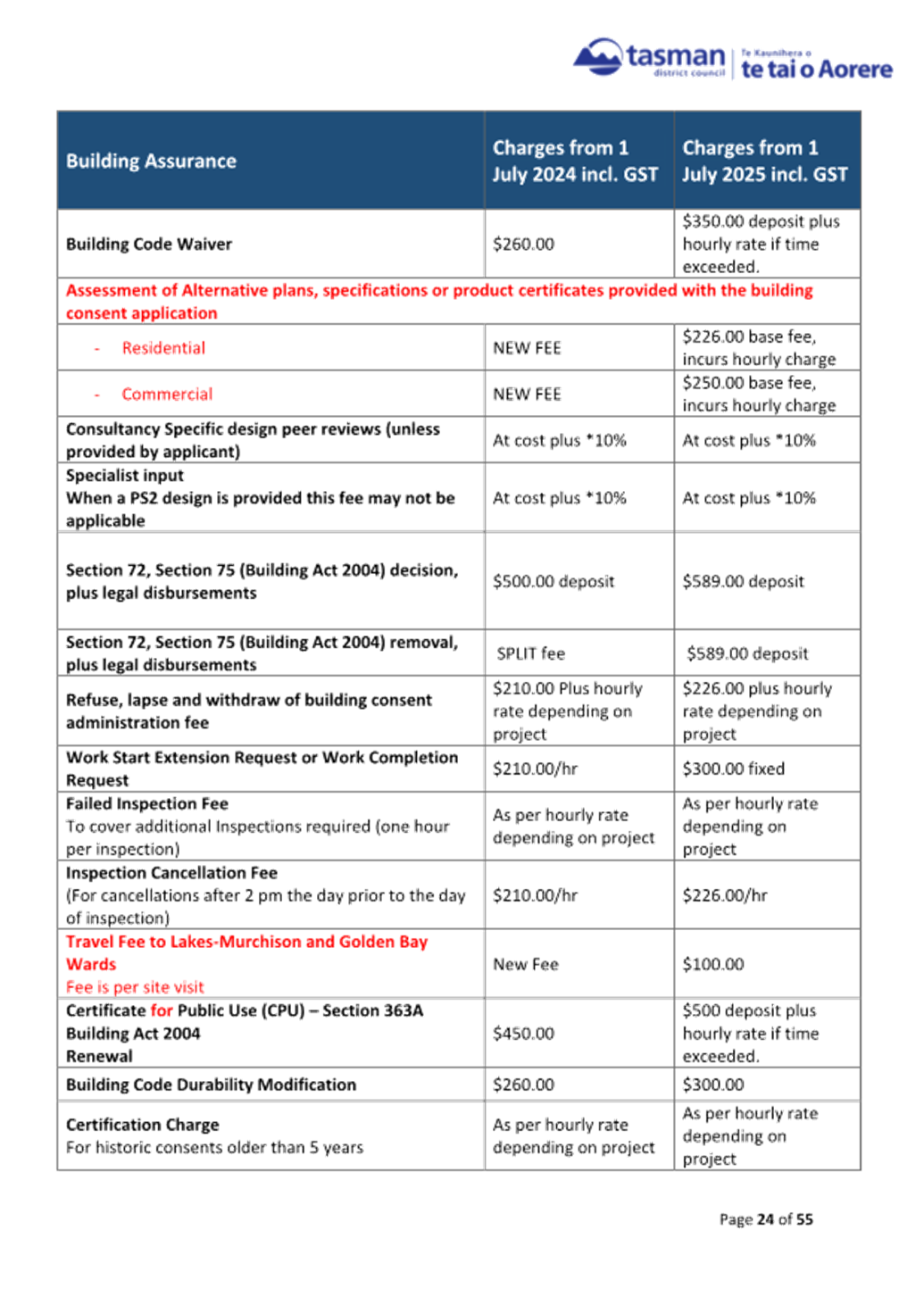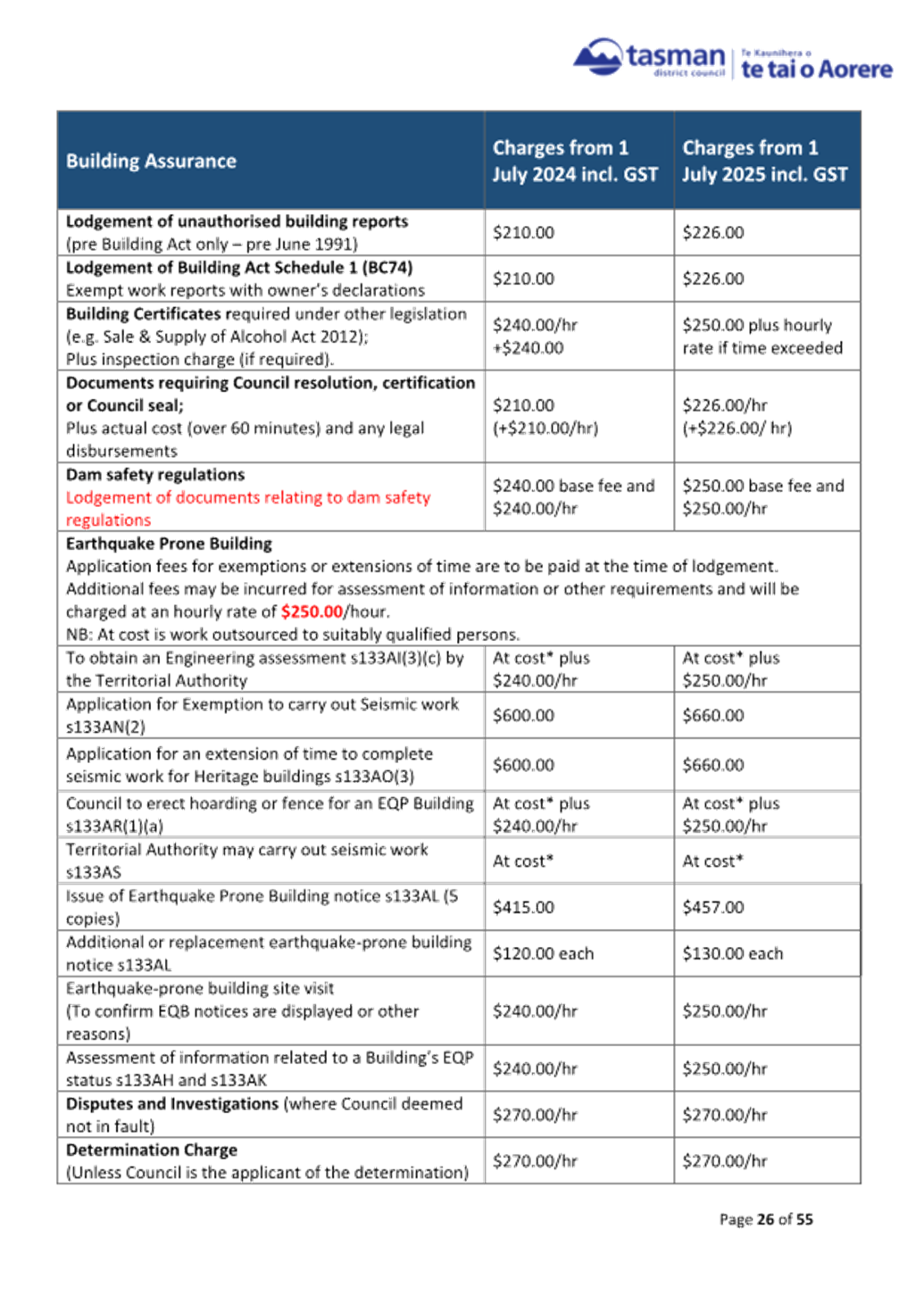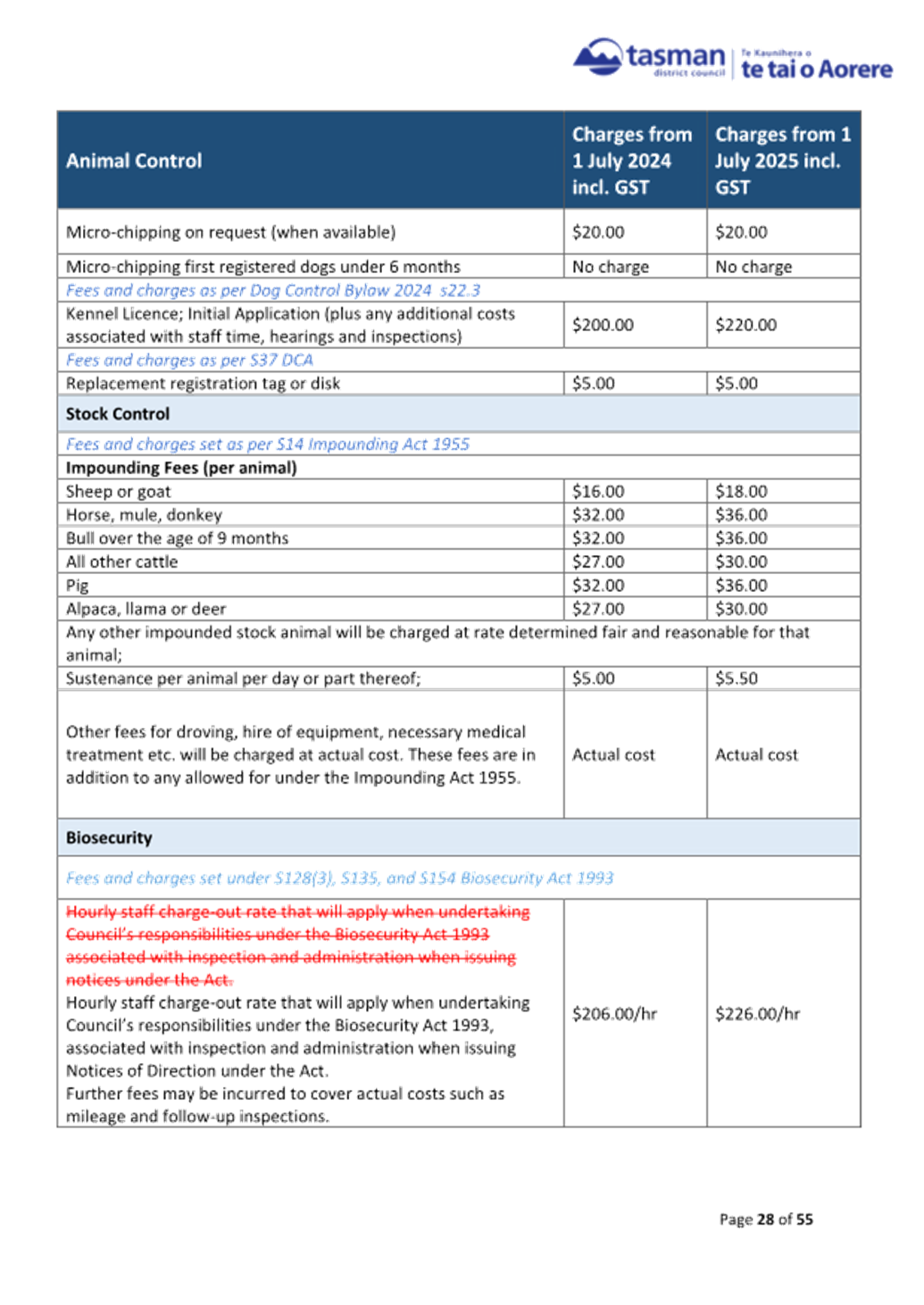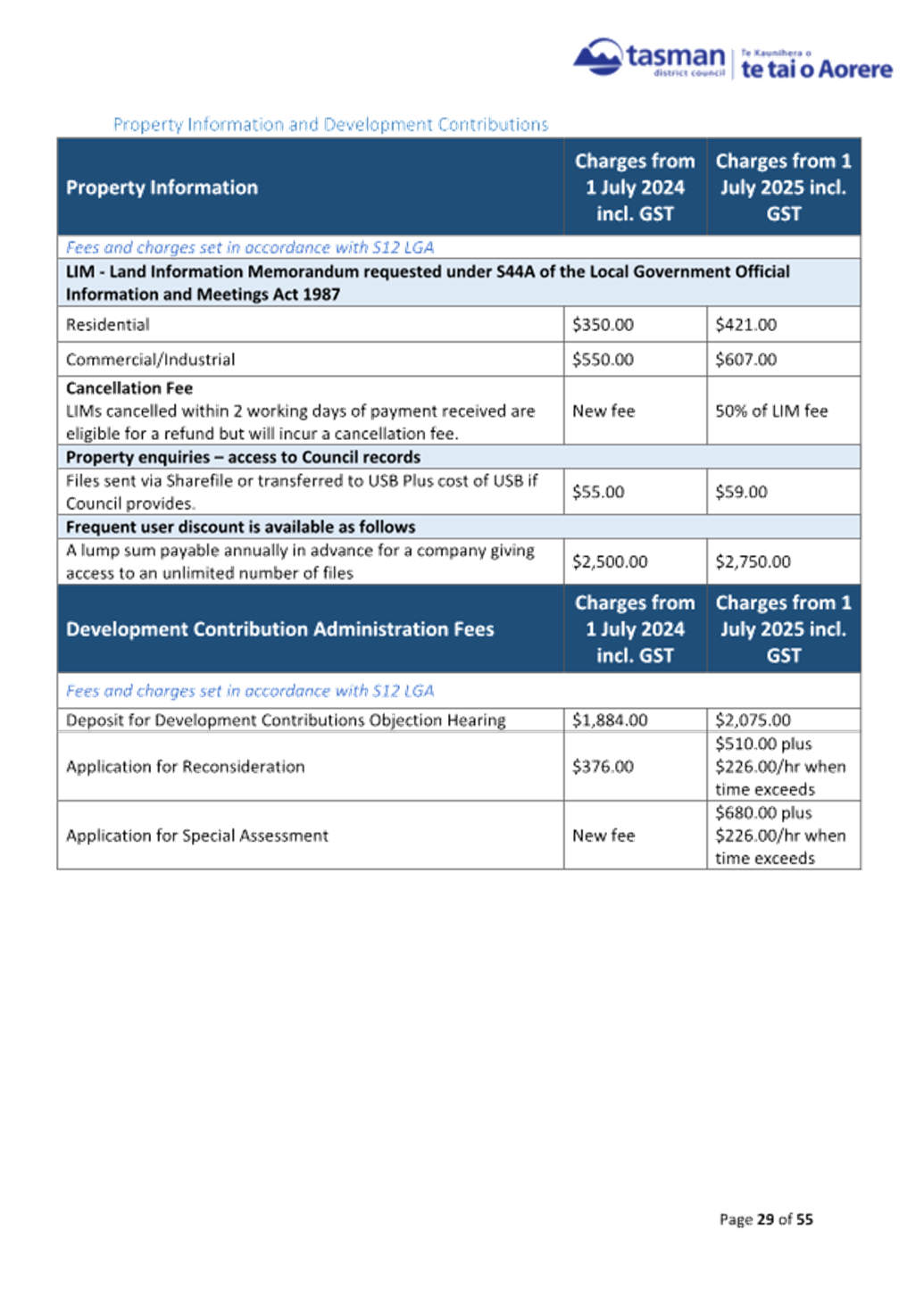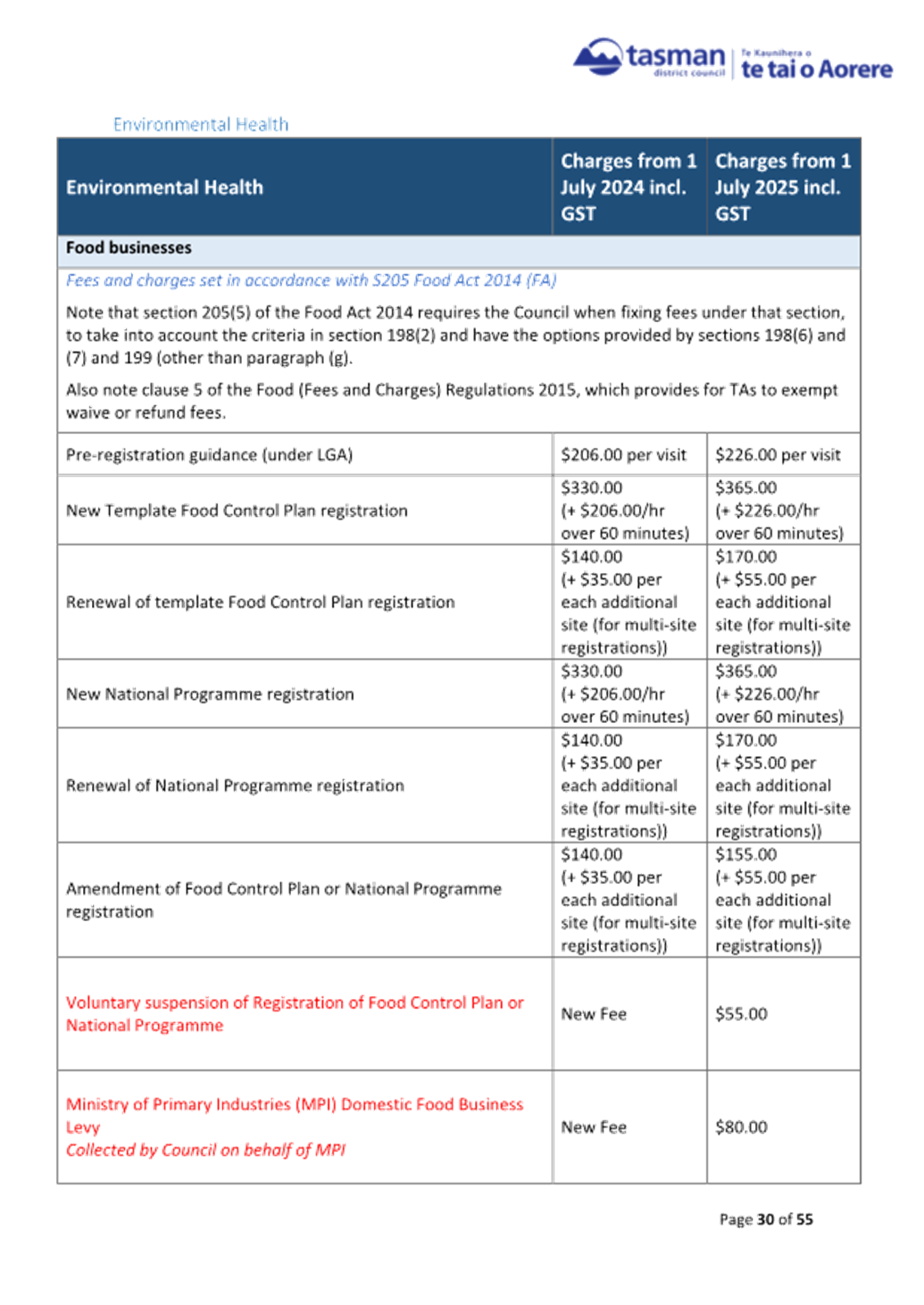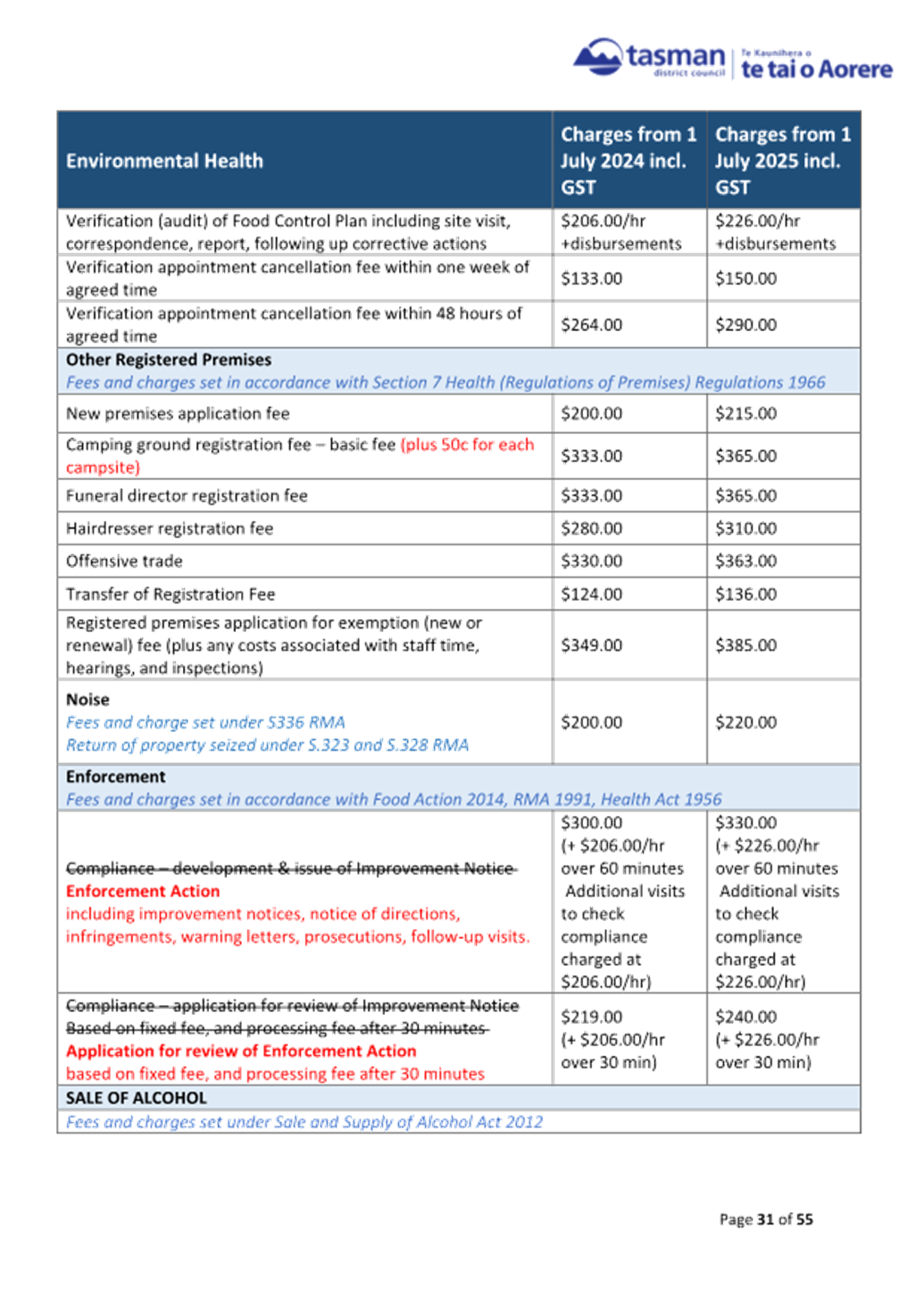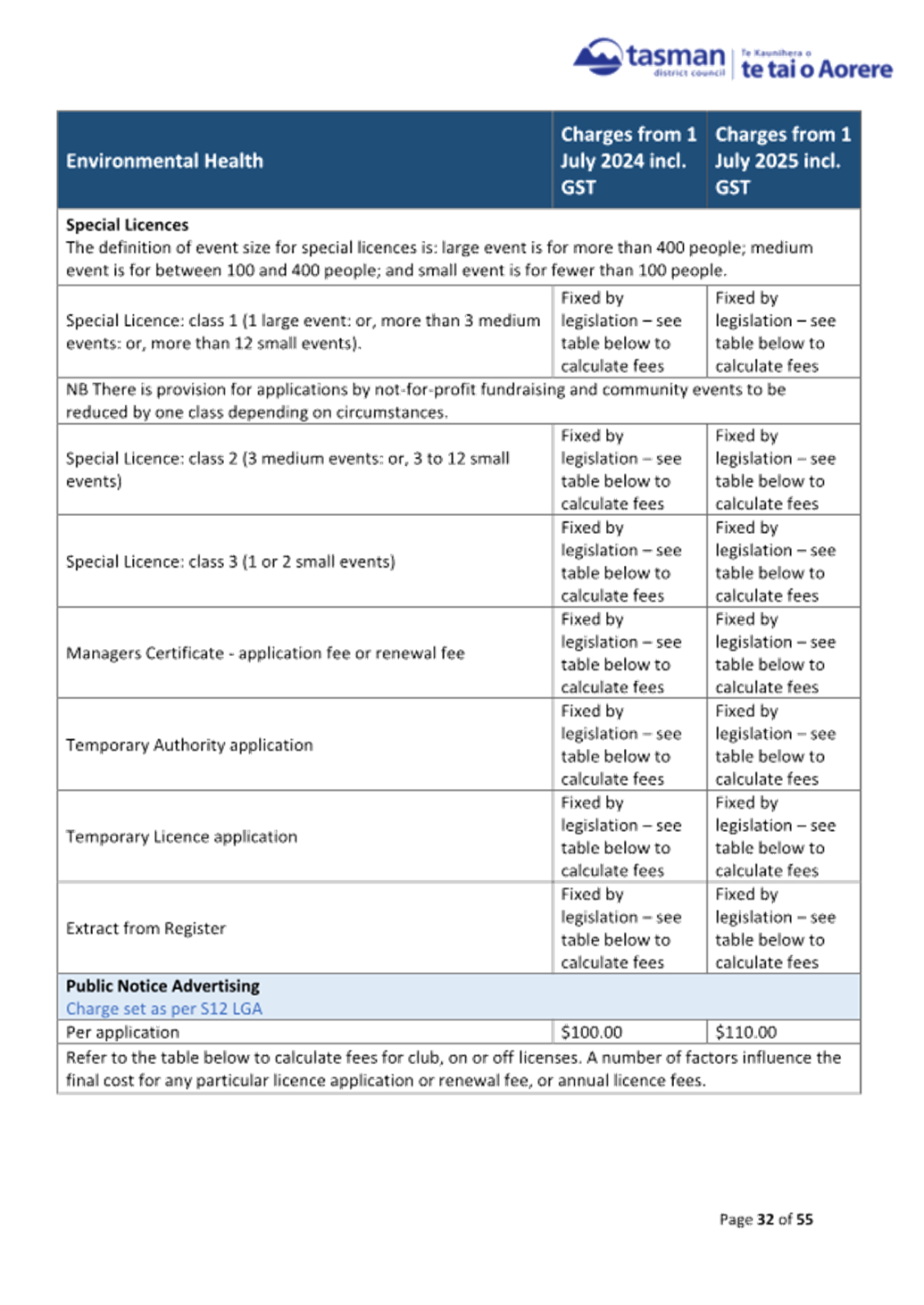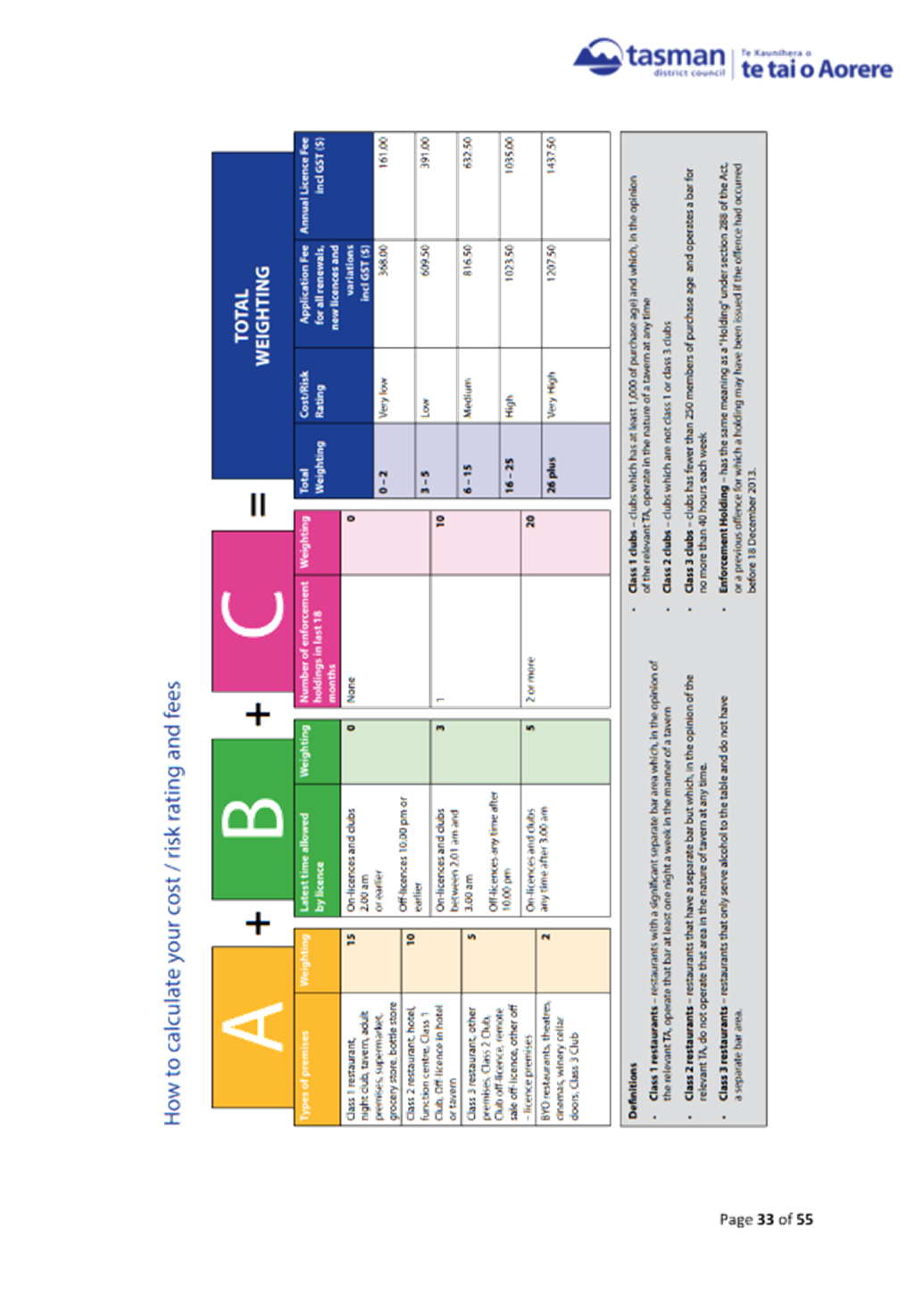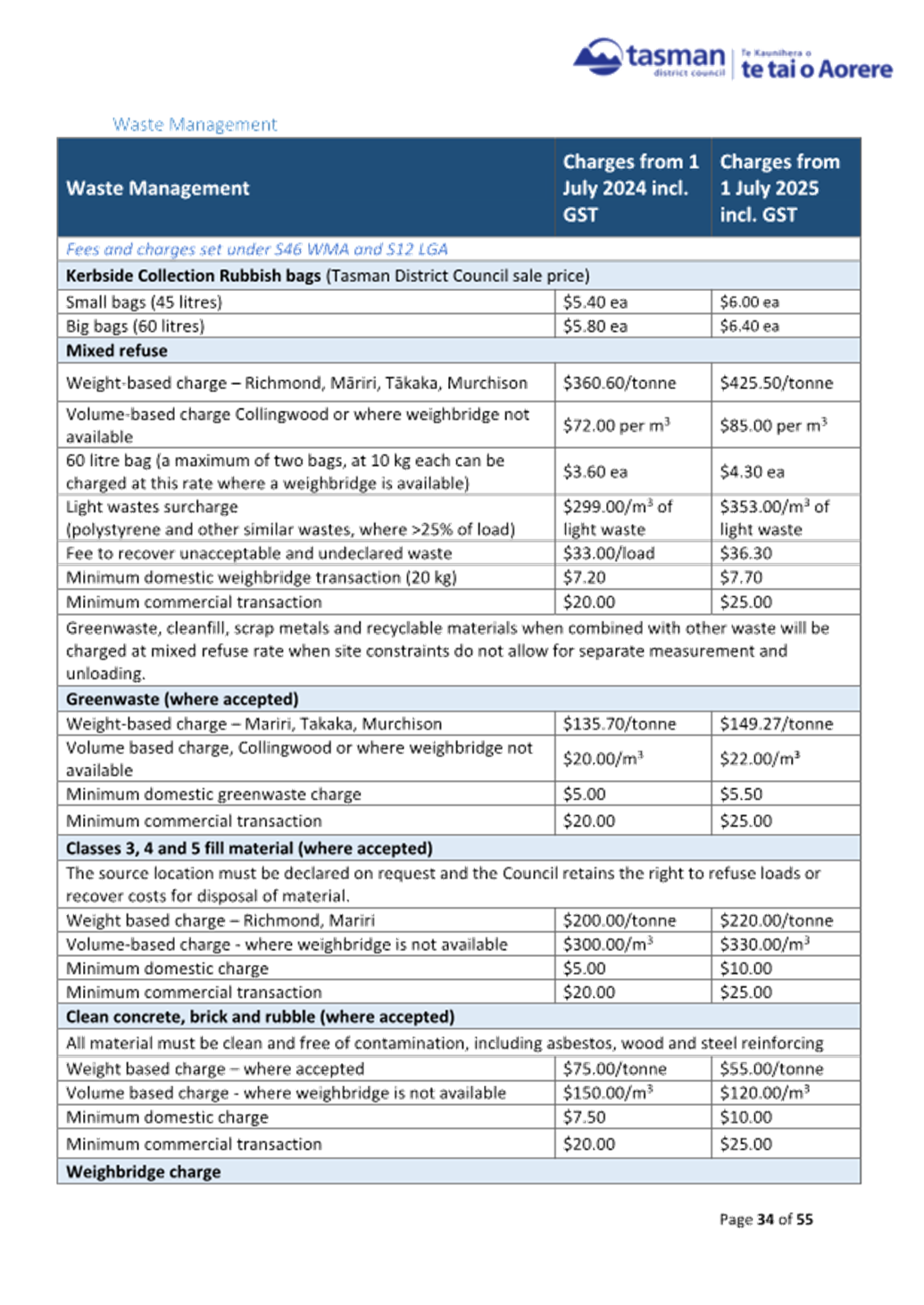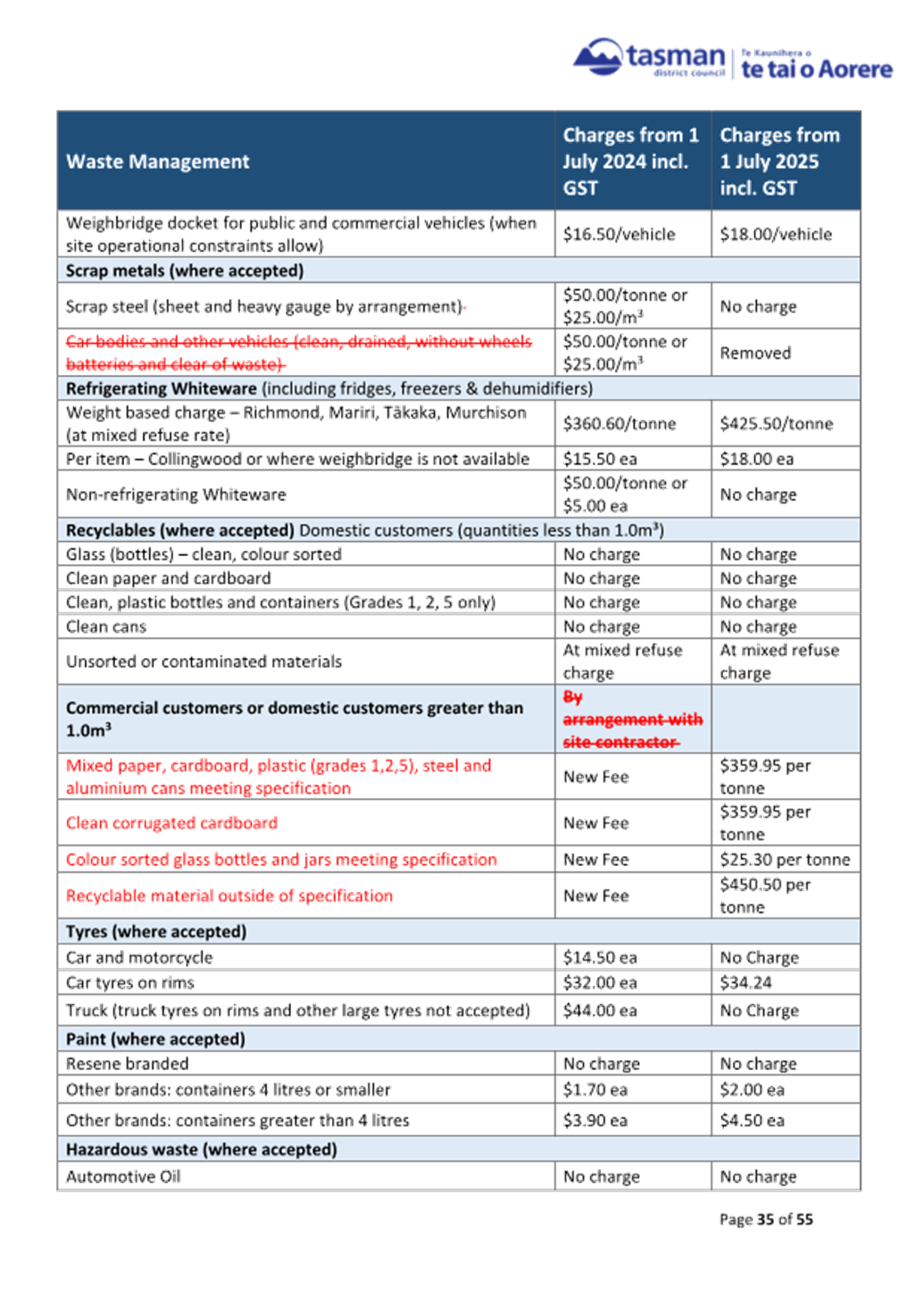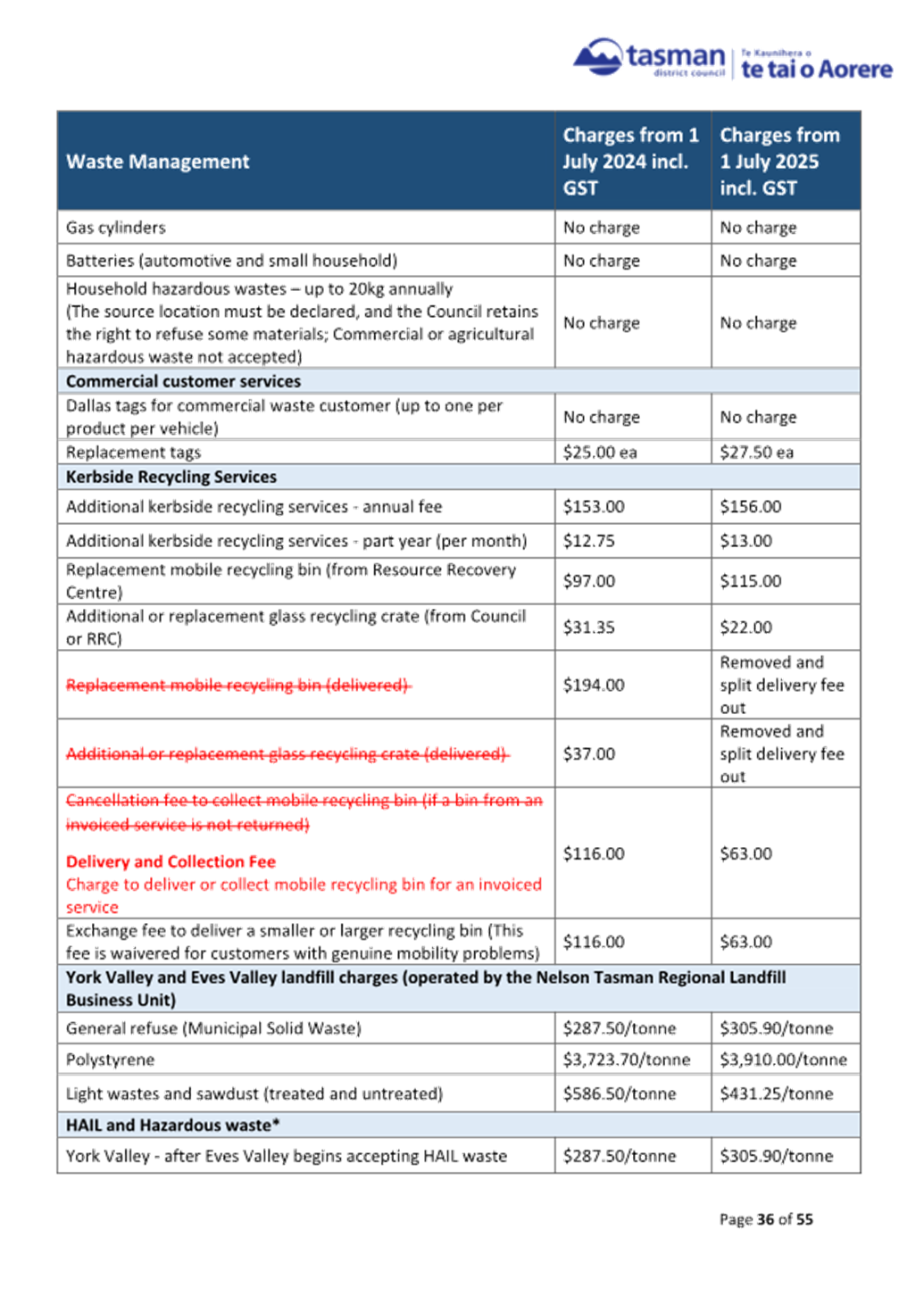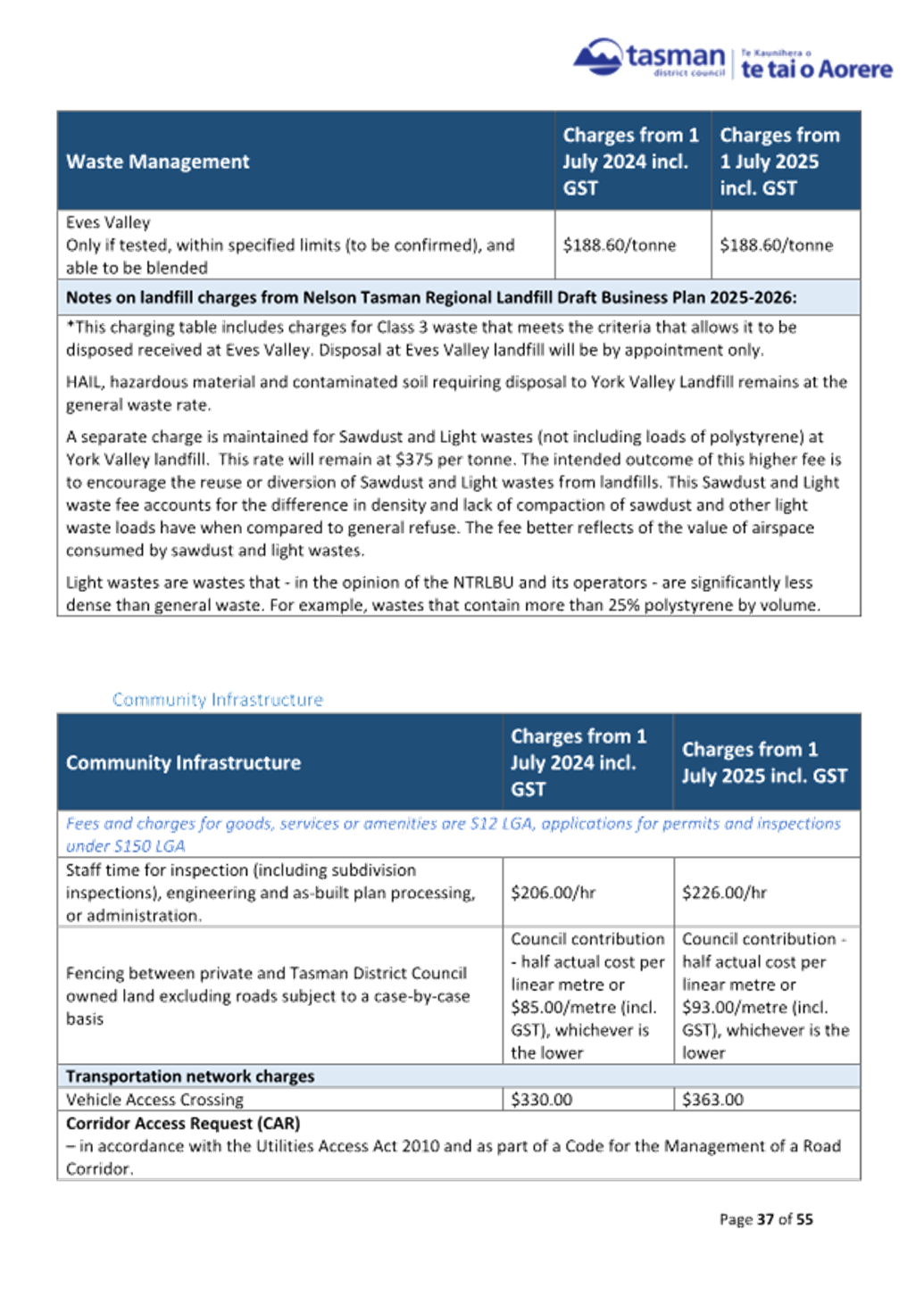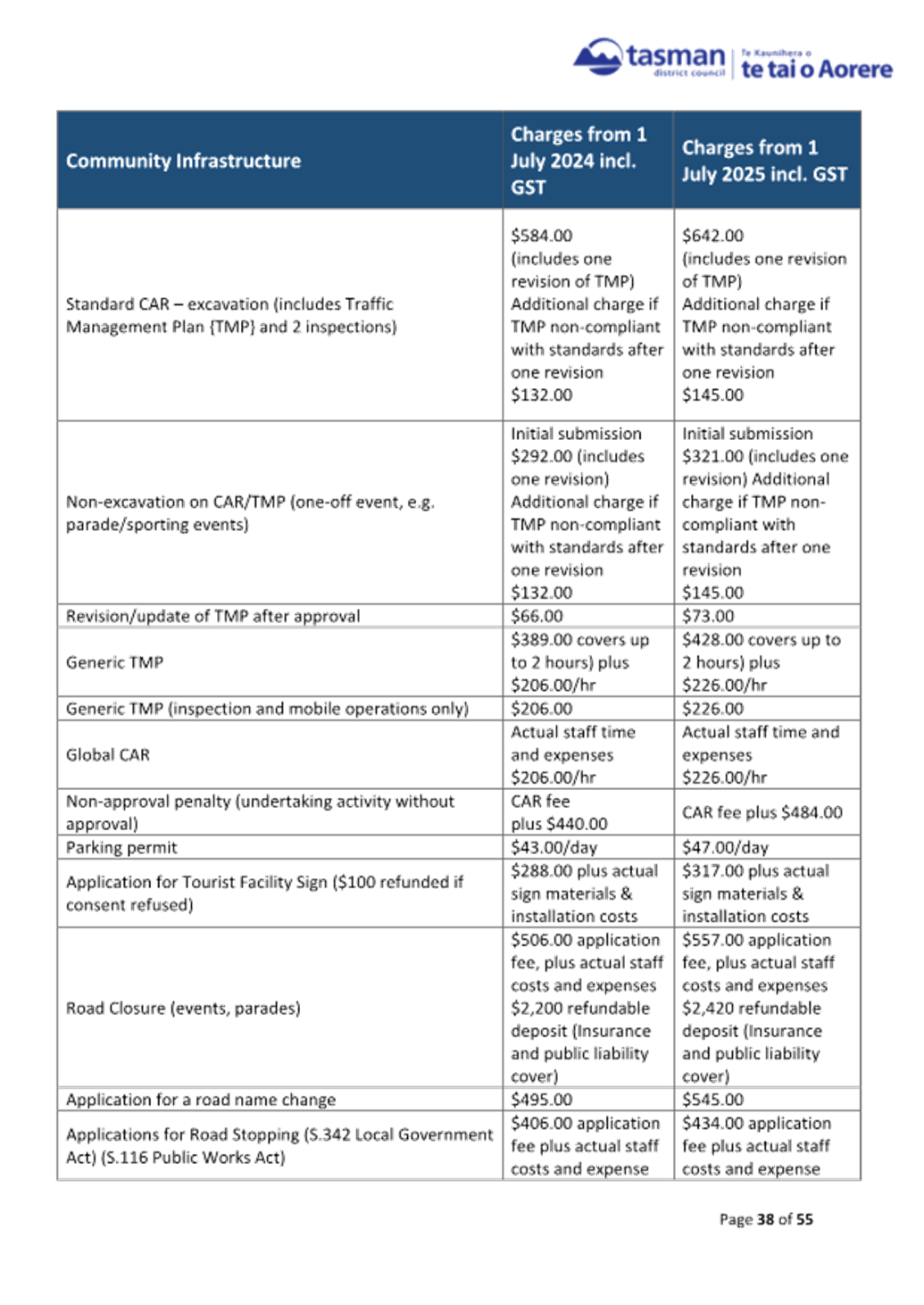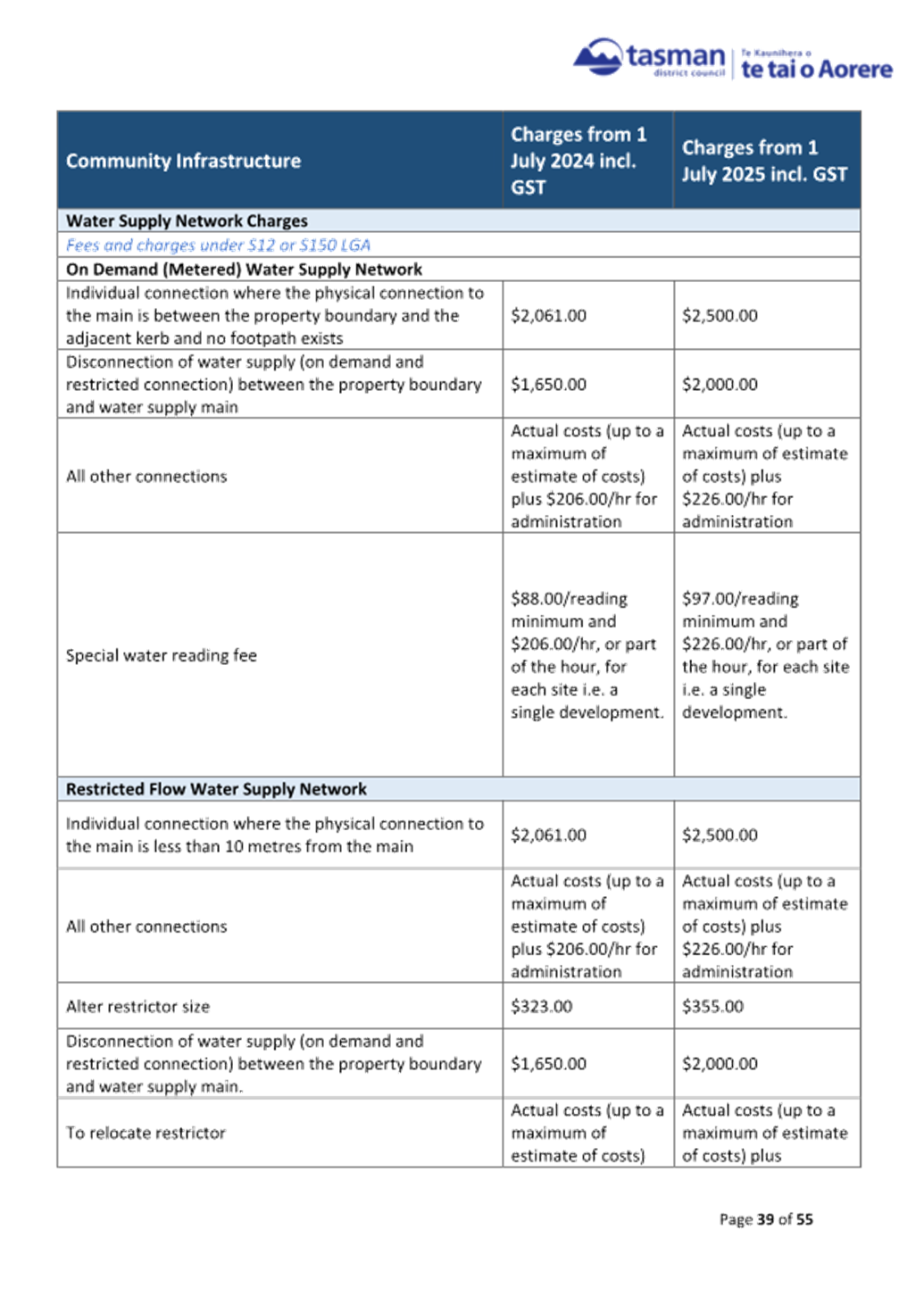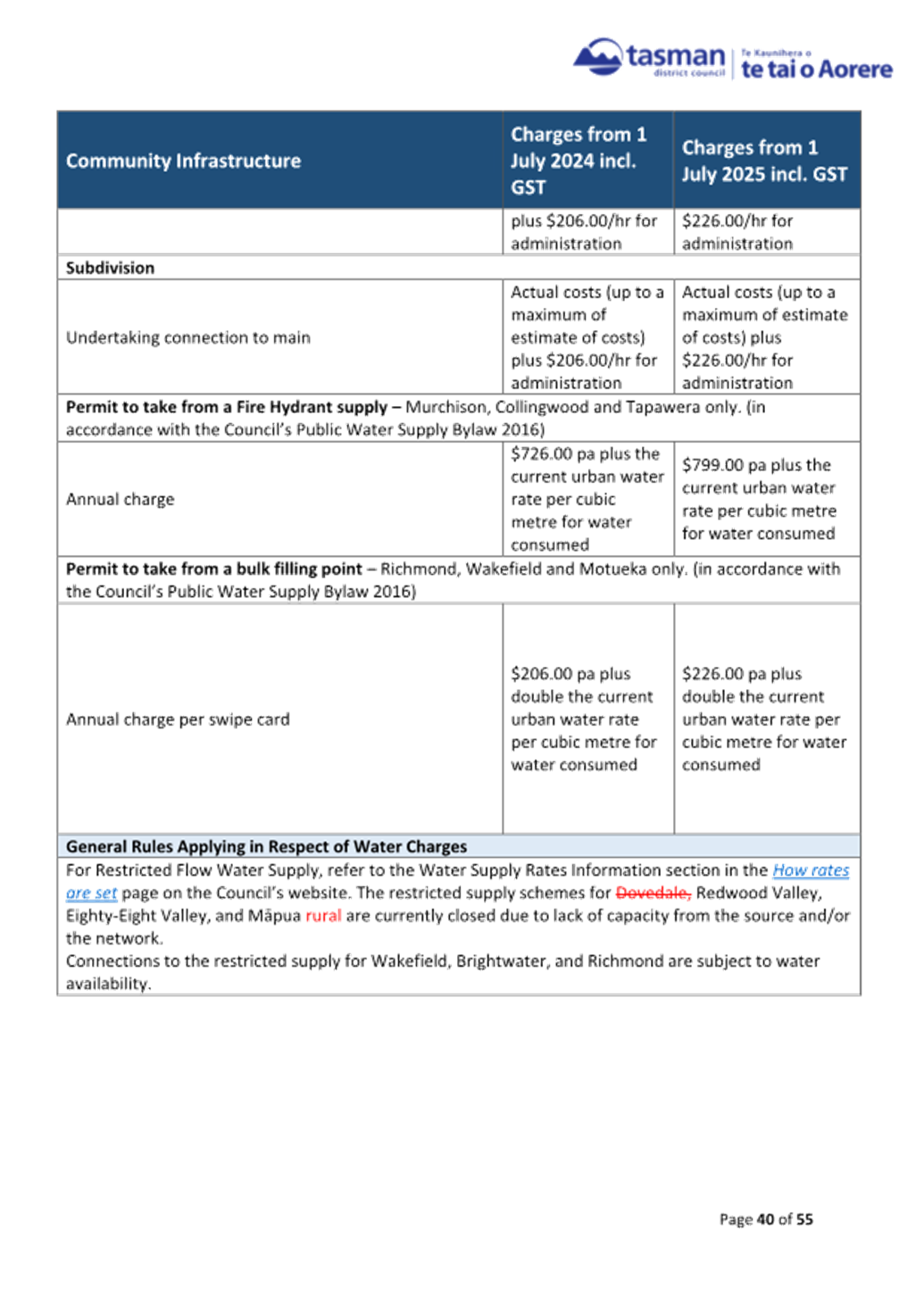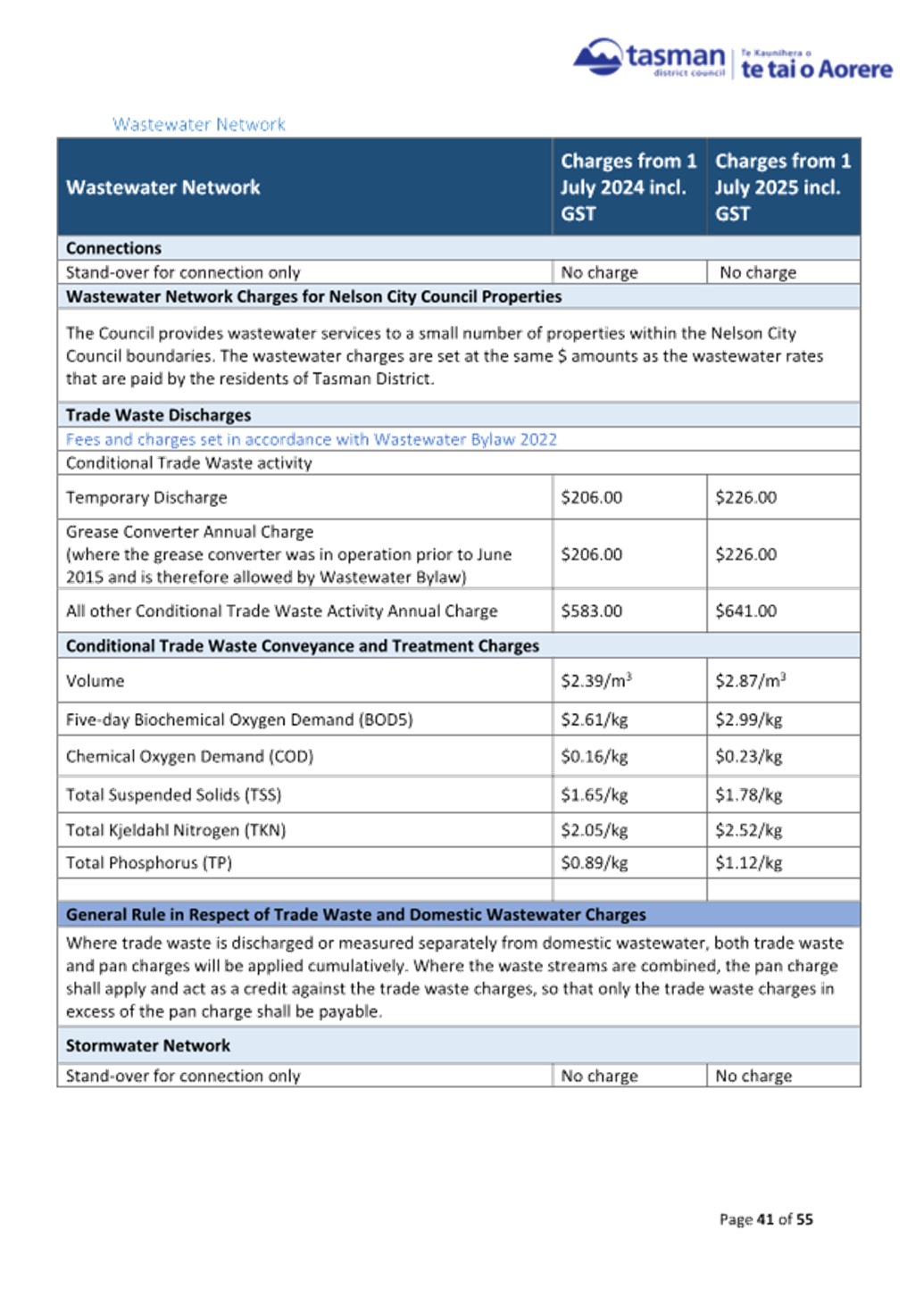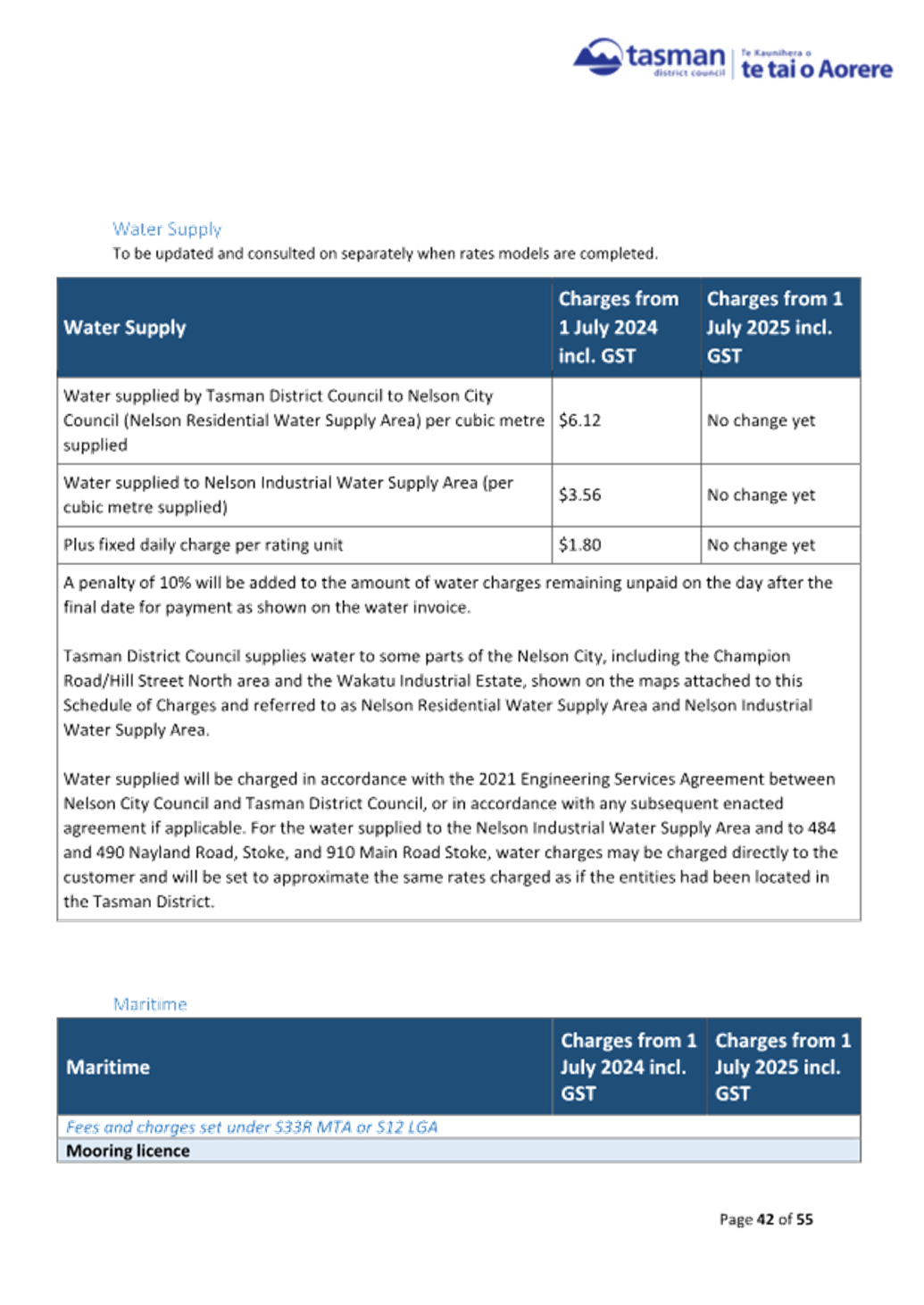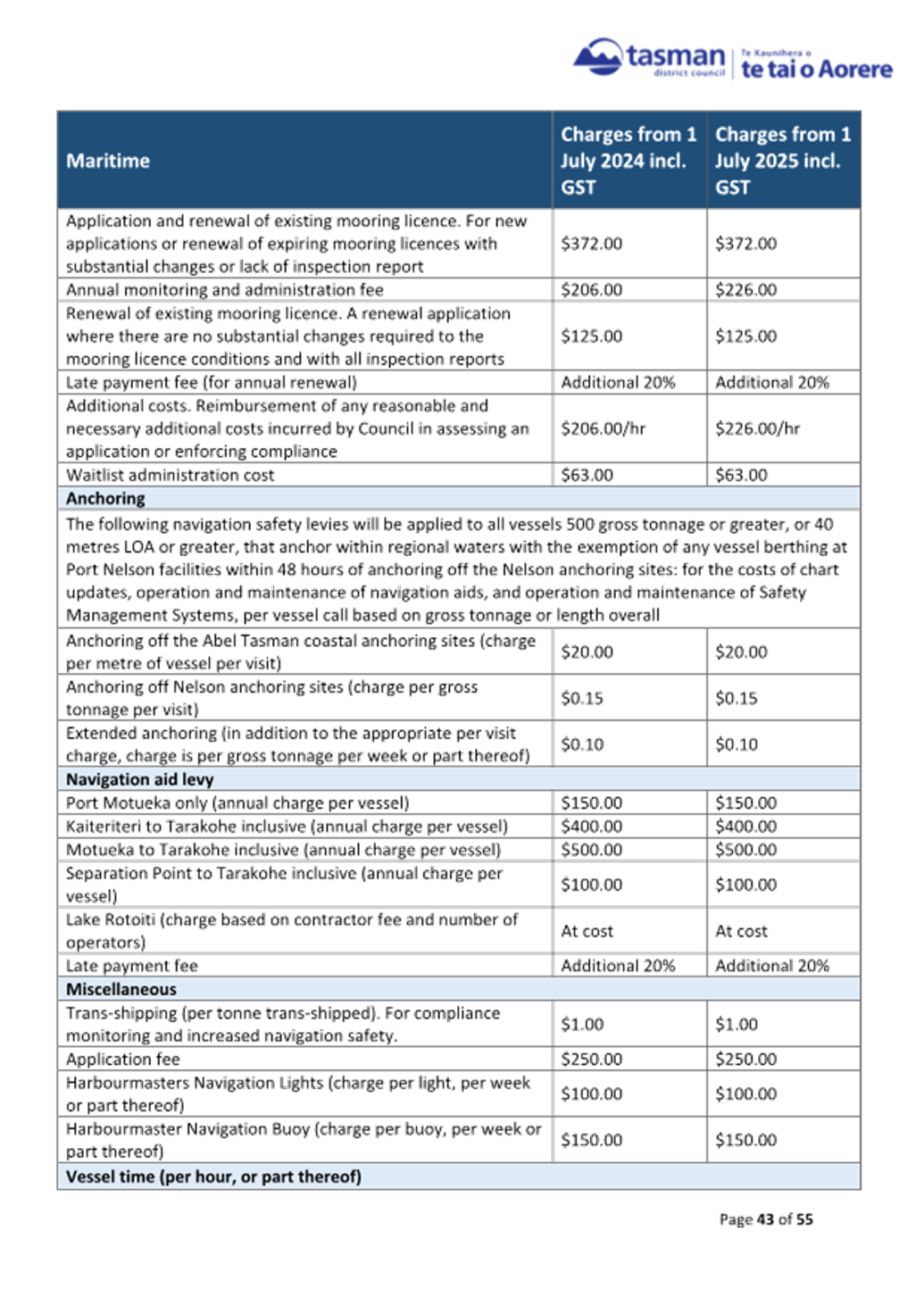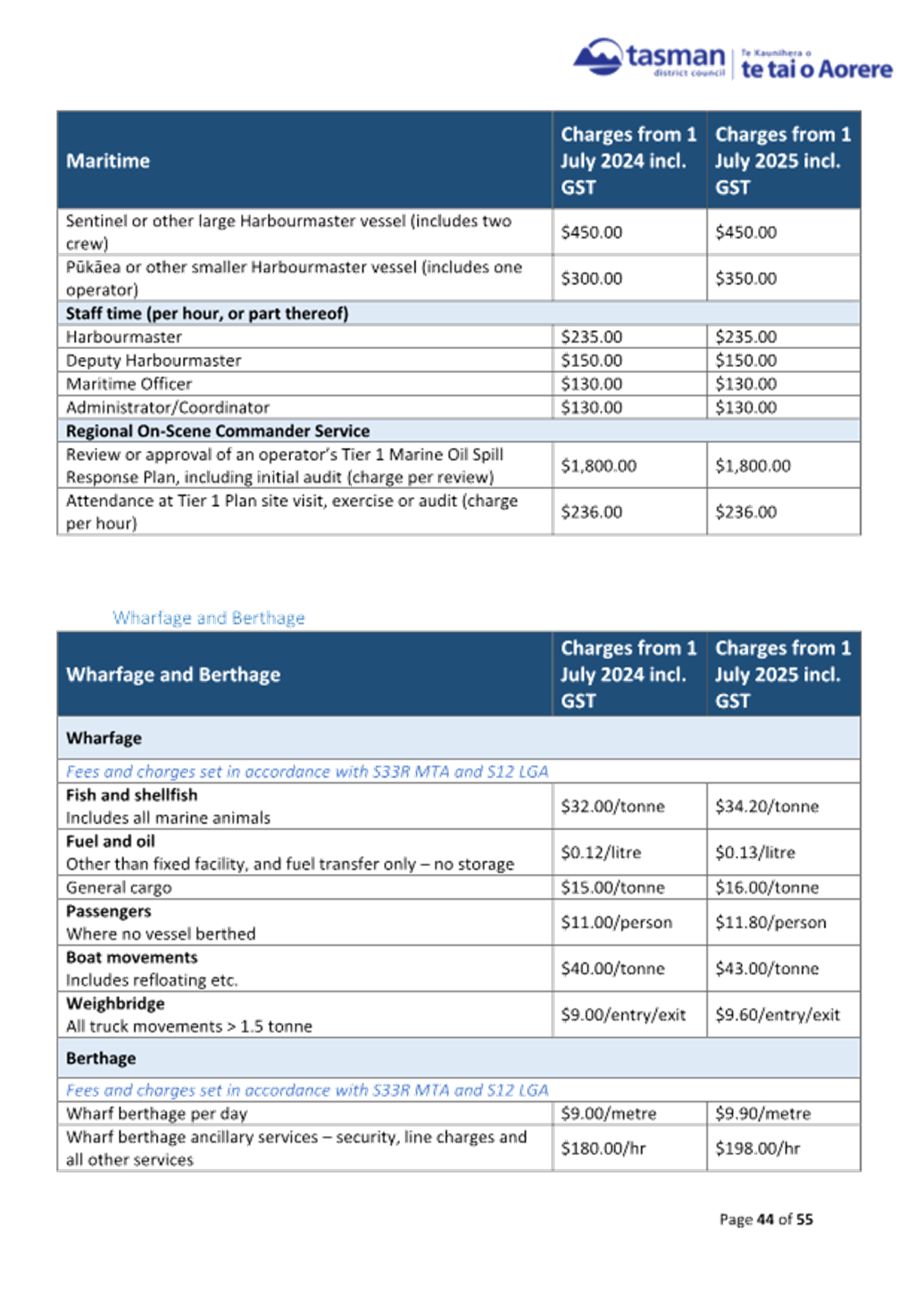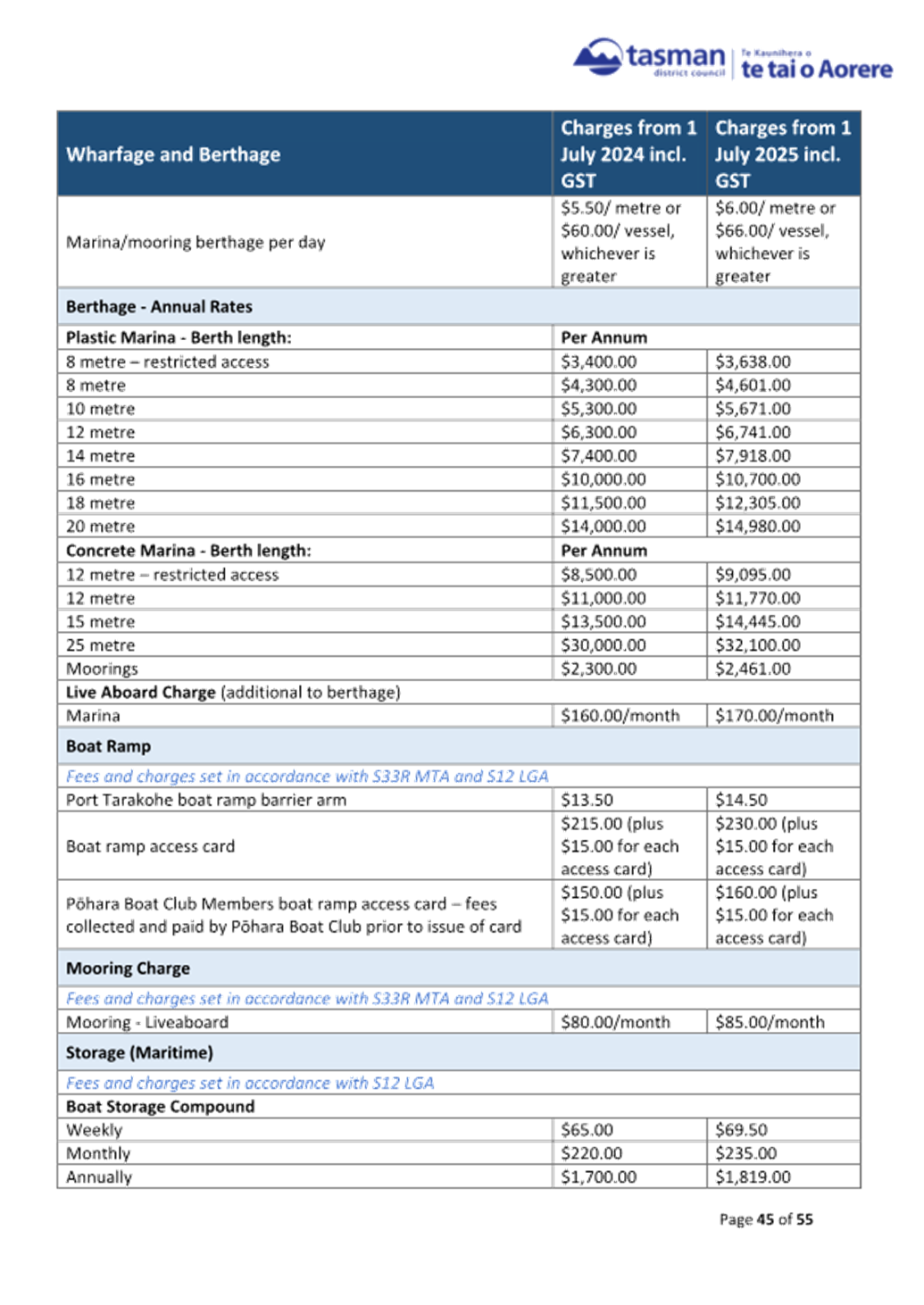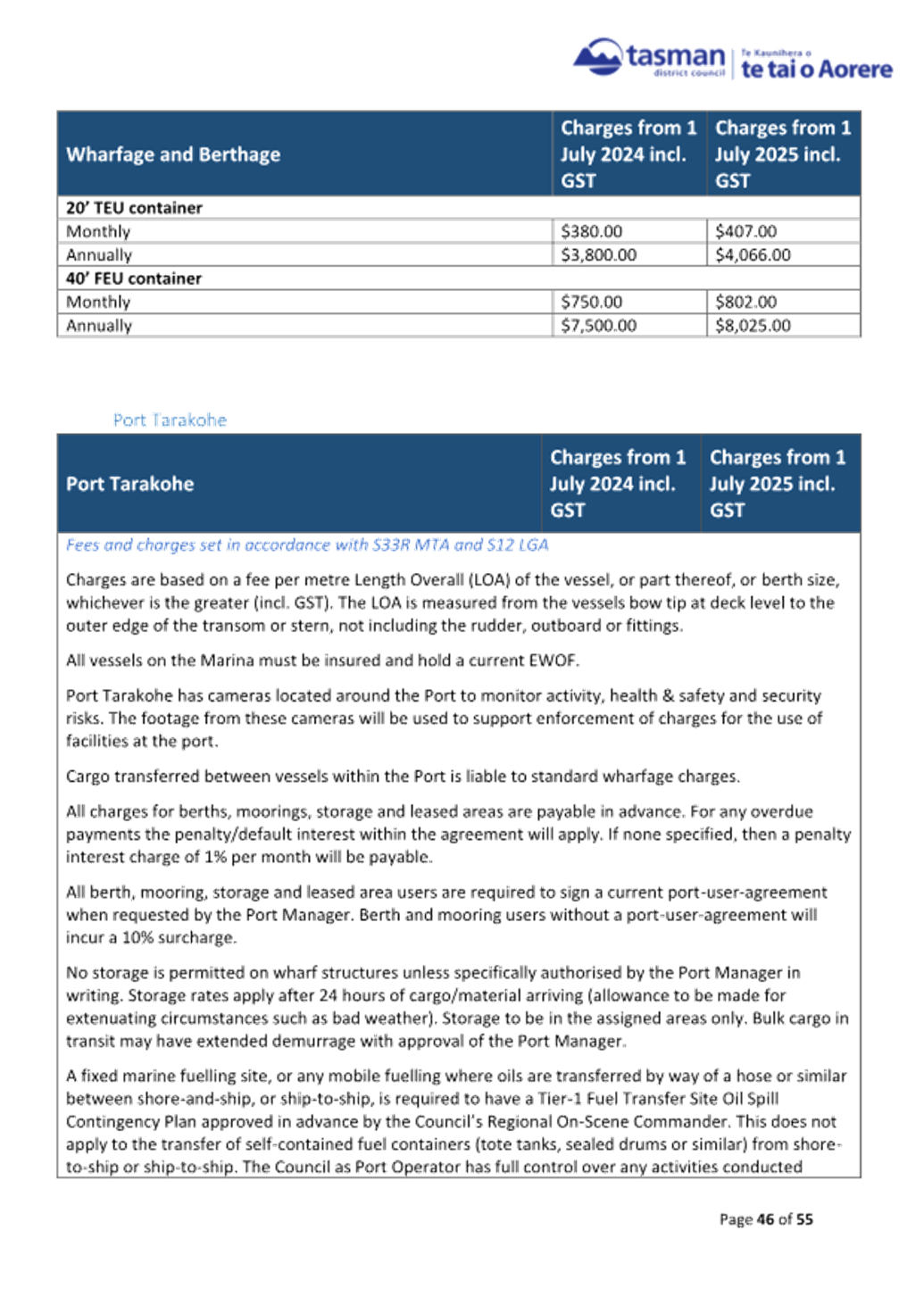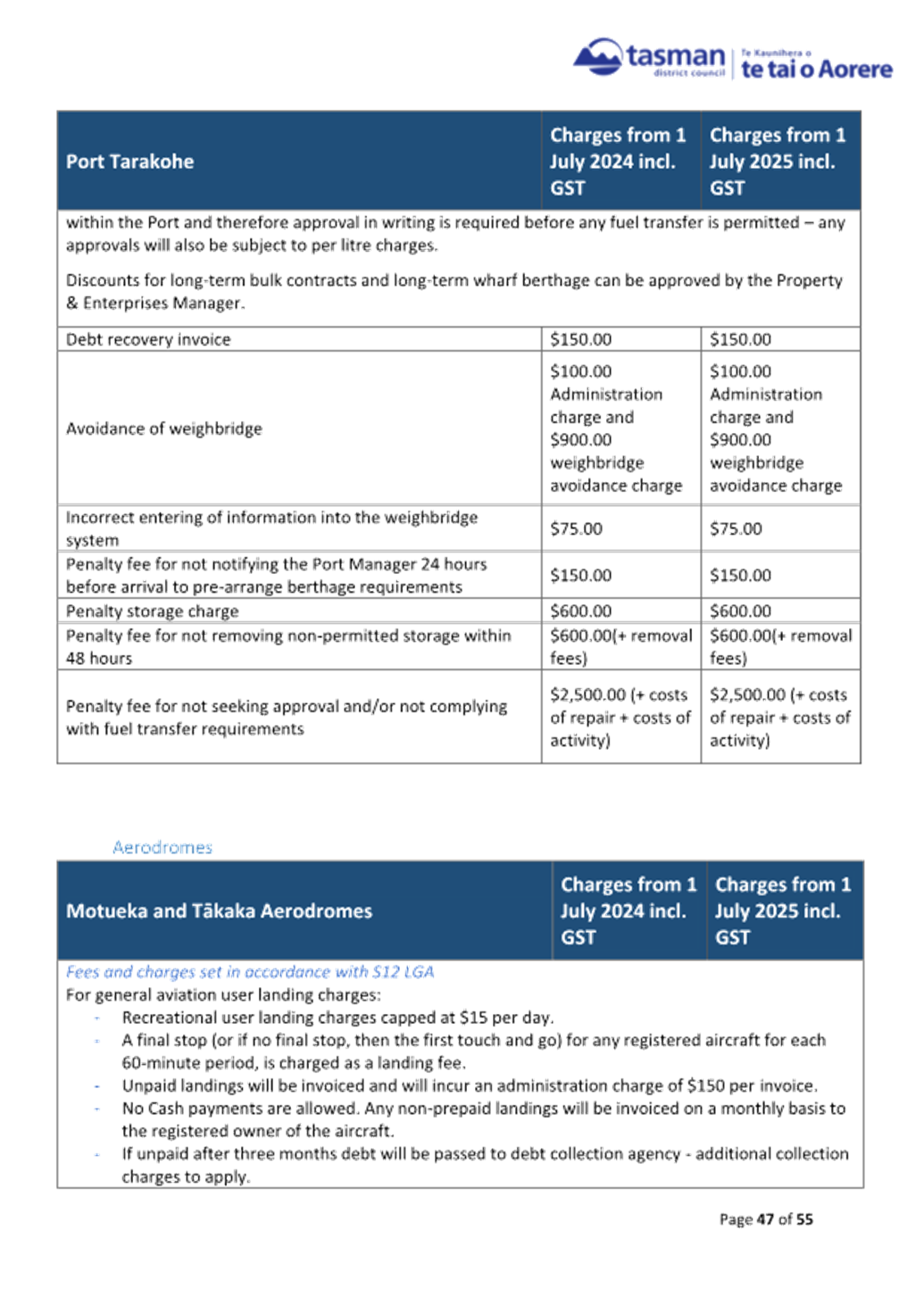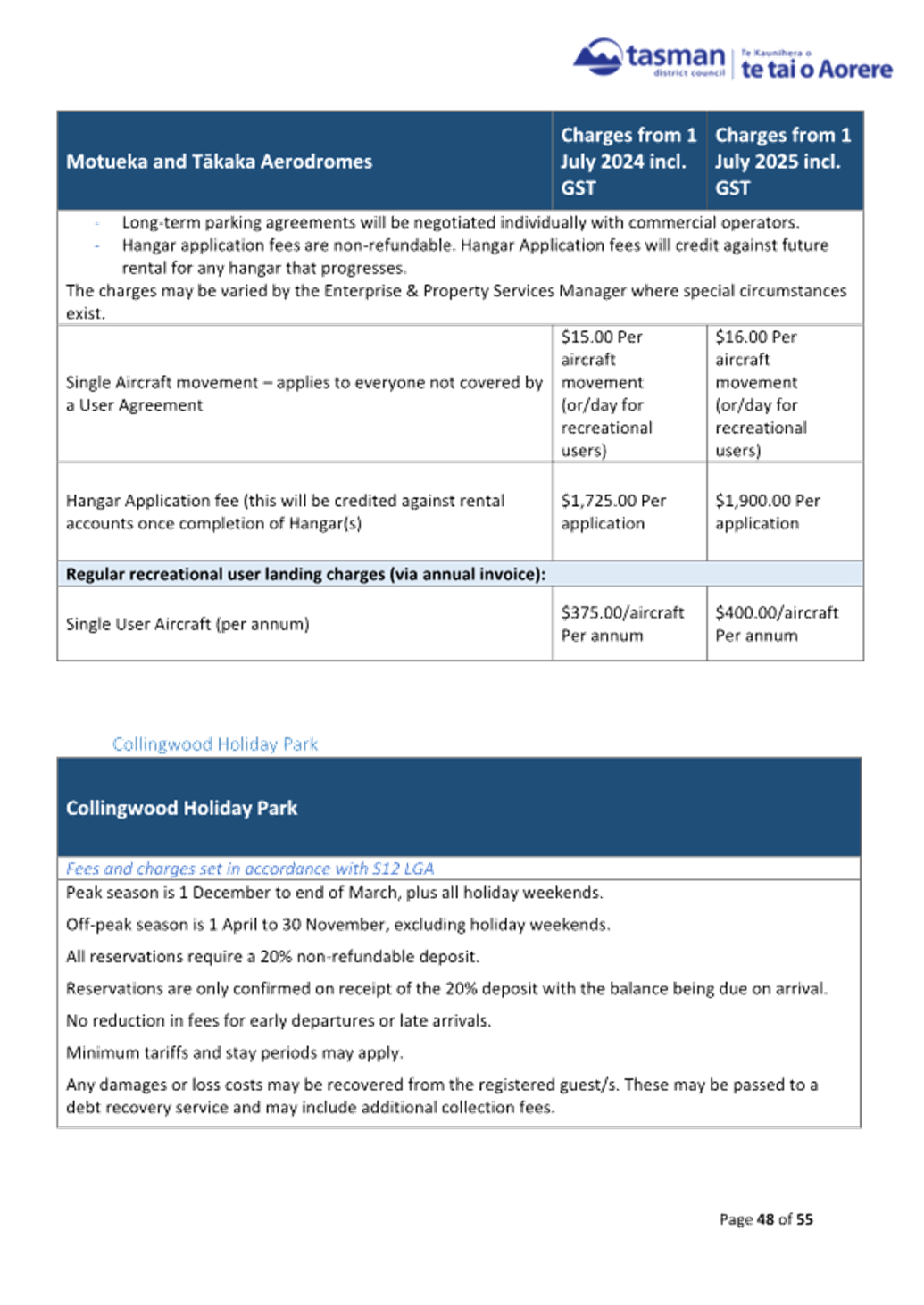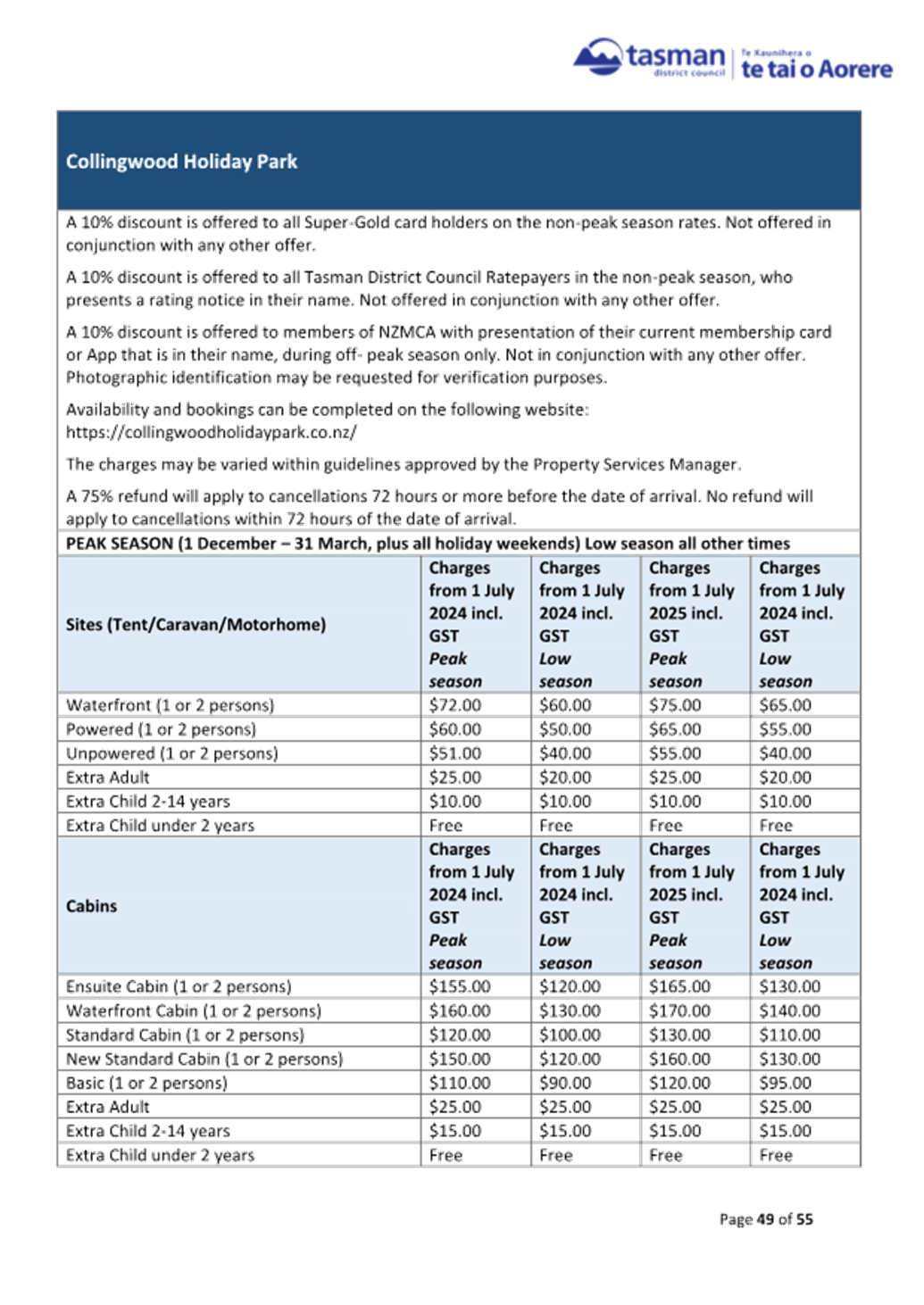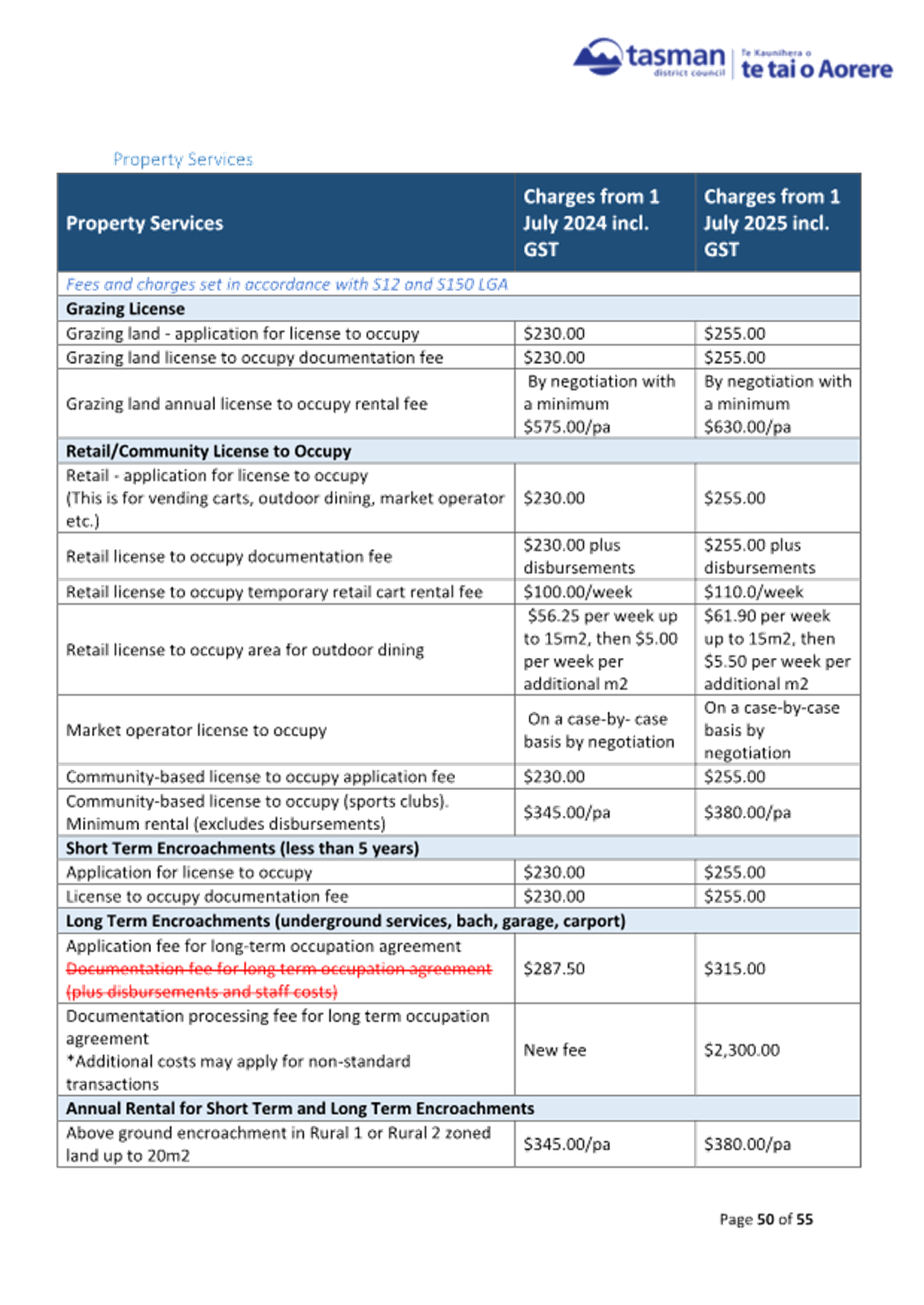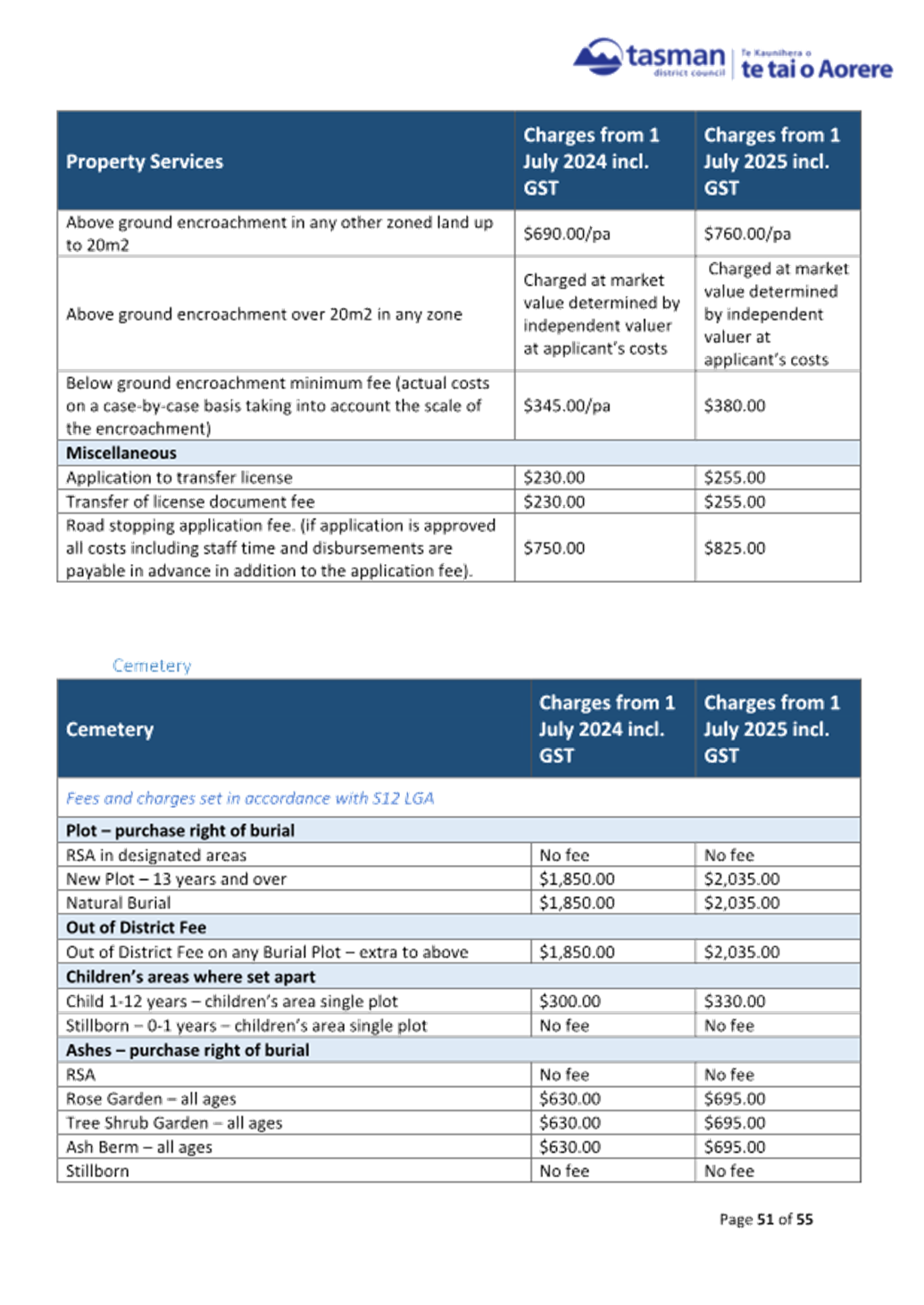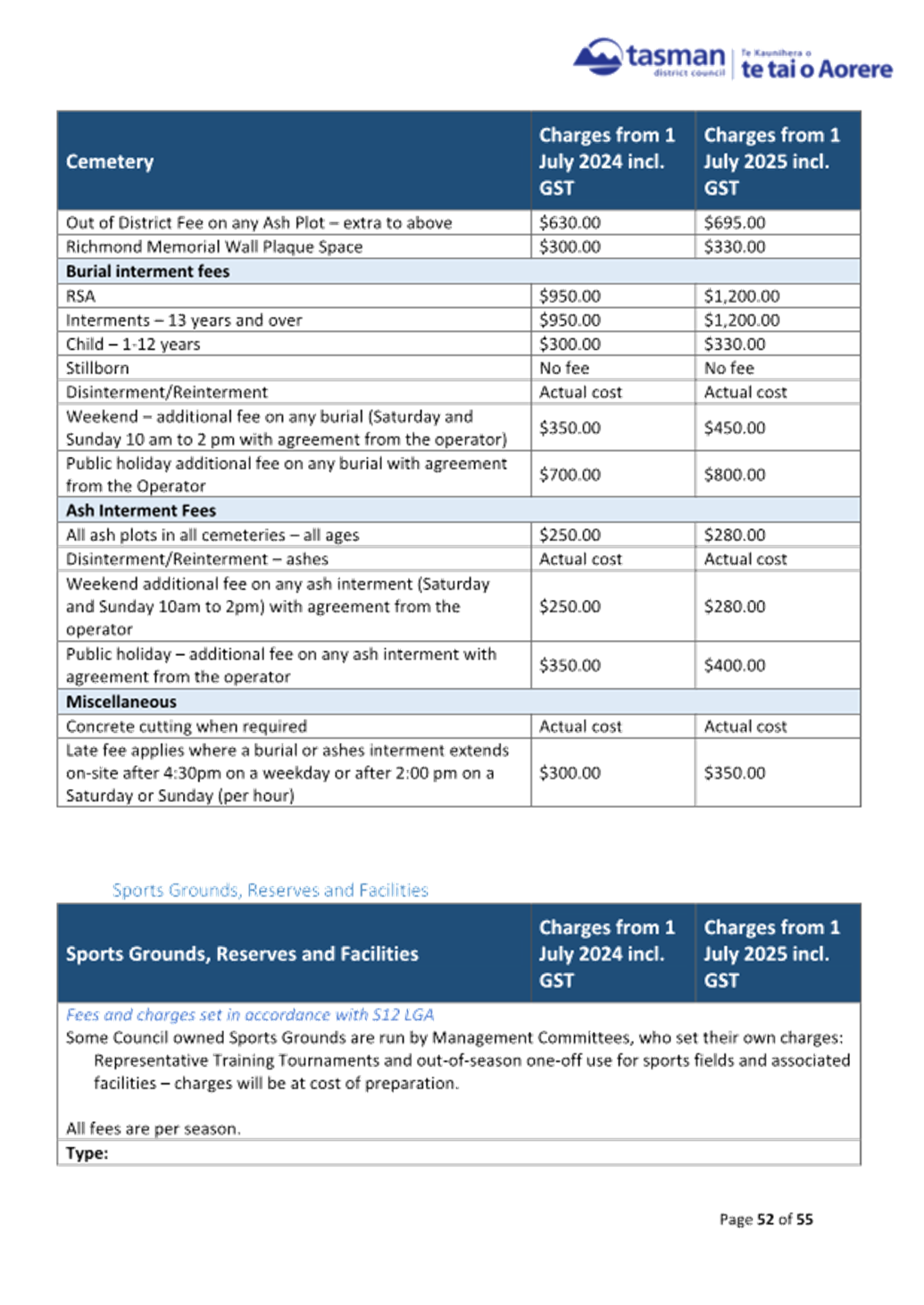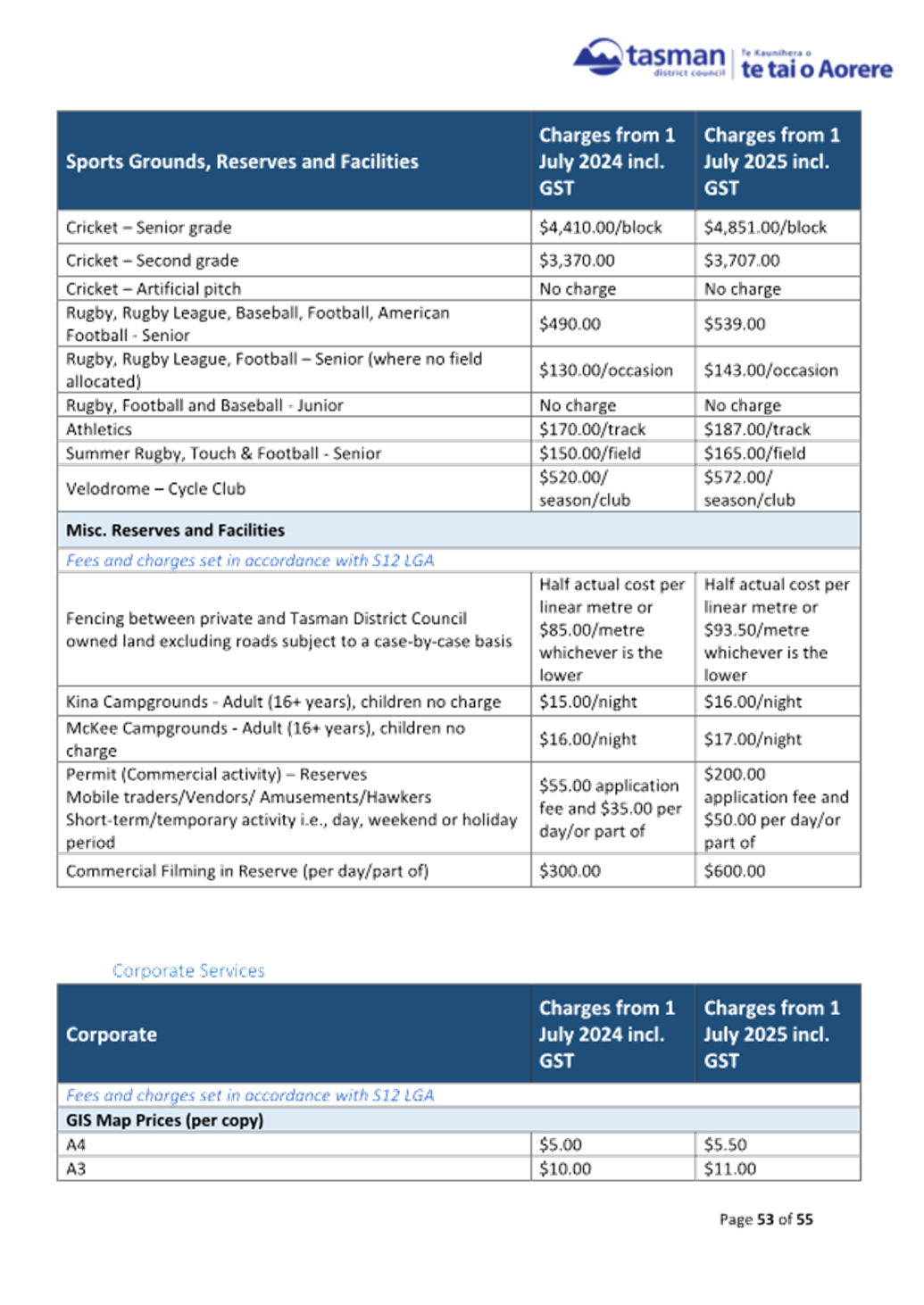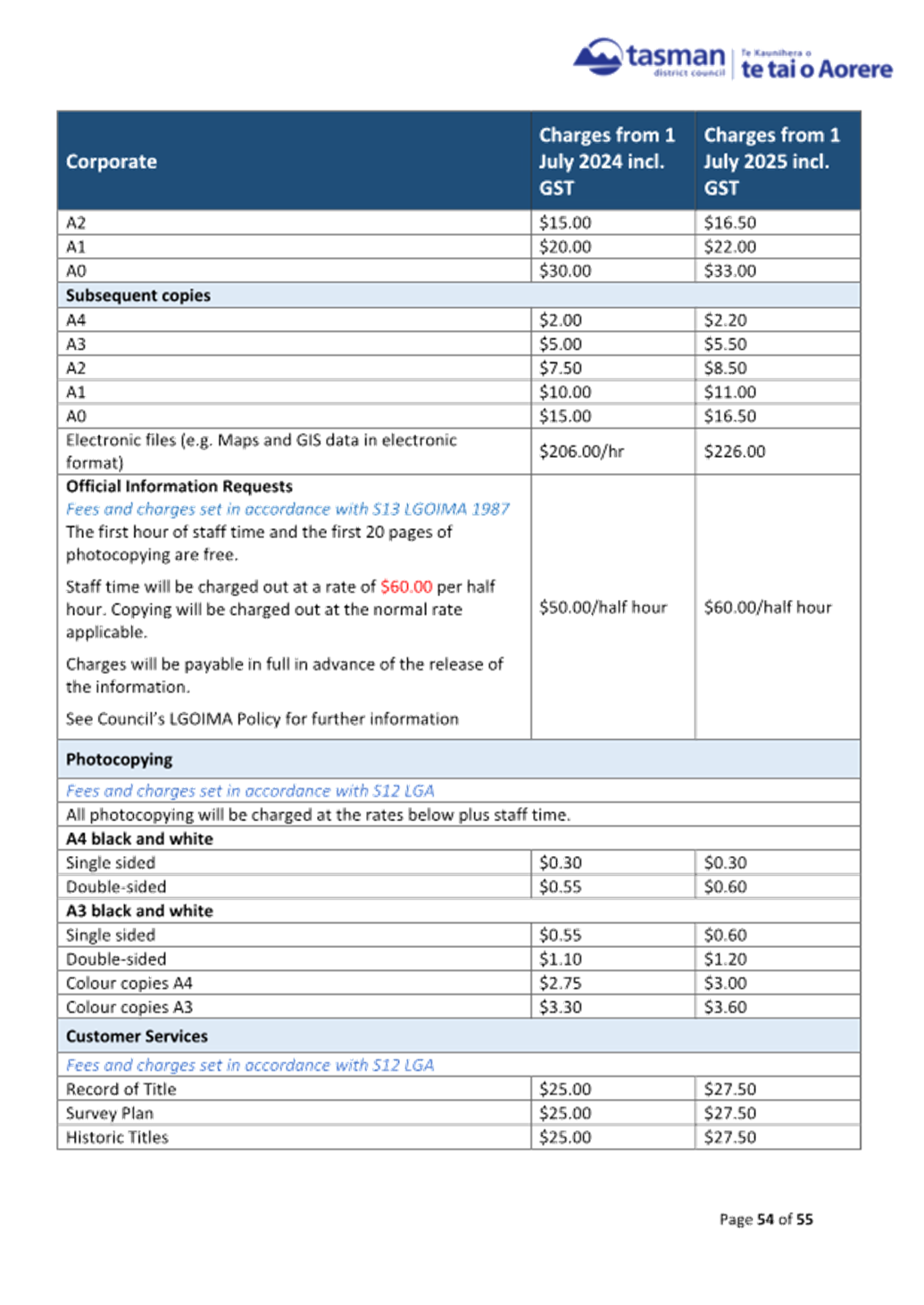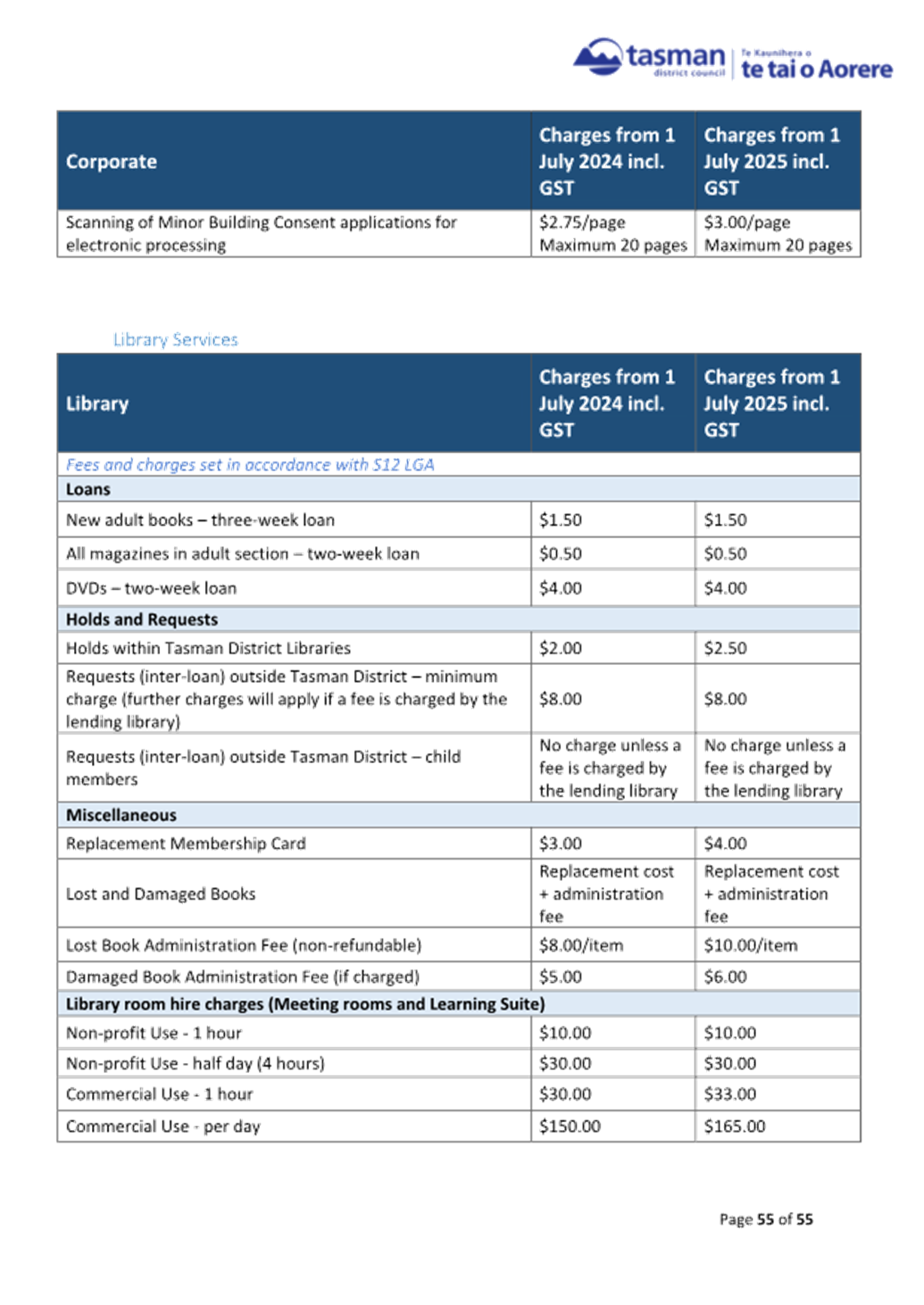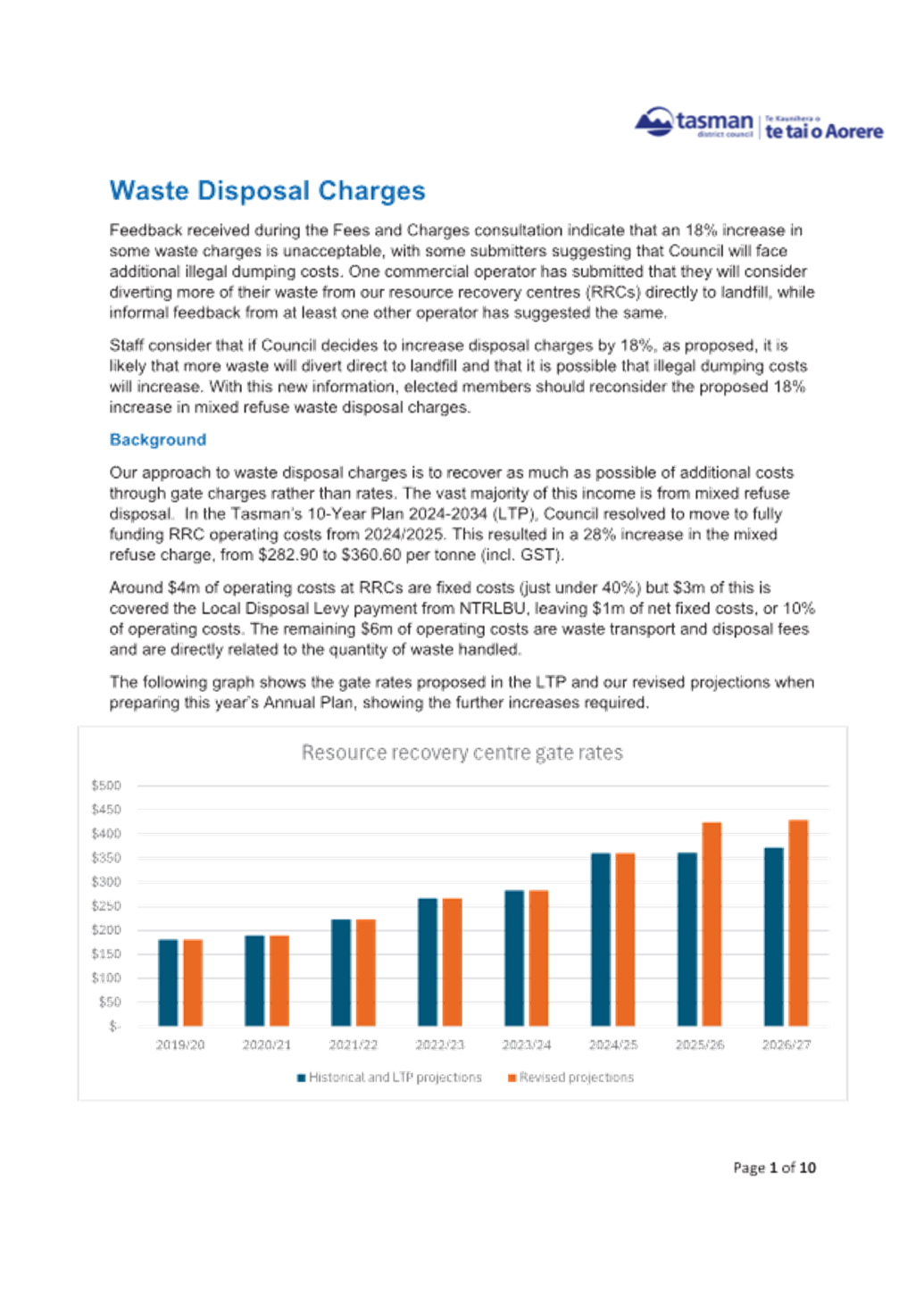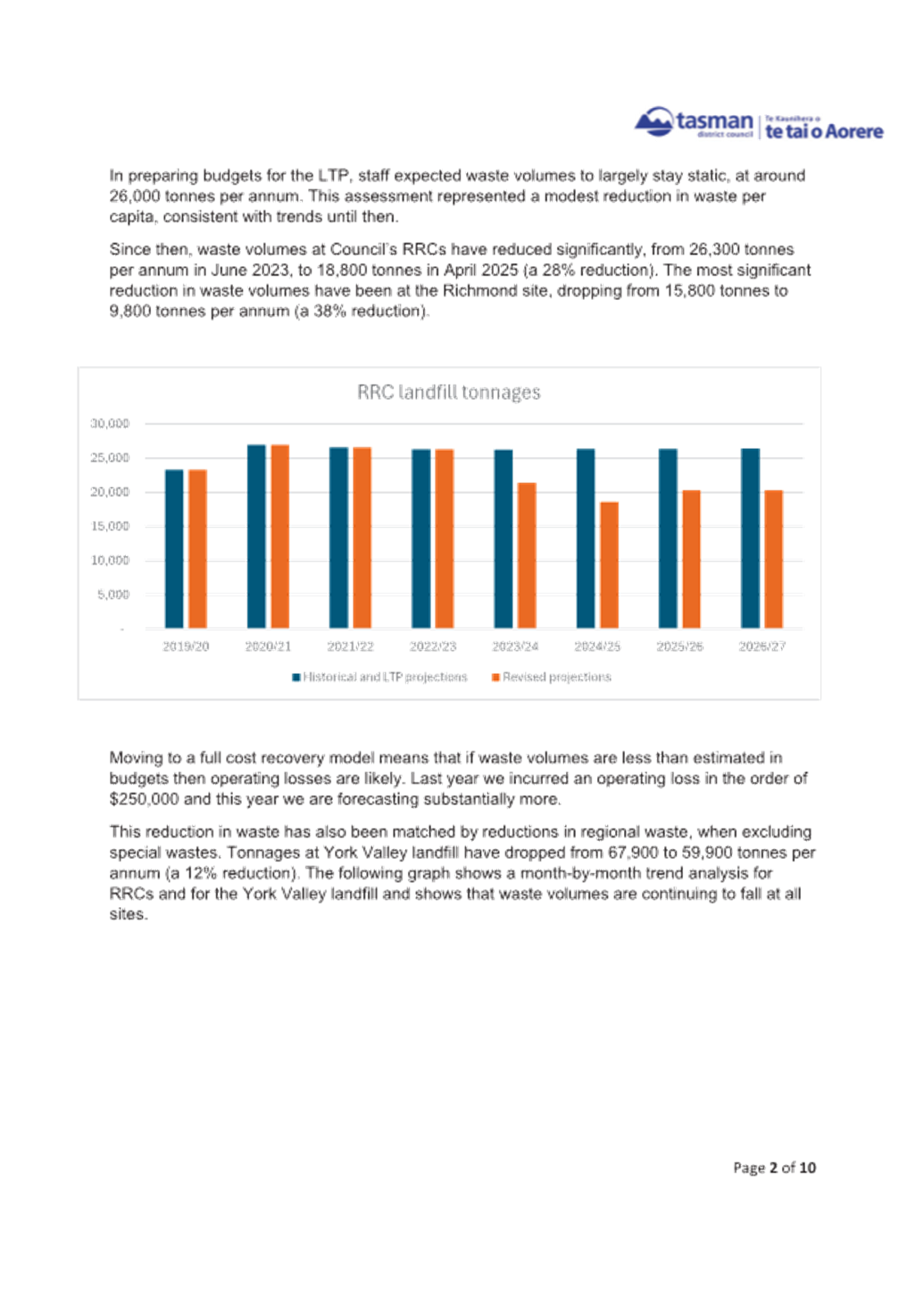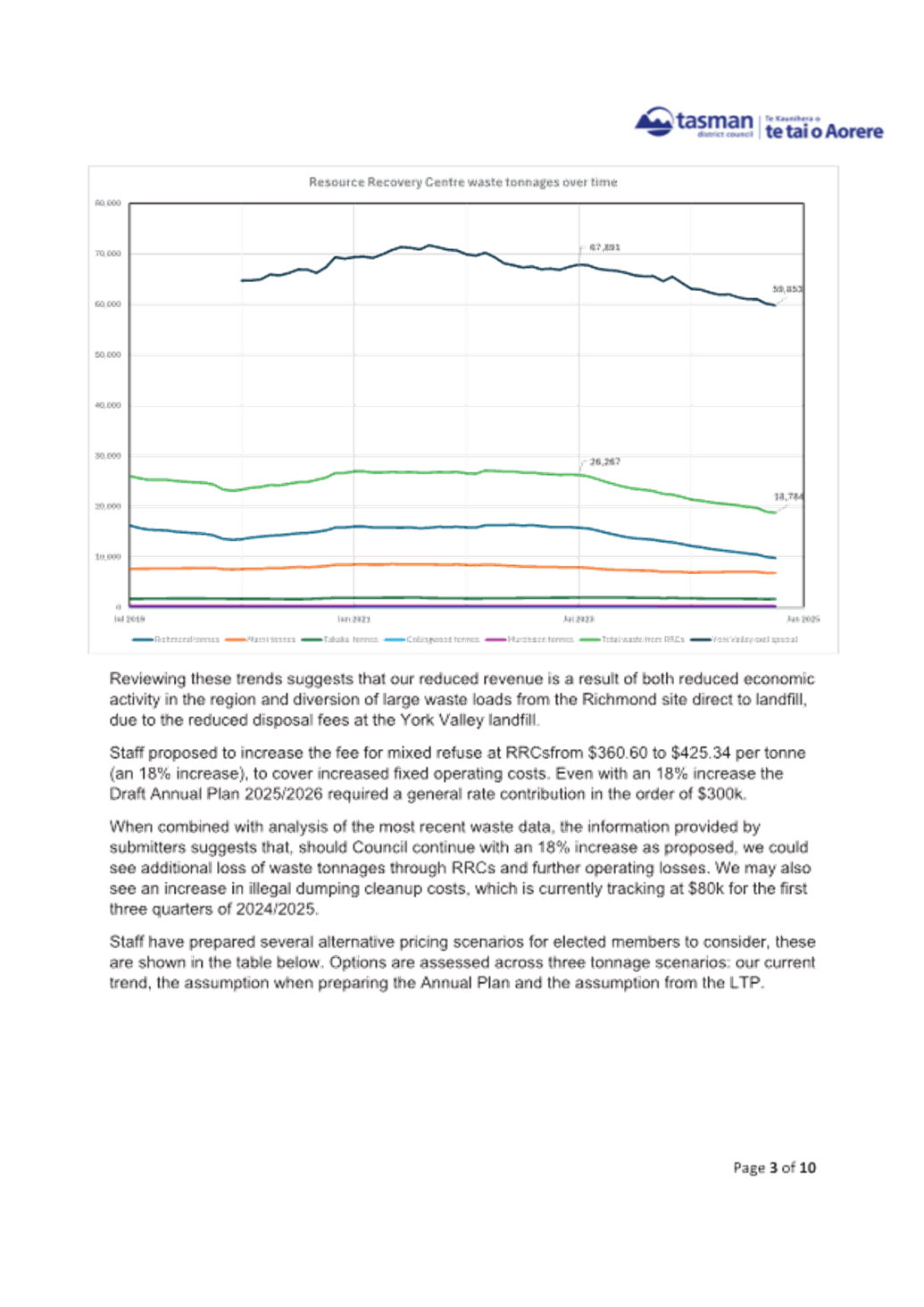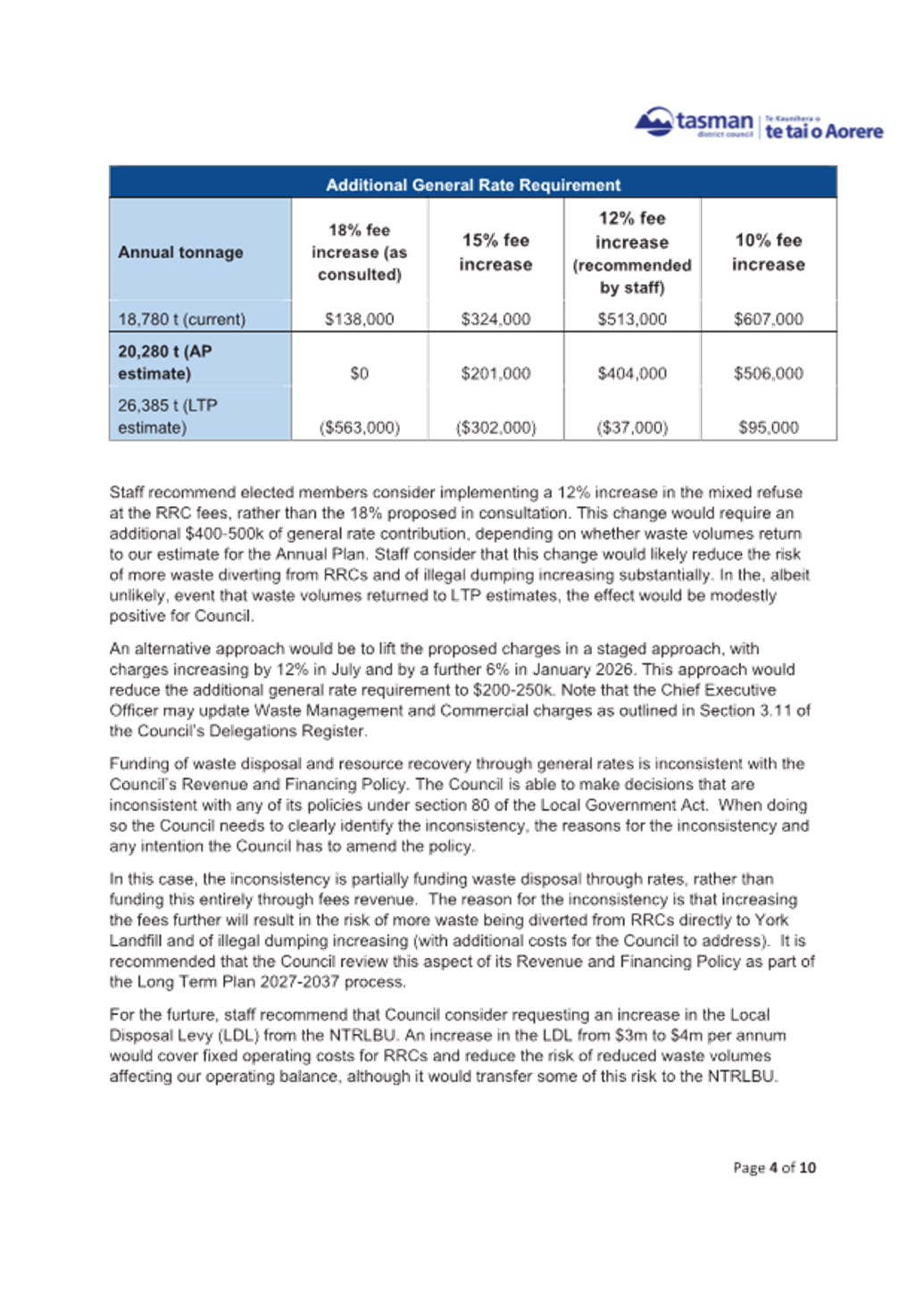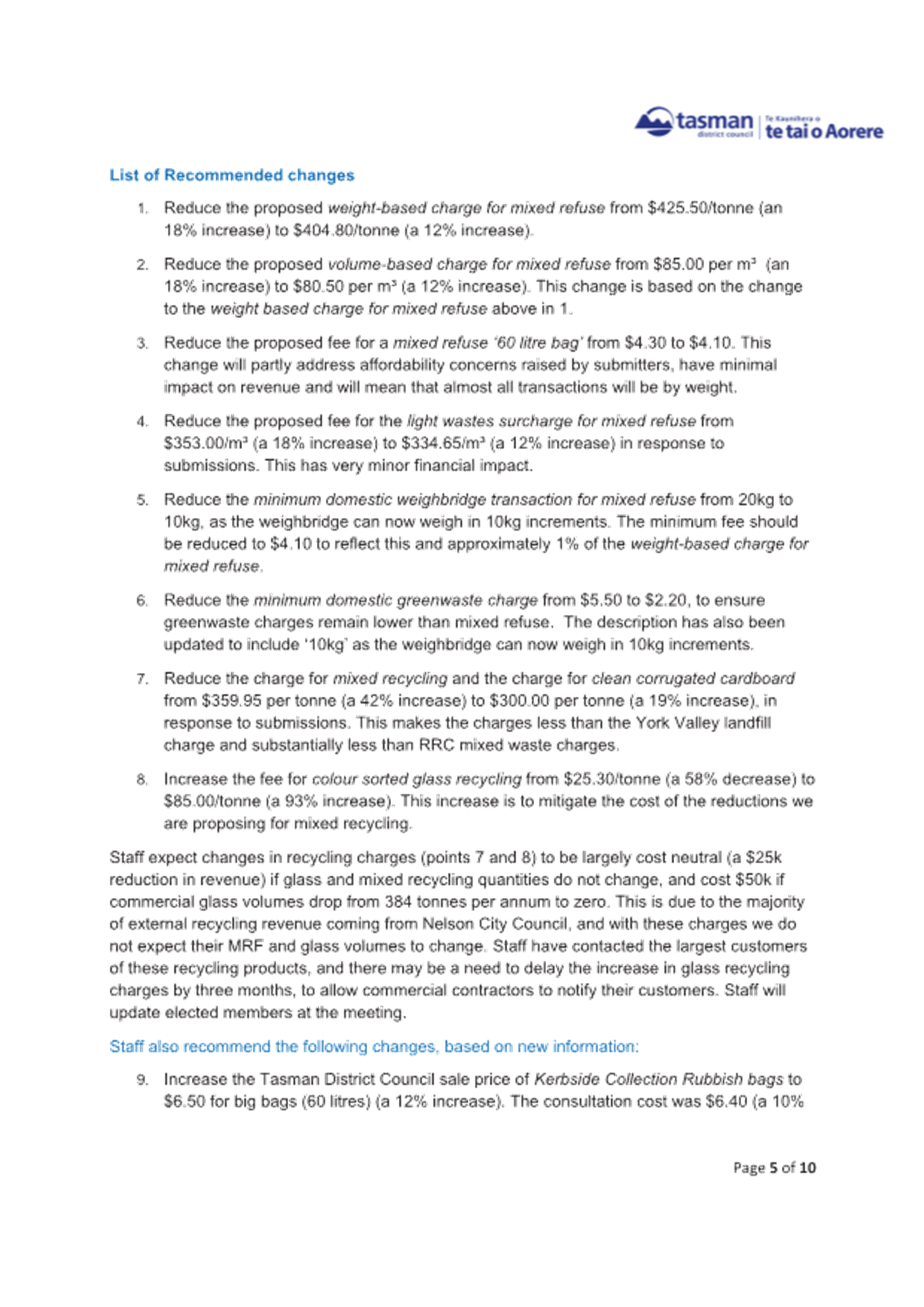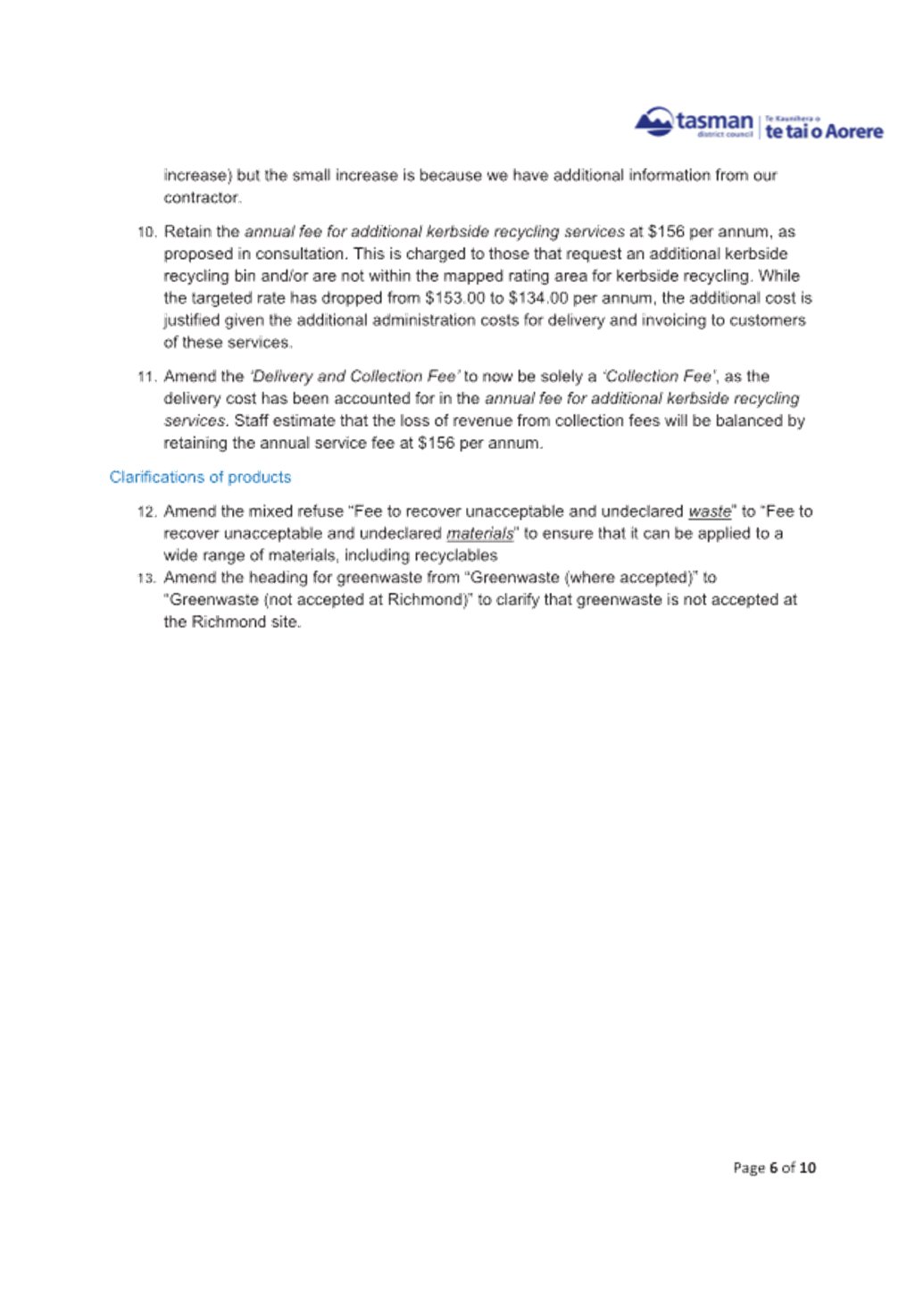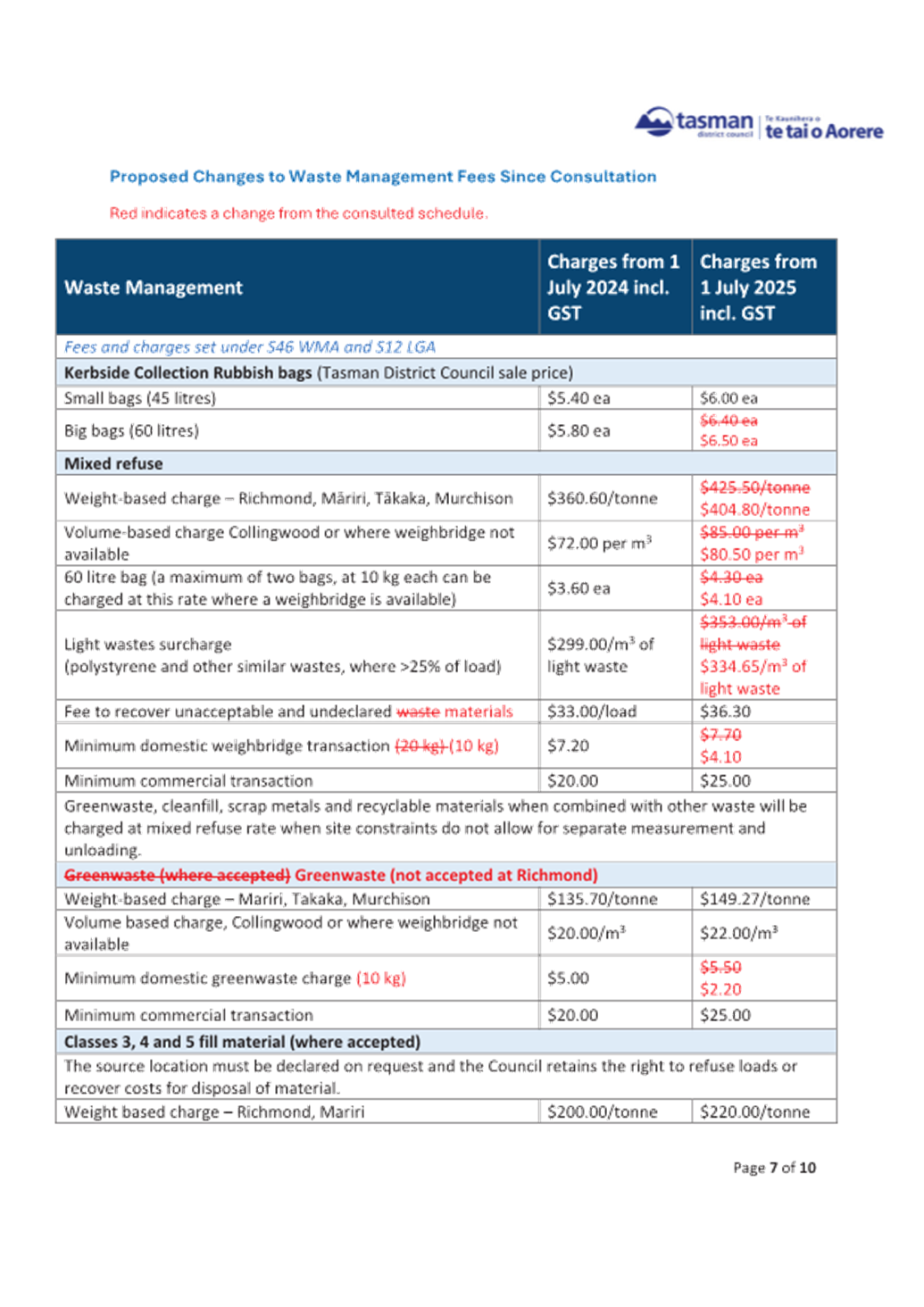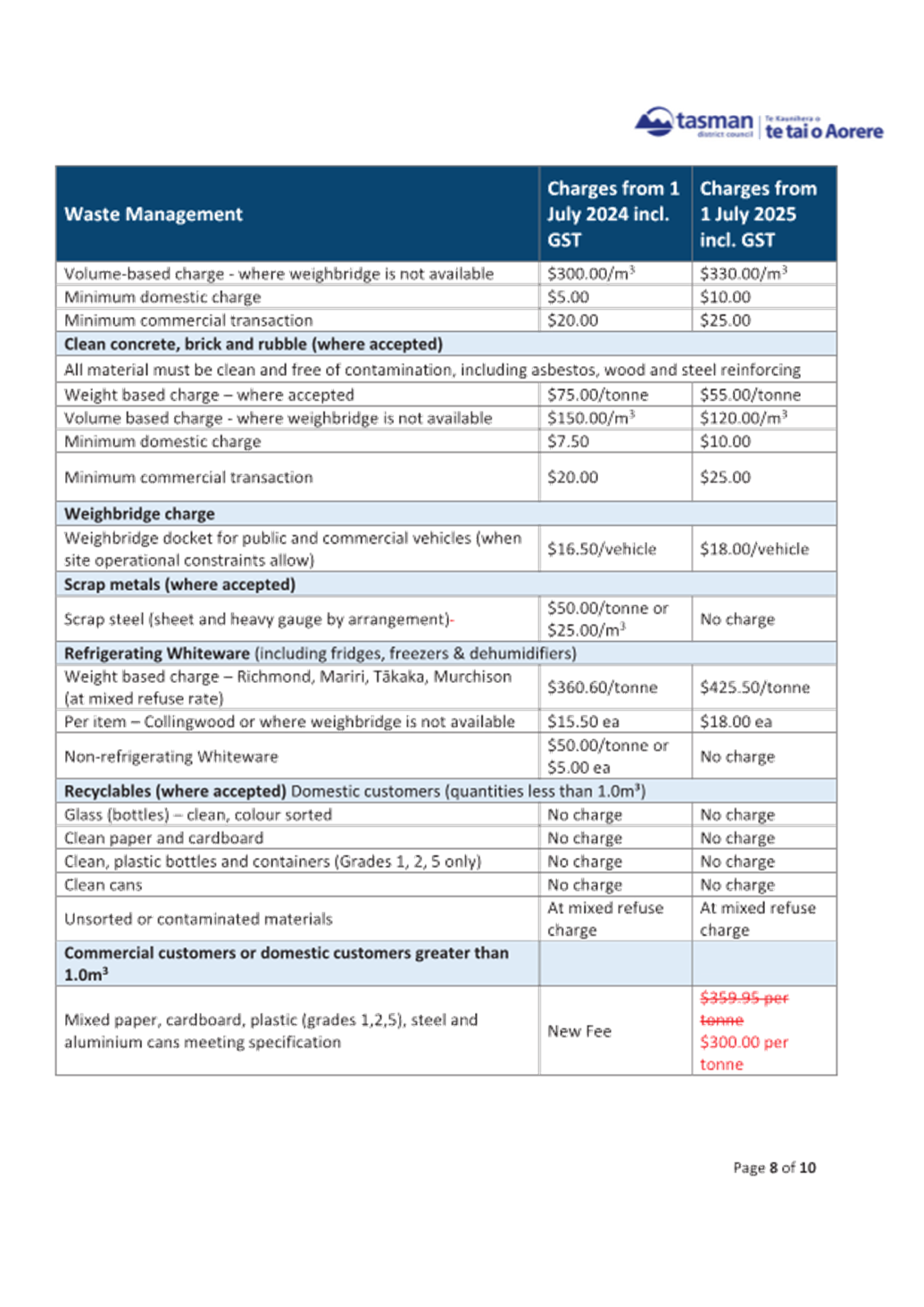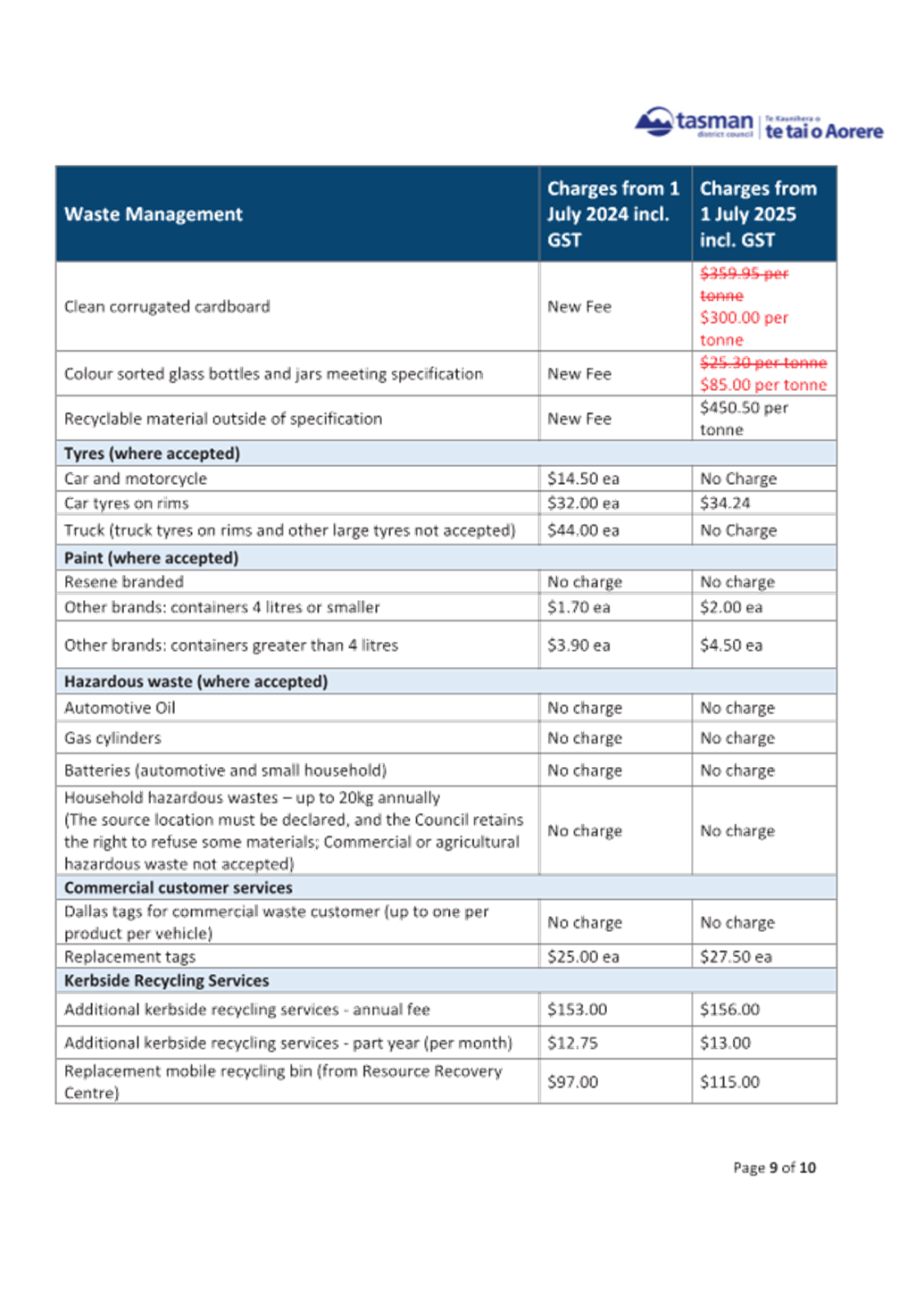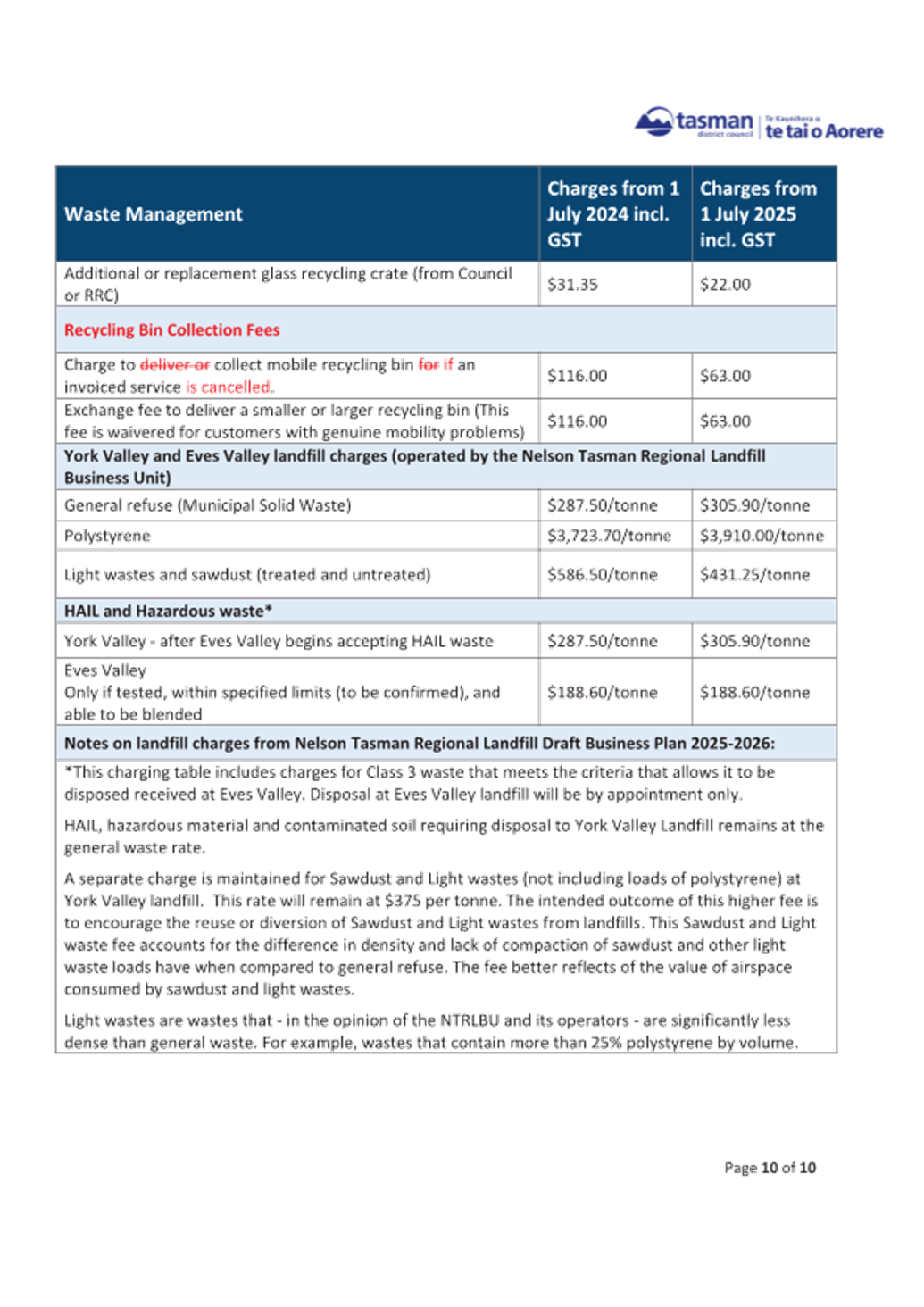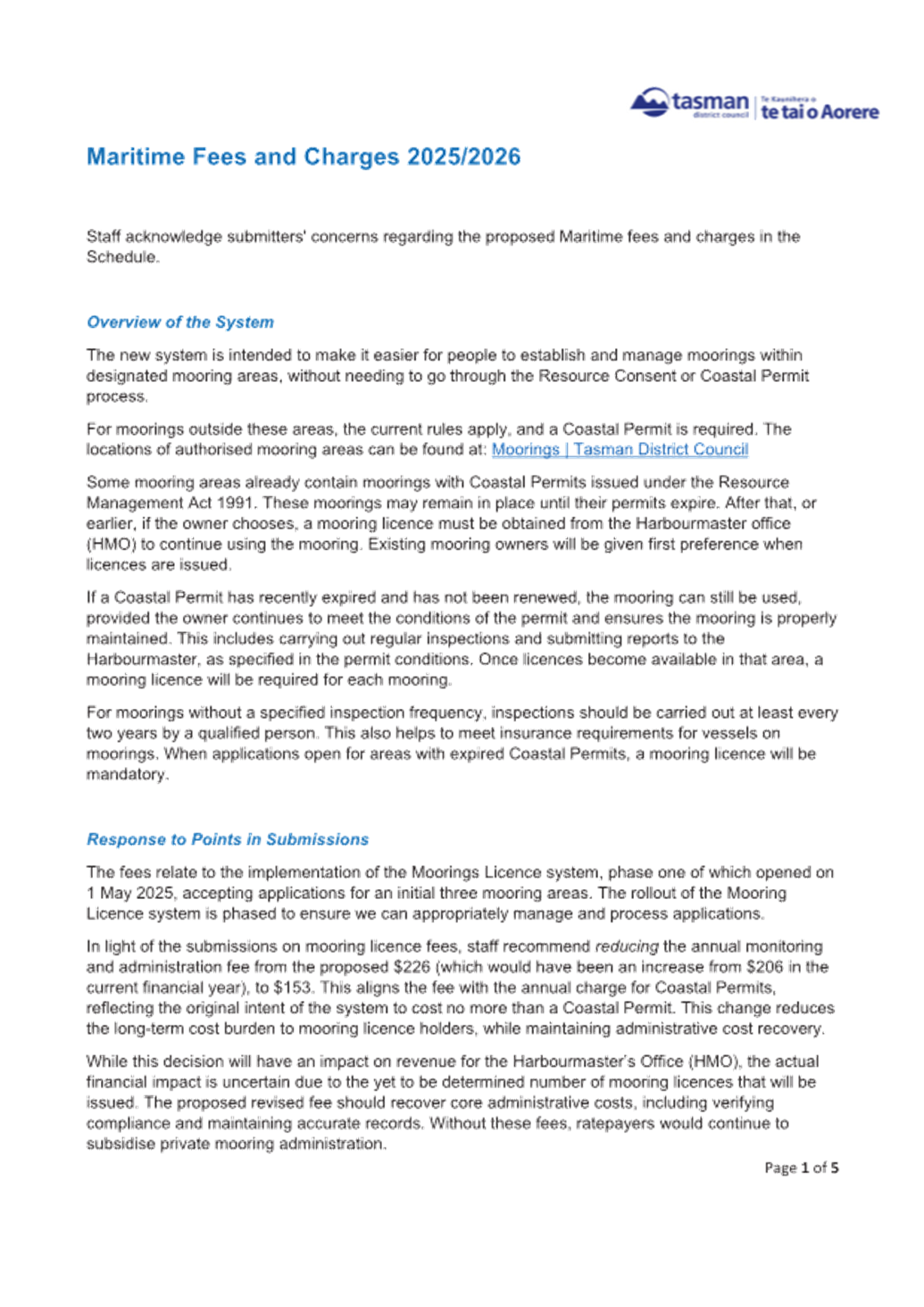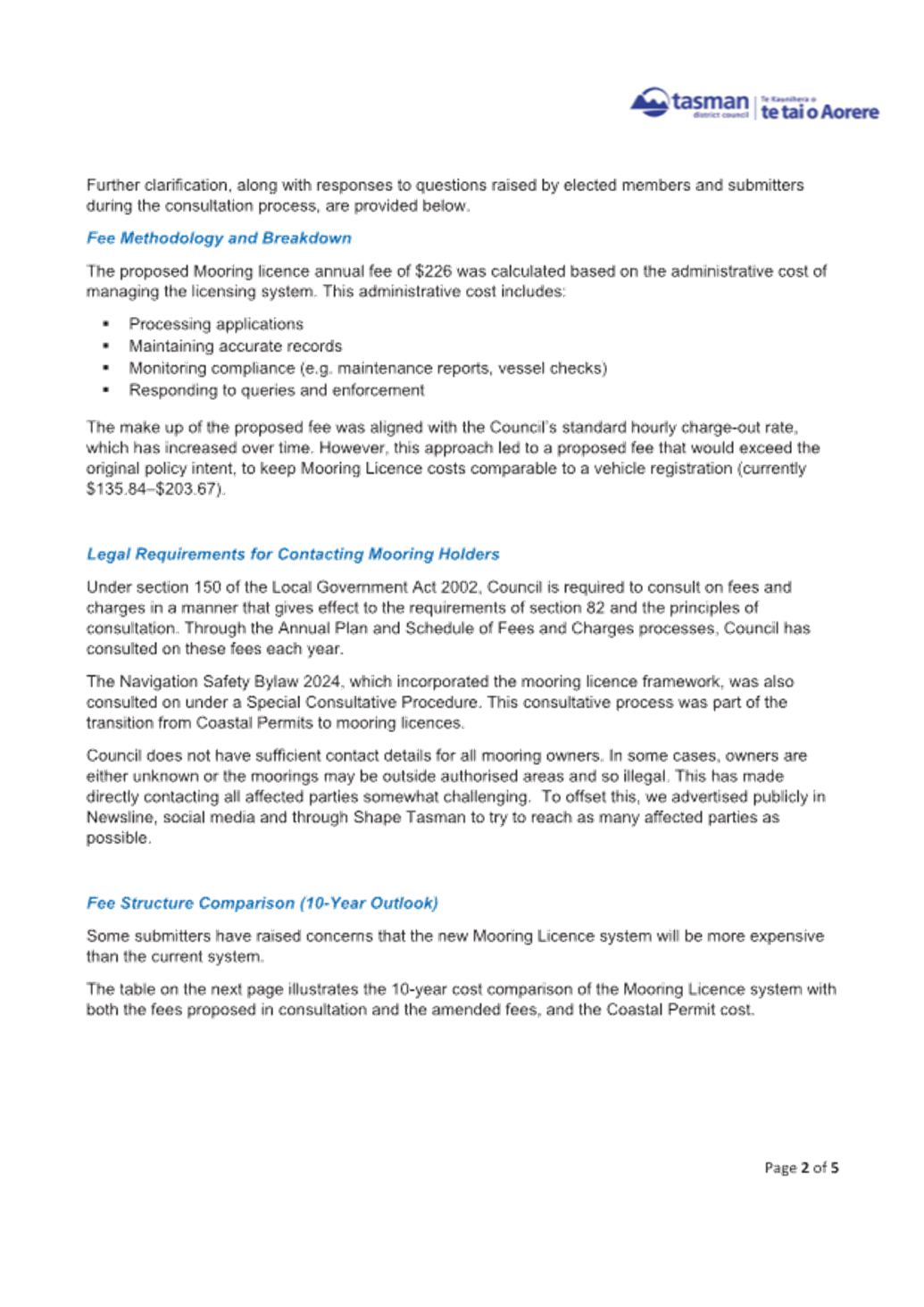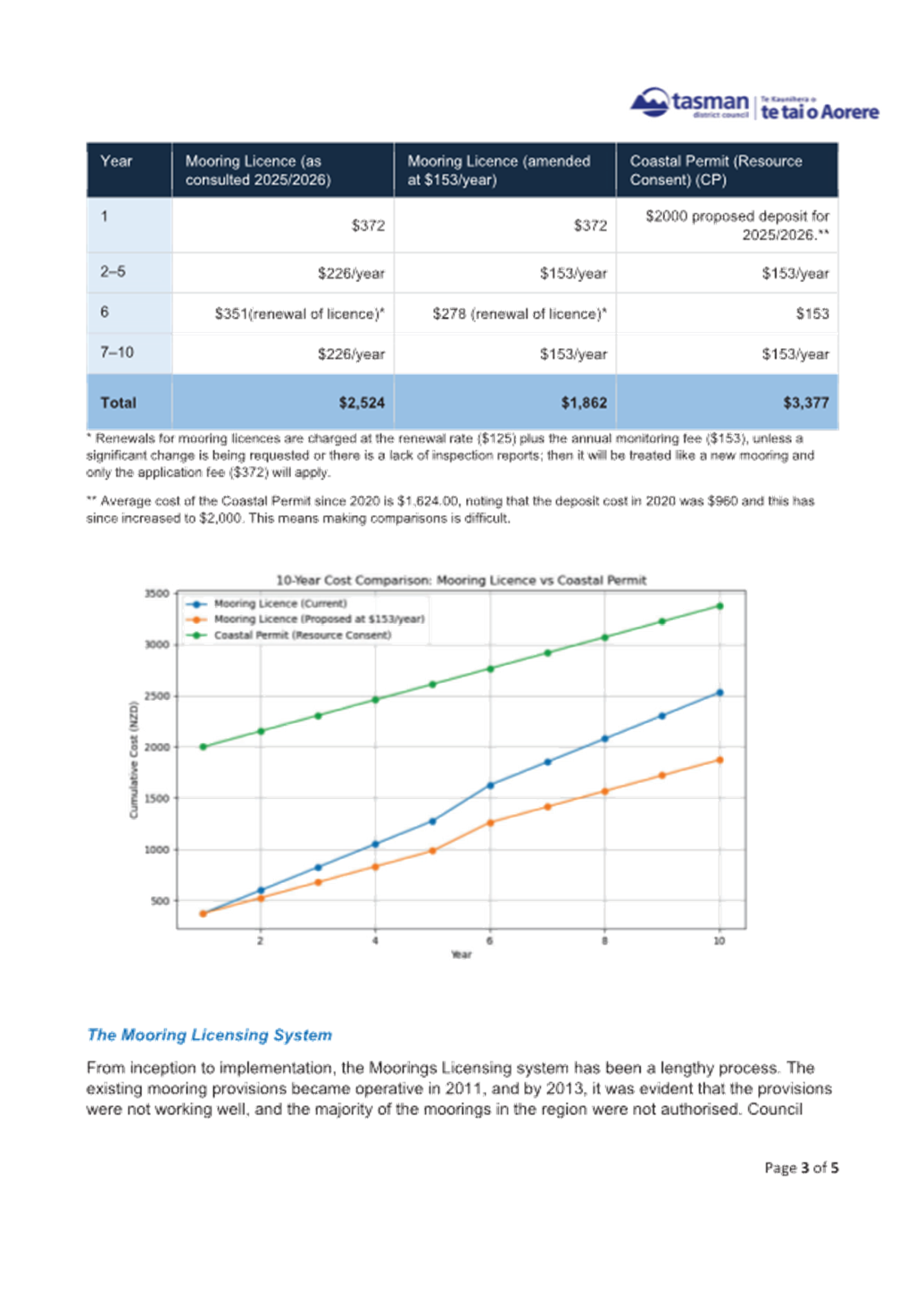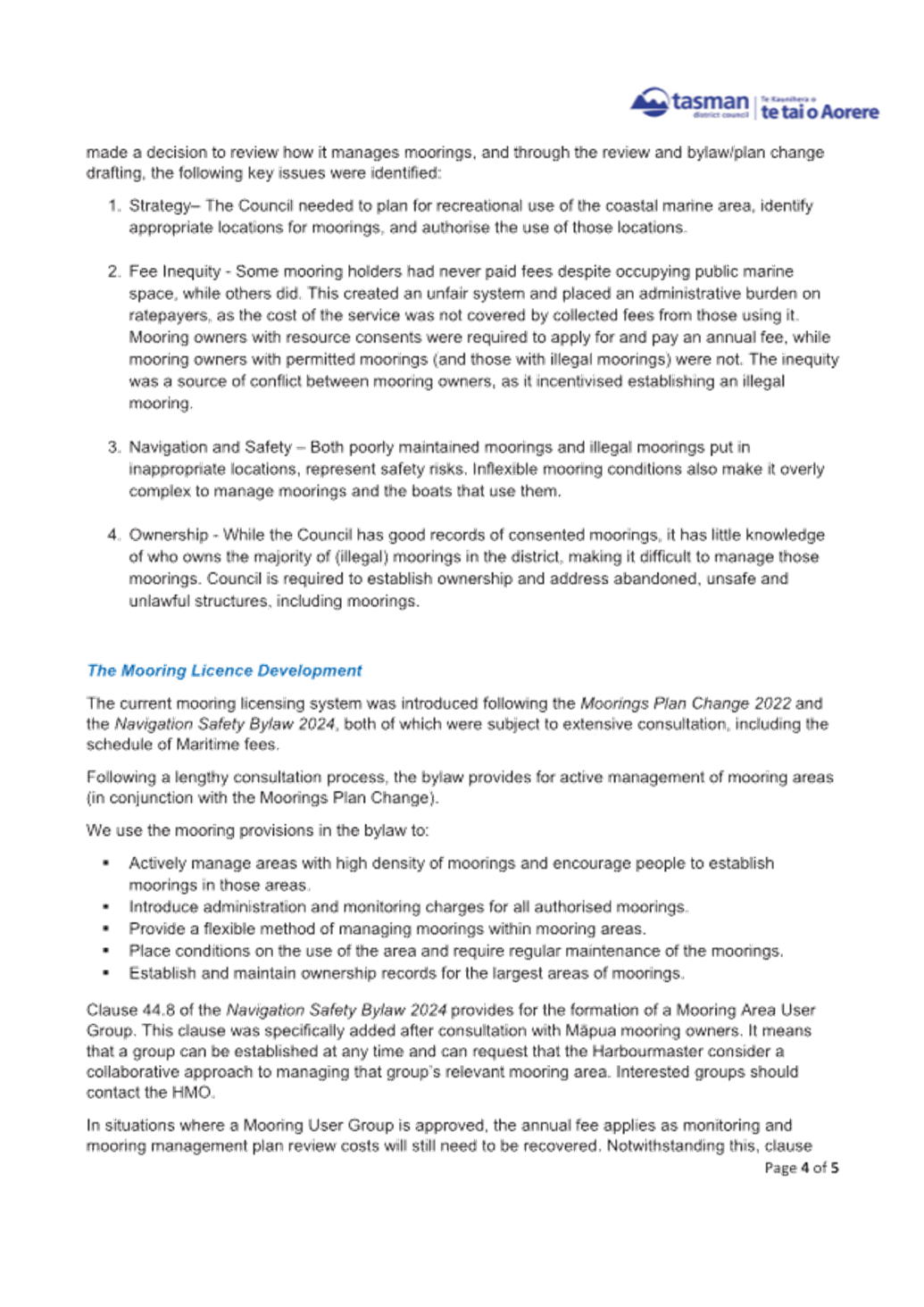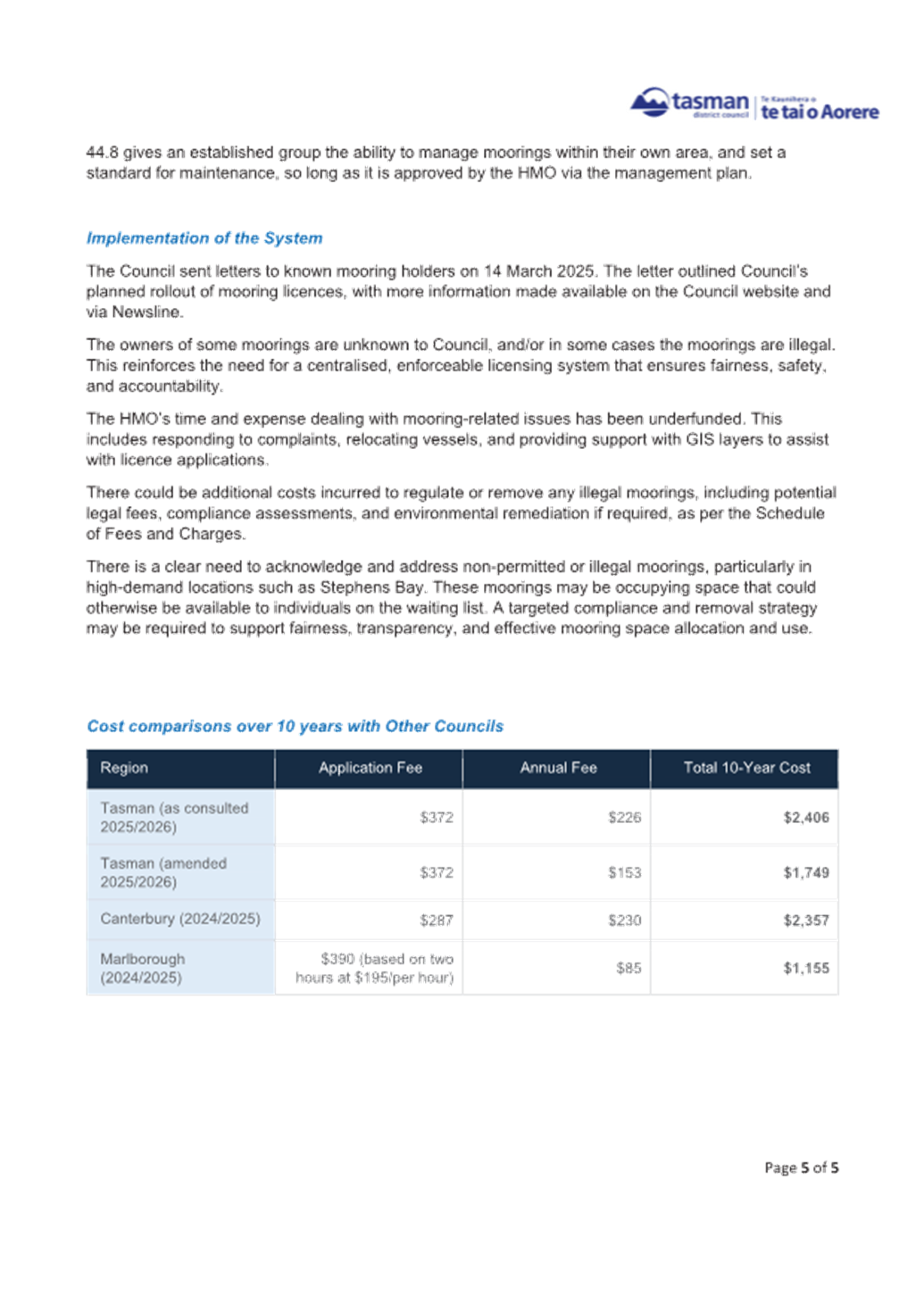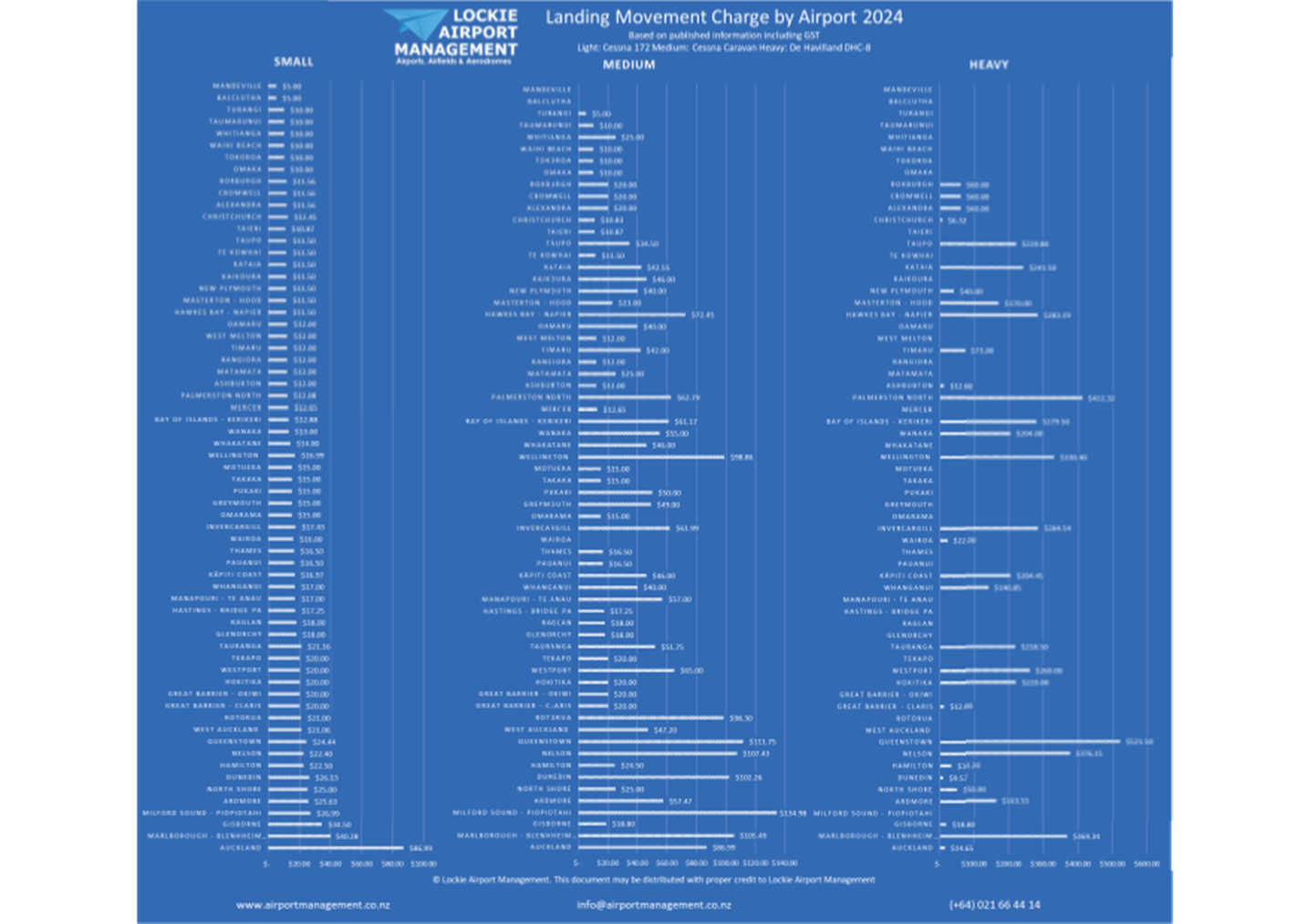Tasman District
Council
Agenda – 27 May 2025
7 Reports
7.1
Draft Development and Financial
Contributions Policy Deliberations
Decision Required
|
Report
To:
|
Tasman
District Council
|
|
Meeting
Date:
|
27
May 2025
|
|
Report
Author:
|
Brylee
Wayman, Senior Community Policy Advisor - Data Analyst; Dwayne Fletcher,
Strategic Policy Manager
|
|
Report
Authorisers:
|
John
Ridd, Group Manager - Service and Strategy
|
|
Report
Number:
|
RCN25-05-21
|
1. Purpose
of the Report / Te Take mō te Pūrongo
1.1 The
purpose of the report is to assist the Council in deliberating on the feedback
received during public consultation on the Draft Development and Financial
Contributions Policy 2024-2034 (2025 Review) (the Policy).
1.2 This
report is also to enable the Council to make decisions on changes to the
Policy.
2. Summary
/ Te Tuhinga Whakarāpoto
2.1 The Development and Financial
Contributions Policy outlines the Council’s approach to funding
development infrastructure via development contributions under the Local
Government Act 2002 (LGA) and financial contributions under the Tasman Resource
Management Plan. During deliberations on the Development and
Financial Contributions Policy 2024-2034, the Council resolved to conduct a
further review of the Policy in 2025. The 2025 review proposed two notable
changes for the Policy, regarding stormwater detention discounts and remissions
for developments on Māori land, and several minor administrative
amendments to the Policy.
2.2 Public
consultation on the 2025 Review of the Policy was open from 24 March to 28
April 2025. A total of 13 submissions were received. There were no late
submissions.
2.3 At
the public hearing on 16 May 2025, seven submitters verbally presented their
submissions on the Policy to the Council.
2.4 In
this report, staff summarise the feedback received and provide advice on
specific issues raised by submitters.
2.5 The
majority of submitters gave feedback on the two notable changes.
2.6 Staff have considered public feedback and recommend
proceeding with the proposed changes.
2.7 Staff
will prepare the final Policy for adoption at the Council meeting on 25 June
2025.
3. Recommendation/s
/ Ngā Tūtohunga
That the Tasman District Council
1. receives
the Draft Development and Financial Contributions Policy Deliberations report, RCN25-05-21;
and
2. notes
the submissions received on the Draft Development and Financial Contributions
Policy 2024-2034 (2025 Review); and
3. agrees
to proceed with the proposed changes in the Draft Development and Financial
Contributions Policy 2024-2034 (2025 Review); and
4. notes
that the Council will be presented with the Development and Financial
Contributions Policy 2024-2034 (2025 Review) for adoption at its meeting on 25
June 2025 and the Policy will come into effect from 1 July 2025.
4.1 The
Development and Financial Contributions Policy outlines the Council’s
approach to funding development infrastructure via development contributions
under the LGA and financial contributions under the Tasman Resource Management
Plan.
4.2 Section 106(6) of the LGA requires the
Policy to be reviewed at least once every three years using a consultation
process that gives effect to the requirements of section 82.
4.3 Following consultation on the
Development and Financial Contributions Policy 2024-2034, the Council concluded
that there were matters raised that warranted further engagement and resolved
to conduct a further review of the Policy in 2025.
4.4 On 20 March 2025, the Council approved the Draft Development and
Financial Contributions Policy 2024-2034 (2025 Review) for consultation. The
2025 review of the Policy includes two notable changes proposed for the Policy,
which relate to the criteria for stormwater detention discounts and the
remissions for developments on Māori land. There are also some minor
administrative amendments to the Policy. There are no changes proposed to the
Development Contribution charges.
4.5 The Policy, including the charges, will
be reviewed again in 2026/2027, as part of the 2027 Long Term Plan, and will
also consider any changes to legislation, national policies, and the Tasman
Resource Management Plan. On 28 February 2025, the Government announced that
development contributions will be replaced by a new development levy system.
The timeline to finalise and implement these changes is not yet confirmed, but
implementation is likely to be two-five years away.
4.6 The
consultation period for the Draft Development and Financial Contributions
Policy 2024 – 2034 (2025 Review) was open between 24 March and 28 April
2005. We received 13 submissions.
4.7 At
the public hearing on 16 May 2025, seven submitters verbally presented their
submissions on the Policy to the Council.
5. Analysis
and Advice / Tātaritanga me ngā tohutohu
5.1 We received 13 submissions. The
majority of submitters gave feedback on the two notable changes proposed for
the Policy, which relate to the criteria for stormwater detention discounts and
the remissions for developments on Māori land (eight submissions each). Two submissions related to minor administrative changes and three
submissions related to the timing and need for the 2025 review of the Policy.
Two submissions also provided feedback on another aspect of the Policy.
Stormwater Detention Discounts
5.2 The proposed change is to limit the
provision of a discount on Stormwater Development Contributions to apply only
to development in the Richmond Intensive Development Area, for developments
which detain primary stormwater to the maximum allowed under Nelson Tasman Land
Development Manual (NTLDM) standards (25% discount would apply).
5.3 Several submitters (34712, 34718 and
34773) suggested a greater differential in development contributions be applied
between dispersed greenfield development and infill, intensive development,
particularly in Richmond.
Staff advice
5.3.1 The Council noted similar feedback during
consultation on the Policy in 2024 and recommended investigating this in
the next triennial review of the Development and Financial Contributions Policy
(scheduled for 2026/2027). That review will also consider a change to the
geographic area eligible for a discount to align with zoning changes in the Tasman
Resource Management Plan, such as the Medium Density Residential Zone which has
been proposed by Plan Change 81. A review of the catchment
boundaries for Development Contributions charges may also result in a
differential between greenfield and infill developments in Richmond.
5.4 Two submitters (34829 and
34830) opposed the change to the current stormwater discount policy. They
suggest developers who install and maintain their own permanent stormwater
detention systems should not have to pay full Development Contributions. They also
suggest that not all developments benefit equally from Council stormwater
networks and a blanket full charge is inappropriate.
Staff advice
5.4.1 As outlined in the consultation material,
the Council has significant investment for stormwater management that is
required to manage the effects of growth, including overland flows, even with
the provision of some on-site stormwater detention. Even with detention, total
run off still increases, which increases total flows downstream, and can still
result in cumulative peak flows increasing. The development areas served by the
Council’s stormwater upgrades are likely to require complimentary detention
to maximise the capacity for growth from these upgrades.
5.4.2 The LGA allows for a common charge to be set
across a grouped geographic area of development, provided the grouping is done
in a manner that balances practical and administrative efficiencies with
considerations of fairness and equity. However, subject to changes in central
government legislation, staff will review the current catchment boundaries as
part of the next review with the 2027 Long Term Plan to ensure the groupings
and charges are appropriate.
5.5 Submitter 34810 suggested the discount
should still apply if temporary or permanent detention was required due to a
delay in Council upgrades to the stormwater network.
Staff advice
5.5.1 Staff do not support this as the Council
would still incur the cost of the longer-term infrastructure solution but
without the full income from development contributions needed to fund that
investment. If a developer develops ahead of the Council’s infrastructure
programme, it will need to fund the infrastructure costs, unless the services
are covered by a development agreement.
5.6 Two
submitters (34802 and 34811) do not support any discount being provided as this
shifts the costs on to others and is not consistent with the fairness and
equity principle of Development Contributions.
Staff advice
5.6.1 Staff recommend investigating changes to the
Development Contributions model, when it is updated as part of the 2027 Long
Term Plan, to account for these discounts when setting the stormwater
development contributions charges.
Remissions for Development on Māori Land
5.7 In 2024, the current Policy introduced
remissions for some developments on Māori freehold land and Māori
customary land in order to meet an LGA requirement that development
contributions policies must support the principles set out in the Preamble to
Te Ture Whenua Māori Act 1993, namely removing or reducing the barriers to
development and full utilisation of the land for the benefit of Māori
landowners, their whānau, and their hapū.
5.8 The proposed change is to extend the
criteria to papakāinga developments on general land held in collective
Māori ownership, or land which has been transferred from the Crown to, and
is held by, a post settlement governance entity as a result of a treaty
settlement. However, the proposed remission is reduced to 50%, at the
Council’s discretion, rather than a full remission of development
contributions for those developments. We also proposed the removal of
the remission for developments on urupā or wāhi tapu sites, and for
any not-for-profit social, cultural, ora, or educational centre developments.
5.9 Three submitters expressed support for
the proposed changes. One of those submitters (34827) suggested the remission
for not-for-profit developments should be retained.
Staff advice
5.9.1 Staff recommend removing
not-for-profit developments, as proposed, as the extension of the criteria to
include developments on general land is a much broader criteria with a greater
risk of financial implications. At its meeting on 20 March 2025, the Council
resolved that no remissions will be provided to not-for-profit community
facilities in general. To be consistent with this approach, the remission has
also been removed for not-for-profit developments on general land in collective
Māori ownership.
5.10 One submitter (34802)
wanted to limit the remission to developments on Māori land, not
development on all land. The Te Ture Whenua Māori Act 1993 defines
Māori land as Māori freehold and customary land.
Staff advice
5.10.1 There is no
developable Māori customary land in the Tasman District and 21 Māori
freehold land titles, most of which is in rural
areas and not likely to be developed or be subject to development contributions
charges (other than transportation). Limiting the criteria to these land
statuses is unlikely to facilitate actual development. Staff recommend proceeding
with the proposed change to extend the criteria to other types of land.
5.11 Submitter 34810 recommended using the Te Ture
Whenua Māori Act 1993 definition of general land owned by Māori. This
means “General land that is owned for a beneficial estate in fee simple
by a Māori or by a group of persons of whom a majority are
Māori.”
Staff advice
5.11.1 Staff recommend keeping the criteria as
general land held in collective Māori ownership to keep consistency with
the remissions provided for other community housing developments. These
remissions are not available for developments on land owned by an individual.
5.12 Submitter 34773 requested the remission be extended
to community housing providers. Submitter 34811 opposef the changes to the
Policy, noting that Development Contributions are a financial barrier for all
residents, and the provision of remissions for papakāinga developments on
Māori land undermines the principles of fairness and equity.
Staff advice
5.12.1 The current Policy provides full remissions
for a list of community housing providers, and any community housing provider
registered with the Community Housing Regulatory Authority.
5.12.2 Staff note that the current Policy provides
a full 100% remission to these developments, meaning there is some
inconsistency with the remission for papakāinga developments.
5.12.3 The remission for community housing
providers is an area that could be reviewed during the next review in
2026/2027. It is out of scope for the changes we have consulted on in this
review.
5.13 Submitter 34818 raised concerns about the remission
applying to the Wakatū Motueka West Development.
Staff advice
5.13.1 This development is not proposed to be a
papakāinga development. The proposed remission for development of
Māori land will not apply to this development. However, parts of the
development may be undertaken by registered community housing providers, and
they will be able to apply for the existing community housing remission.
5.14 Staff note that central government intends to consult soon on a National Environmental Standard (NES)
on papakāinga. The NES will introduce a nationally consistent definition
for papakāinga development. For now, the proposed remissions in the DC
Policy will apply to papakāinga using the current TRMP definition,
although the Council has discretion to consider other factors. We will look to
align with the NES definition in the next review of the Policy. The intention
is that the remissions will apply to papakāinga developments that have
been permitted or consented under national and district planning rules (and
subject to the other remission criteria and considerations in the Policy).
5.15 Overall, staff consider that the proposed changes
strike a balance between supporting the principles set out in the Preamble to
Te Ture Whenua Māori Act 1993, to reduce the barriers to development, and
supporting the LGA principles of fairness and equity for development
contributions on different types of developments.
Other Minor Amendments
5.16 Submitter 34809 expressed support for the change to
clarify which version of the Policy applies when a consent is varied. They also
suggested changes to the Policy in terms of the timing for payments (to be
after the relevant consent/authorisation is exercised) and refunds (to be paid
immediately if the consent is surrendered).
Staff advice
5.16.1 Section 198 of the LGA states the Council
may require a development contribution when a resource or building consent is
granted. Table 4 of the current Policy specifies the timing of invoices for
each type of consent/authorisation. Invoices for development contributions for
subdivision resource consents are not issued until the time of a section 224
application, when any necessary physical works have usually been completed in
exercising the consent. Invoices for building consents and land use resource
consents are issued at the time the consent is granted. The Council previously
tried timing the payment of building consent development contributions to be
closer to the issuing of Code Compliance Certificate (CCC) but found this
process was administratively complex and risked missing some consents. Clauses
76-79 of the Policy provide options for postponing the payment of development
contributions.
5.16.2 The Council can change its payment terms,
but this change will need to be made as part of a subsequent review as it is
out of scope for the changes we have consulted on in this review.
5.16.3 Clause 75 of the current Policy already
notes that Section 209 of the LGA states the circumstances where development
contributions will be refunded, or land returned.
Timing and Need for 2025 Review
5.17 Several submitters questioned the need and timing
of the 2025 review.
Staff advice
5.17.1 Following consultation on the Development
and Financial Contributions Policy 2024-2034, the Council concluded that there
were matters raised that warranted further engagement and resolved to conduct a
further review of the Policy in 2025. This review gives effect to that.
5.17.2 On 20 March 2025, the Council approved the
Draft Development and Financial Contributions Policy 2024-2034 (2025 Review)
for consultation. The consultation has complied with
the LGA, using a consultation process that gives effect
to the requirements of section 82.
6. Financial
or Budgetary Implications / Ngā Ritenga ā-Pūtea
6.1 The proposed change to limit the
criteria for the stormwater detention discount is likely to have a favourable
impact on revenue from Development Contributions. This is estimated to amount
to at least $400,000 a year in extra revenue, assuming approximately 80 new
lots/dwellings per year in the Waimea catchment would have got a 25% discount
and 15 new lots/dwellings in the Motueka catchment.
6.2 The proposed change to the remissions
for papakāinga developments could potentially reduce the revenue from
Development Contributions but is not expected to be a significant amount on an
annual basis.
6.3 These changes have not been incorporated
in the 2025/2026 Annual Plan financial information. Staff recommend
investigating changes to the Development Contributions model, when it is
updated as part of the 2027 Long Term Plan, to account for these discounts and
remissions when modelling development contributions charges and revenue.
7.1 The options are outlined in the
following table:
|
Option
|
Advantage
|
Disadvantage
|
|
1.
|
Staff recommendation
Progress with the proposed changes to the policy and not
make any amendments in response to submissions. Staff will prepare the Development and Financial Contributions Policy 2024-2034 (2025
Review) for approval on 25 June 2025.
|
Consultation on the Policy has been undertaken in
accordance with the Local Government Act 2002, and the community’s
views were considered in the decision-making.
The new Policy can have effect from 1 July 2025.
|
This option does not allow the Council to request further
information on the Policy changes.
Some submitters may be aggrieved that
their views have not be reflected in the final policy.
|
|
2.
|
Progress with the proposed changes to the policy with
amendments in response to submissions. Staff will prepare the Development and Financial Contributions Policy 2024-2034 (2025
Review) for approval on 25 June 2025, including amendments.
|
Consultation on the Policy has been undertaken in
accordance with the Local Government Act 2002, and the community’s
views were considered in the decision-making.
The new Policy can have effect from 1 July 2025.
The other advantages with this option will depend on the
amendments proposed.
|
The public will not have an opportunity to be consulted on
any further changes made at this meeting.
If the changes are major or out of the scope of the
changes consulted on, this may breach the decision-making obligations of the
LGA.
The other disadvantages with this option will depend on
the amendments proposed.
|
|
3.
|
Seek further information from staff and/or carry out
additional consultation, which may result in further changes to the Policy.
|
Enables the Council to request more information on other
changes.
|
If substantive changes are made, the
Policy will require further public consultation.
This would mean the Final Policy would
not be adopted prior to the new financial year, and we would need to continue
providing the stormwater detention discount, resulting in a significant
funding reduction until the next Policy review.
|
|
4.
|
Make no changes to the Development and Financial Contributions Policy 2024-2034.
|
This would satisfy the requests of some
submitters who opposed changes to the Policy.
|
This could damage the Council’s
relationship with iwi as we made a commitment to review the remissions for
development on Māori land this year.
Stormwater detention discount would still
apply, resulting in a significant funding reduction until the next Policy
review.
|
7.2 Option 1 is recommended.
8.1 Section 106(6) of the LGA requires the
Policy to be reviewed at least once every three years using a consultation
process that gives effect to the requirements of section 82. Staff consider
that we have meet this obligation, having:
· consulted using a process similar to the
Special Consultative Procedure, making the consultation material as widely
available as is reasonably practicable and providing an opportunity for persons
to present their views to the Council; and
· notified parties we think have an interest in the matters consulted
on.
8.2 Section 201 of the LGA outlines the
matters which must be included in the Policy, including the conditions and
criteria (if any) that will apply in relation to the remission of development
contributions.
9. Iwi
Engagement / Whakawhitiwhiti ā-Hapori Māori
9.1 The changes to remissions for
developments on Māori land are partly in response to submissions from Iwi
that were received during consultation on the Policy in 2024.
9.2 The review and draft changes have been
communicated to Iwi Trusts at engagement hui in September and October 2024 and
by emails sent in October 2024, January 2025, and during the consultation
period.
10. Significance
and Engagement / Hiranga me te Whakawhitiwhiti ā-Hapori Whānui
10.1 At the Council meeting on 20 March 2025, the
decisions on the Policy as a whole were considered to be of low/moderate
significance.
10.2 Engagement was aligned with
the consultation on the Schedule of Fees and Charges which used a Special
Consultative Procedure. The consultation material was made as widely available
as is reasonably practicable and an opportunity was provided for persons to
present their views to the Council.
10.3 The decisions in this report are whether to
proceed with or amend the proposed changes to the Policy, as consulted on.
These decisions are considered to be of low/moderate significance overall.
|
|
Issue
|
Level of
Significance
|
Explanation of
Assessment
|
|
1.
|
Is there a high level
of public interest, or is decision likely to be controversial?
|
Low/moderate
|
The removal of
stormwater detention discounts is expected to be of high interest to the
development community.
The remission for papakāinga developments is expected to be of high interest to owners
of land in collective Māori ownership and Iwi.
|
|
2.
|
Are there impacts on
the social, economic, environmental or cultural aspects of well-being of the
community in the present or future?
|
Low/moderate
|
The retention of
stormwater detention discounts for developments in the Richmond Intensive
Development Area is expected to incentivise infill development, improving
housing supply and housing choice.
The remission for papakāinga developments will facilitate the development of papakāinga
on Māori land that has a positive impact on the social and cultural
wellbeing of residents.
|
|
3.
|
Is there a
significant impact arising from duration of the effects from the decision?
|
Low
|
The Policy is
reviewed at least every three years.
|
|
4.
|
Does the decision
relate to a strategic asset? (refer Significance and Engagement Policy for
list of strategic assets)
|
Low
|
|
|
5.
|
Does the decision
create a substantial change in the level of service provided by Council?
|
N/A
|
|
|
6.
|
Does the proposal,
activity or decision substantially affect debt, rates or Council finances in
any one year or more of the LTP?
|
Low
|
The proposed change
will have a minor or positive impact on the Councils finances.
|
|
7.
|
Does the decision
involve the sale of a substantial proportion or controlling interest in a CCO
or CCTO?
|
N/A
|
|
|
8.
|
Does the
proposal or decision involve entry into a private sector partnership or
contract to carry out the deliver on any Council group of activities?
|
N/A
|
|
|
9.
|
Does the proposal or
decision involve Council exiting from or entering into a group of
activities?
|
N/A
|
|
|
10.
|
Does the proposal
require particular consideration of the obligations of Te Mana O Te Wai
(TMOTW) relating to freshwater or particular consideration of current
legislation relating to water supply, wastewater and stormwater
infrastructure and services?
|
N/A
|
|
11. Communication
/ Whakawhitiwhiti Kōrero
11.1 The consultation material was communicated in the
usual Council channels (Shape Tasman, Newsline, social media) as well as in
newsletters to the development and building sector. Emails were sent directly
to developers, and stormwater and planning consultants.
11.2 Thirteen submissions were received, and these have
been published on our website. All submitters had the opportunity to speak to
their submission at the hearing which was held on 16 May 2025.
11.3 The
adopted Policy will be published on the Council’s website and publicised
via Newsline.
12.1 If the changes to the Policy are not approved, the
changes will be delayed until the next review in 2026/2027, as part of
developing the Long Term Plan 2027-2037.
12.2 The delay would have a financial risk as more
developments will continue to be eligible for the stormwater detention
discount.
12.3 There is a reputational risk if no changes are
made, as it may seem the review and consultation were a waste of Council
resources.
13. Climate
Change Considerations / Whakaaro
Whakaaweawe Āhuarangi
13.1 The proposed change to remove the stormwater
detention discount has considered the future impacts on the Council’s
stormwater networks from a changing climate. The proposed change aims to ensure
more funding is available for adequate investment in resilient stormwater
networks for future development.
14. Alignment
with Policy and Strategic Plans / Te Hangai ki ngā aupapa Here me ngā
Mahere Rautaki Tūraru
14.1 The proposed change to keep the stormwater
detention only for developments in the Richmond Intensive Development Area
recognises the Council’s strategic goal of intensification in
Tasman’s existing main centres, according to the Future Development
Strategy 2022-2052.
14.2 Plan Change 81 of the Tasman Resource Management
Plan (TRMP) is likely to change the areas zoned for intensification and for
papakāinga. The Policy reflects the current TRMP and will need to be
reviewed once Plan Change 81 has legal effect.
15. Conclusion
/ Kupu Whakatepe
15.1 The 2025 review of the Policy has identified
two notable changes, which relate to the criteria for stormwater detention
discounts and the remissions for developments on Māori land, as well as
several minor administrative amendments. Overall, these changes are expected to
have a favourable impact on the Council’s finances while also achieving a
positive impact on housing choice by incentivising intensification and papakāinga.
15.2 Public
consultation on the 2025 Review of the Policy was open from 24 March to 28
April 2025. A total of 13 submissions were received. There were no late
submissions.
15.3 The
majority of submitters gave feedback on the two notable changes.
15.4 Staff have considered public feedback and recommend
proceeding with the proposed changes.
16. Next
Steps and Timeline / Ngā Mahi Whai Ake
16.1 Staff
will prepare the policy for adoption on 25 June 2025, including any amendments
sought by the Council. The Policy will come into effect from 1 July 2025.
16.2 There are no changes proposed to the Development
Contribution charges, which were set on 1 July 2024 and were updated to reflect
the capital costs from the infrastructure programme in Tasman’s 10-Year
Plan 2024-2034. However, these charges will be adjusted for inflation from 1
July 2025.
16.3 The
adopted Policy and inflation-adjusted charges will be published on the
Council’s website and publicised via Newsline. The
adopted Policy and inflation-adjusted charges will be published on the
Council’s website and publicised via Newsline and newsletters to
the development and building sector. Staff will also email all submitters
with the outcomes of the Council’s decisions, and will
update developers and stormwater and planning consultants.
Nil
Tasman District
Council
Agenda – 27 May 2025
7.2 Schedule of Fees and Charges 2025/2026 -
Deliberations
Decision Required
|
Report
To:
|
Tasman
District Council
|
|
Meeting
Date:
|
27
May 2025
|
|
Report
Author:
|
Emily
Garland, Graduate Community Policy Advisor
|
|
Report
Authorisers:
|
Alan
Bywater, Team Leader - Community Policy; John Ridd, Group Manager - Service
and Strategy
|
|
Report
Number:
|
RCN25-05-22
|
1. Purpose
of the Report / Te Take mō te Pūrongo
1.1 The
purpose of the report is to assist the Council in deliberating on the feedback
received during public consultation on the Draft Schedule of Fees and Charges
2025/2026 (the Schedule).
1.2 This
report is also to enable the Council to make decisions on the Schedule.
2. Summary
/ Te Tuhinga Whakarāpoto
2.1 Public
consultation on the Schedule was open from 24 March to 28 April 2025. A total
of 63 submissions were received by the closing date. There was one late
submission received on 29 April 2025.
2.2 At
the public hearing on 16 May 2025, 13 submitters verbally presented their
submissions on the Schedule to the Council.
2.3 In
this report, staff summarise the feedback received and provide advice on
specific issues raised by submitters.
2.4 Overall,
submitters were concerned about the general increase of 10%, giving feedback
that the increase exceeds inflation, lacks justification, and
places undue strain on households and businesses.
2.5 Almost three-quarters of submitters provided feedback on the
proposed increases to dog registration fees. The majority opposed the increase,
stating it was unjustified and offered no additional benefit to dog owners.
2.6 Several
submitters opposed the proposed increases to waste disposal and recycling fees,
raising concerns about affordability and the risk of increased illegal dumping.
2.7 Six
submitters opposed the proposed Maritime fees, particularly to mooring licences
in the Māpua area, citing poor justification, lack of consultation, and
concerns about excessive costs and bureaucracy.
2.8 Submitters
gave feedback to other fee areas including Aerodrome fees and the new
environmental incident inspection charge. These are detailed, along with other
fee areas that received feedback, in the table in section 5.4 of this report.
2.9 Staff
have considered the feedback received through submissions and have made
recommendations concerning changes to the Draft Schedule.
2.10 Staff
recommend making changes to the:
· Waste disposal
charges in response to the feedback received through submissions. Staff advice
and recommended changes are detailed in Attachment 2. The recommended
change to the mixed refuse fees at Refuse Recycling Centres will require a
0.43% increase in rates revenue. This change is recommended to reverse revenue
losses at the Richmond and Māriri Resource Recovery Centres and avoid
increased instances of illegal dumping.
· The annual
monitoring and administration fee for Mooring Licences under the Maritime
section in response to submissions and to align the fee with the annual
monitoring charge for moorings under the coastal permit process.
· Removal of the
road stopping fee under the Community Infrastructure section as this fee is
already charged in the Property Services section of the Schedule.
· Description of the
property enquiry file fee as property files are not provided through USB for
security reasons.
· Gravel and Shingle
Extraction fees description, changing the mass to volume conversion from 1.8
tonne = 1 m3 to 2.0 tonne = 1 m3 as that is the value
used when invoicing contractors.
2.11 Water
supply charges to Nelson City Council and the Nelson Industrial Water Supply
Area are calculated from proposed rates in the Annual Plan process. Interested
and affected parties are being consulted and feedback will be available during
the Annual Plan 2025/2026 deliberations.
2.12 Staff
will prepare the final Schedule for adoption at the Council meeting on 25 June
2025.
3. Recommendation/s
/ Ngā Tūtohunga
That the Tasman
District Council
1. receives
the Schedule of Fees and Charges 2025/2026 - Deliberations report,
RCN25-05-22; and
2. notes
the submissions made on the Draft Schedule of Fees and Charges 2025/2026; and
Waste Management Fees
3. notes
that resolutions 5. to 9. below will require an increase in rates revenue of
approximately 0.43%; and
4. notes
that resolutions 5. to 9. will result in a portion of Waste Management being
funded from rates, which is contrary to the Revenue and Financing Policy; and
5. agrees
to reduce the weight-based charge for mixed refuse at Refuse Recycling Centres
from the proposed $425.50/tonne to $404.80/tonne; and
6. agrees
to reduce the volume-based charge for mixed refuse from $85.00/m³ to
$80.50/m³; and
7. agrees
to reduce the mixed refuse ‘60 litre bag’ from $4.30 to $4.10; and
8. agrees
to reduce the light wastes surcharge for mixed refuse from $353/m³ to
$334.65/m³; and
9. agrees
to reduce the minimum domestic weighbridge transaction for mixed refuse from
$7.70/20kg to $4.10/10kg; and
10. in
accordance with section 80 of the Local Government Act 2002 the Council:
· agrees that in
adopting resolutions 5. to 9. it is acting inconsistently with the Revenue and
Financing Policy by partially funding waste disposal through rates to reduce
the increase for users; and
· agrees that the
reason for this inconsistency is to reduce the risk of more waste being
diverted from resource recovery centres directly to York Landfill and instances
of illegal dumping; and
· indicates its
intention to consider amending the Revenue and Financing Policy with regards
Waste Management as part of its Long Term Plan 2027-2037 process; and
11. agrees
to reduce the minimum domestic greenwaste charge from $5.50 to $2.20 and
specify in the fee description that this is for increments of 10kg; and
12. agrees
to reduce the charges for mixed recycling and for clean corrugated cardboard
from $359.95/tonne to $300.00/tonne; and
13. agrees
to increase the fee for colour sorted glass recycling from $25.30/tonne to
$85.00 per tonne; and
14. agrees
to increase the Tasman District Council sale price of Kerbside Collection
Rubbish bags from $6.40 to $6.50 for big bags (60 litres); and
15. agrees
to retain the annual fee for additional kerbside recycling services at the
proposed $156 per annum to account for the cost of delivery and invoicing; and
16. agrees
to amend the delivery and collection fee to now be a collection fee (as
presented in the Waste Management table in Attachment 2 to this report), as the
delivery cost has been accounted for in the annual fee for additional kerbside
recycling services; and
17. agrees
to amend the ‘Fee to recover unacceptable and undeclared waste’ to
‘Fee to recover unacceptable and undeclared materials’; and
18. agrees
to amend the heading for greenwaste from ‘Greenwaste (where
accepted)’ to ‘Greenwaste (not accepted at Richmond)’; and
19. notes
staff intend to review waste disposal charges in November 2025 and that the
Chief Executive Officer has the delegation to amend these charges, as set out
in S3.11 of the Council’s Delegation Register; and
Other Fee Areas
20. confirms
the Dog Control fees as listed in the Draft Schedule of Fees and Charges
(Attachment 1 to the agenda report); and
21. agrees
to reduce the annual monitoring and administration fee for mooring licences
from the proposed $226.00 to $153.00, in line with the annual charge for moorings
under coastal permits; and
22. confirms
the Building Assurance travel fee as listed in the Draft Schedule of Fees and
Charges (Attachment 1 to the agenda report); and
23. confirms
the Aerodrome fees as listed in the Draft Schedule of Fees and Charges
(Attachment 1 to the agenda report); and
24. confirms
the proposed environmental incident inspection charge as listed in the Draft
Schedule of Fees and Charges (Attachment 1 to the agenda report); and
25. confirms
the property file fees as listed in the Draft Schedule of Fees and Charges
(Attachment 1 to the agenda report); and
26. confirms
the official information requests fee (LGOIMA) as listed in the Draft Schedule
of Fees and Charges (Attachment 1 to the agenda report); and
27. confirms
the Cemetery fees as listed in the Draft Schedule of Fees and Charges
(Attachment 1 to the agenda report); and
28. notes
that Water Supply charges to Nelson City Council and the Nelson Industrial
Supply Area are being consulted on separately from this process and considered
as part of the Annual Plan 2025/2026 process; and
29. notes that the
property information file fee description will be revised to reflect that files
are shared via ShareFile links, not USB; and
30. notes that the Gravel and
Shingle Extraction fees description will be revised to change the
mass-to-volume conversion from 1.8 tonne = 1 m3 to 2.0
tonne = 1 m3; and
31. notes the removal
of the road stopping fee under the Community Infrastructure section as this fee
is duplicated in the Property Services section of the Draft Schedule of Fees
and Charges (Attachment 1 to the agenda report); and
32. notes the correct road
stopping fee is $825 as this better reflects the initial administrative costs
of considering road stopping applications; and.
33. subject
to resolutions 3. to 32. confirms the remaining fees in the Draft Schedule of
Fees and Charges published for consultation (Attachment 1 to the agenda
report); and
34. adopts the Dog Control fees set out in the Draft
Schedule (Attachment 1 to the agenda report), to allow for public notification in the month before
the fees take effect, in accordance with the Dog Control Act 1996.
4.1 The Council may set fees and charges to recover the costs associated
with providing its services. Staff review these fees and charges annually and
recommend changes, additions, or deletions through the Schedule of Fees and Charges.
4.2 This year, the Council proposed a 10% increase to most fees and
charges. This increase accounts for the significant rising costs of
delivering Council services and aligns with the proposed rates
revenue increase of 10.2% (including growth), for 2025/2026. The increase helps
maintain the ratio of funding from fees and charges, in line with the Revenue
and Financing Policy. Increasing fees and charges reduces the impact of
service cost increases on ratepayers but increases the costs to users of
Council services.
4.3 Staff prepared a Statement of Proposal for the Draft Schedule of
Fees and Charges 2025/2026, seeking Council approval to consult the public. The
proposal sets out the following changes, outside of the standard 10% increase:
4.3.1 Some fees are increasing above the 10% increase to adequately
recover service costs from users, such as dog registration charges, cemetery
interment charges, and the LGOIMA half hourly rate.
4.3.2 Some fees are increasing by less than 10% as the standard
increase was not necessary in order to sufficiently recover costs, including
Aerodrome fees, hourly charge-out rates for Resource Management fees, and some
Waste Management fees.
4.3.3 To improve cost recovery from users, several new charges are
proposed. These include a Building Assurance travel fee for Lakes-Murchison and
Golden Bay, a working dog registration fee, and a LIM cancellation fee.
4.3.4 Some fees are proposed to remain unchanged from last year’s
Schedule, as they are already recovering costs. These include Gravel and
Shingle Extraction fees (except for monitoring rates), Port Tarakohe penalty
charges, and most Maritime fees.
4.4 At
its meeting on 20 March 2025, the Council adopted the Statement of Proposal for
the Draft Schedule of Fees and Charges 2025/2026 (Attachment 1) and to
publicly consult on the Schedule.
4.5 The
consultation was open from 24 March to 28 April 2025. Copies of the Schedule
were made publicly available on Shape Tasman and at the Council’s
libraries and offices. Media releases were made via social media and Newsline.
Managers were asked to notify users of their service areas likely to be
affected of the consultation. Notice of the consultation was also included in
the April Resource Consents and Building Assurance newsletters.
5. Analysis
and Advice / Tātaritanga me ngā tohutohu
Schedule Of Fees and Charges 2025/2026.
5.1 There
were 64 submissions received to the Draft Schedule of Fees and Charges
2025/2026, including one late submission. The entirety of submissions has been
provided to the Mayor and Councillors on LG Hub and are also available for
viewing by the public on the Council’s website.
For comparison, we received 132 submissions in 2024/2025 (in conjunction with
Tasman’s 10-Year Plan), 20 submissions in 2023/2024 and 15 submissions in
2022/2023.
5.2 Thirteen
people spoke to their submission at the public hearing on 16 May 2025.
5.3 The
main topics, issues, and concerns of submitters were:
|
Theme/Specific
Mention
|
Number of
submissions
|
|
Disagree with the 10% increase to most
fees
|
16
|
|
Fees should only be increased by inflation/CPI
|
7
|
|
The Council should look for internal
efficiencies
|
13
|
|
Emphasis on the financial climate/cost of
living crisis
|
12
|
|
Oppose the dog registration increase
|
39
|
|
The removal of bins and dog bags
|
24
|
|
Dog registration fees provide nothing/ask
what they’re for
|
12
|
|
More dog education is needed
|
10
|
|
Want discounts for certain dog owners
|
4
|
|
Oppose the waste fees increases
|
7
|
|
Worry of increased fly-tipping
|
6
|
|
Pro user-pays
|
6
|
|
Oppose the Maritime fees
|
6
|
5.4 The
following table summarises the main points of feedback made by submitters with
associated staff advice and recommendations.
|
Key Submission Points
|
Staff Comment and
Recommendation
|
|
General Fee
Increases
|
|
Sixteen (16) submissions specifically
opposed the proposed 10% increase in fees and charges. Submitters argued the
increase exceeds inflation, lacks adequate justification, and unfairly
burdens households and businesses already facing economic pressure. Many call
for the Council to prioritise cost savings and internal efficiencies,
particularly in staffing and operations, before raising charges. The
“user pays” rationale is widely questioned, with concerns the
increases fund poorly managed or unnecessary projects. Overall, submitters
called for fee increases to be limited to inflation and for greater
transparency, accountability, and community engagement from the Council.
|
Staff acknowledge the concerns raised by submitters about the
proposed 10% increase in fees and charges. While the general increase is 10%,
this varies in some cases for specific reasons. The proposed increases align
with the Council’s Revenue and Financing Policy and Activity Management
Plans, which sets the level of funding to be sourced from user fees versus
rates for each activity. For example, the building activity is intended to be
funded 80–100% through user fees, with the remaining 0–20% from
rates. These funding bands are in place across all Council activities and
were adopted through prior Council decisions.
The cost base for many services has grown more than inflation due
to additional costs, such as increased depreciation with more of these costs
being funded from revenue, the new Water Services Levy, and sampling
obligations imposed by central government. To maintain the intended revenue
ratios and reduce pressure on rates, an increase above the Consumer Price
Index (CPI) for most fees is necessary. Without the 10% adjustment to fees,
the rates revenue increase for 2025/2026 would need to be higher to make up
the shortfall, undermining the user-pays principle.
While staff continue to seek internal efficiencies and cost
savings, many of the services funded by fees are subject to externally driven
and rising costs.
It is also important to note that CPI is not the most appropriate
cost inflation adjustor for local government. The CPI reflects household
goods rather than the cost pressures faced by councils (milk and bread versus
oil and earthworks). Instead, the Council uses the Local Government Cost
Index developed by BERL (Business and Economic Research Ltd), which more
accurately reflects inflation in the sector.
The Statement of Proposal for the Draft
Schedule of Fees and Charges 2025/2026 was drafted to be accessible and
easily understood. This meant that detailed explanations for each individual
fee could not be provided. With hundreds of fees across numerous activities,
it is not feasible to present a full justification for every line item. Under
current legislation, formal public consultation is not required for the
majority of fee changes.
However, we remain committed to
transparency and to providing the opportunity for community feedback on
matters that affect them. Further refinements to how fees are communicated
will be considered as part of ongoing improvement work.
Staff recommend proceeding with the
general 10% increase, noting that this increase is not universal and takes
pressure off rates.
|
|
Dog Registration Fees
|
|
Forty-one (41) submitters gave feedback
on the proposed dog registration fee increases. Most opposed the change,
saying it was unjustified, offered no clear benefits, and meant responsible
owners were subsidising irresponsible ones.
Concerns were raised that higher fees
could lead to more unregistered dogs, and that older residents might struggle
to afford registration for their companions.
About a quarter of submitters wanted more
focus on educating visitors about responsible dog ownership, especially in
peak season. Supporters of the increase argued that fees should reflect the
real cost of dog control and help fund safety and education efforts.
Many also criticised the planned removal
of rubbish bins and dog waste bag dispensers, saying these were the only
visible benefits of registration and their removal would lead to more mess.
Overall, submitters felt the increases,
and the shift to in-house services, were not well explained.
|
Staff proposed the second step of an
increase in dog registration fees to ensure the service is fully funded. Fees
have previously been kept low, but this does not cover the costs of
delivering dog control services, which include:
- Enforcement
- Responding to complaints
- Maintaining the National Dog Database
- Managing public safety
- Operating the animal shelter
- Rehoming dogs
- Delivering education initiatives
After the previous contract ended in
September 2024, the Council temporarily brought
additional elements of the dog control service in-house pending a review. The
review found that the comprehensive in-house model provides better service
but at a higher cost than the former contract. However, the contractor had
made it clear that maintaining a service at the price of the former contract
was not financially viable. Providing services in-house enables a more
proactive approach to compliance. It also offers greater flexibility in
responding to legislative or regulatory changes, without the limitations of a
contract. Full in-house delivery gives the Council more control over staff
training, performance, and accountability, helping to ensure the service
aligns with our policies and standards. In March 2025, the Council resolved
to continue with in-house delivery. The increased costs of providing
the service need to be funded.
The urban dog
registration fee increased by only $3 between 2011 and 2023. A larger
increase is now needed to keep the service as user-pays, in line with the
Public Health & Safety Activity Management Plan.
Staff acknowledge the particular service needs in different areas, which
is why they have proposed a new fee category for working dogs.
Some submitters raised concerns about the
removal of dog waste bins and bag dispensers. Staff note that the budget for
these does not come from dog registration fees but from the Reserves budget,
which is funded through rates. Under Section 9 of the Dog Control Act 1996,
revenue from registration fees can only be used for dog control activities
and not for general services like rubbish collection in reserves. The Council
rescinded the decision to remove the bins and dispensers on
8 May 2025.
Further information on options to change
dog control fees in response to submissions is contained in Section 6 of this
report.
Staff recommend proceeding with the
proposed increases to dog registration fees.
|
|
Working Dog
Fee
|
|
Six submitters mentioned the new working
dog registration fee. Many felt that working dogs, especially farm dogs,
receive little or no service from the Council and therefore should not be
subject to high registration fees.
Several submitters argue that the fees
are unfair, some suggested that farm dog owners were subsidising urban dogs,
while one submitter believes all dog owners should pay the same. The majority
support reduced fees for working dogs, with suggestions including halving the
standard fee and giving owners of multiple dogs a discount or capping the
total charge.
|
The Working Dog fee is a newly proposed
category within the schedule of fees and charges. This new fee, and the lower
rate compared to the urban and rural dog categories, recognises the lower
level of service typically required by working dogs. In previous years those
animals in the new working dog category would have been categorised as rural
or urban dogs and charged at a comparatively higher level.
While the proposed fee is lower than the
other categories, it is set to recover the cost of providing and maintaining
core dog control services, which must be available to all dog owners when
needed. The fee equitably balances the lower service demand with the need for
ongoing service availability and financial sustainability.
Staff recommend proceeding with the new
working dog fee at the proposed rate.
|
|
Waste Fees
|
|
Several submitters opposed the proposed
increases to waste disposal and recycling fees, raising concerns about
affordability and the risk of increased illegal dumping. They questioned the
size of the increases, especially where they exceed the general 10% rise, and
noted inconsistencies between transfer station and landfill fees. Some
submitters also suggested the changes could discourage recycling and called
for clearer justification and more competitive pricing.
|
The staff response to waste fee
submissions is detailed in Attachment 2.
In response to submissions, staff
recommend reducing the level of increase for mixed refuse fees from 18% to
12%. This change is recommended due to the significant reduction in tonnage
compared to forecasted in Tasman’s 10-Year Plan 2024-2034. The recommended
changes are intended to reduce the quantity of waste being diverted from
resource recovery centres to landfills and instances of illegal dumping.
Other changes have been recommended and are outlined in Attachment 2.
|
|
Maritime Fees
|
|
Six submitters opposed the proposed
Maritime fees, particularly the mooring licences in the Māpua area. They
see the fees as excessive and poorly justified, raising concerns about lack
of consultation, increased bureaucracy, and unclear benefits. Some questioned
whether more cost-effective service options had been considered, such as community
management.
|
The staff response to Maritime fee
submissions is detailed in Attachment 3.
In response to submissions, staff
recommend reducing the annual monitoring and
administration fee from the proposed $226 (which would have been an increase
from $206 in the current financial year), to $153. This aligns the fee with
the annual charge for Coastal Permits, reflecting the original intent of the
system to cost less than a Coastal Permit. This change reduces the long-term
cost burden to mooring licence holders, while maintaining administrative cost
recovery.
|
|
Building Assurance – Travel Fee
|
|
Submissions 34719 and 34832 opposed the
proposed $100 travel fee for building inspection visits to Golden Bay and
Lakes-Murchison, arguing it is unfair and inconsistent with how services are
charged in other parts of the district. They felt all residents should be
treated equally and not face extra costs based on location.
|
The $100
travel fee covers the added cost of providing inspection services in remote
areas like Golden Bay and Lakes-Murchison. The Council could consider funding
these travel costs from general rates but this contradicts the general user
pays approach funding building assurance and could be inconsistent with the
funding ratios in the Revenue and Financing Policy and Activity Management
Plan.
Alternatively,
the Council could increase the fee for all building consents to cover the
anticipated travel costs. However, the number of building consents
(across the District) and the number in the areas where the travel costs
apply, as well as the number of inspections required across the year, are
very variable. As a result, being able to accurately set fees for all
building consents to include the travel costs in these areas would be very
hard to do.
Due to low
inspection demand, these areas don’t have dedicated staff. Instead,
inspectors travel from Motueka (for Golden Bay) and Richmond (for
Lakes-Murchison). Currently we service Lakes Murchison two days per week and
Golden Bay three days per week.
After
reviewing options, a fixed fee to cover travel costs to remote areas was
found to be the fairest and most transparent approach. This aligns with
Section 281B of the Building Act 2004, which supports fee adjustments to meet
actual service costs.
The fee covers
travel from the nearest staffed service centre to the ward’s service
centre. Travel within the ward is already included in the standard inspection
fee.
Remote
inspection tools are being explored and may reduce or remove the need for
this fee for some inspections in future.
Staff recommend proceeding with this new
fee.
|
|
Aerodrome Fees
|
|
Submitters 34721 and 34831 opposed parts
of the proposed fee changes for the Motueka and Tākaka aerodromes. One
submitter argued that fee increases at Motueka are unjustified, noting
increased revenue from other sources, and calls for the fees to be reduced
instead. The other submission was concerned with the clause allowing fees to
be varied under “special circumstances,” saying it lacks
transparency and could lead to unfair decisions.
|
The operational costs of maintaining and
managing the aerodromes continue to rise.
Investments such as the NZ Post building
are undertaken on commercial terms and are not funded through landing fees.
The revenue from this sort of development does not offset the operational
costs that landing fees are intended to recover. While the Motueka aerodrome
is user-pays, the Tākaka aerodrome has been funded 72% by rates in
2024/2025.
All hangars are based upon commercial
terms and therefore any associated income, interest and any other costs are
not considered part of the aeronautical model used to set landing fees.
The following costs are included in the
aeronautical model used to set landing fees:
- Legal fees
- Signage
- Health and Safety inspections
- Runway and ground repairs and maintenance
- Fencing maintenance
- Wildlife management
- CAA compliance – this involves current and constantly
changing regulations and obligations (AIP, meetings, emergency exercises,
signage etc.)
- Notice to Aviator (NOTAM) issuance and monitoring
- Staff management inclusive of planning and operations
Staff obtained an independent review of
landing fees in November 2024 (Attachment 4). The review found that the
average landing fee for a small aircraft around the country is $16.38.
Currently, very few smaller aerodromes in
New Zealand achieve complete cost recovery due to the high costs of
compliance. Blenheim has achieved this and its current charges are $40.29 per
landing for a small aircraft.
Regarding notes in the Aerodrome
schedule, the ability to vary fees under special circumstances is considered
necessary to allow flexibility during the transition to the new fee
structure. This discretion enables the Council to respond appropriately to individual
cases without undermining the overall framework.
Staff recommend proceeding with the
proposed fee increases as consulted.
|
|
Environmental
Assurance – Environmental Incident Inspection Charge
|
|
Submitters 34831 and 34832 oppose the
proposed Environmental Incident Inspection Charge. They argue it is not
legally supported under section 36 of the Resource Management Act and raises
concerns about fairness, efficiency, and due process. Both suggest that
environmental enforcement is a public good and that costs for isolated or
unavoidable breaches should not be imposed on consent holders.
|
This charge recovers costs incurred when
the Council investigates environmental incidents not directly related to a
resource consent. It is made under section 150 of the Local Government Act
2002, not section 36 of the RMA. These inspections are carried out under
section 332 of the RMA to assess compliance, and the charge aligns with
user-pays and polluter-pays principles, ensuring that costs are not unfairly
passed to the wider community. Charges are applied when it is found,
following an investigation, that a breach has occurred. The Council will
apply this fee in line with its enforcement guidelines and will consider the
circumstances of each incident, including emergencies or unavoidable events.
Proposed amendments to the RMA (Clause 10 of the Consenting and Other System
Changes Amendment Bill) are expected to further support this cost recovery
approach. Some other councils across New Zealand charge for this including
Wellington Regional Council and Southland Regional Council.
Staff recommend confirming this new fee.
|
|
Property
Information – Property Enquiries
|
|
Submitter 34722 commented on the Property
Information fee for property files, which is increasing by 10% from $55 to
$59 as excessive, citing the difference in costs between the three councils
of Te Tauihu.
Additionally, they request justification
for the 10% increase in the per annum charge to companies for unlimited
access to property files.
|
Staff acknowledge the
concern regarding the increase in the Property Information fee, and the
comparison with other councils in Te Tauihu. The 10% increase aligns with a
standard adjustment applied across various Council fees and reflects rising
costs, particularly staff time involved in processing property file requests.
Currently, the
property file process is only partially automated. Staff are investigating ways to improve efficiency which
may reduce cost increase pressure in the future and could be reflected in
future charges.
Staff recommend
continuing with the proposed 10% increase.
|
|
Corporate –
Official Information Requests (LGOIMA)
|
|
Submission 34831 opposed the increase in
the LGOIMA half hour charge from $50 to $60. They argue that the increase
lacks justification and goes against the Ministry of Justice guidance of $38
per half hour. They state that the fee disproportionately affects individuals
and non-profits, who rely on official information to monitor and engage with
Council actions. The submitter also asks for fee reductions and exemptions
for community organisations.
|
In the last few
years, the numbers of formal LGOIMAs received by Council has increased from
512 in 2023 to 730 in 2024. This increased number is putting pressure on the
organisation to respond to large requests. Neither the current fee nor
proposed fee come close to recovering the cost of these requests.
The Ministry of
Justice Charging Guidelines have not been updated since 2002 and the
staff’s view is that they no longer reflect the reasonable cost of
responding to LGOIMAs.
This increased amount
is broadly in line with the approach taken by other councils including Nelson
City Council (that has just adopted $50 per half hour for 2025/2026) and
Marlborough District Council (charging $50 per half hour for 2024/2025).
No consideration is
given to a separate rate for community organisations. The focus for staff
when considering whether to charge for a LGOIMA request is on the public
value of the request, as opposed to whether the request is on behalf of a
community organisation. The costs of responding to LGOIMA requests are the
same whatever the type of organisation requesting the information.
Staff recommend
confirming the proposed fee level.
|
|
Cemetery Fees
|
|
Submission 34831 opposed the increase to
adult burial interment fees, ash interment fees, and weekend and late
additional charges, stating that they were unjustified.
|
The proposed
increases to interment fees reflect rising interment costs from our
contractors. These adjustments are intended to ensure that the individuals
using the service cover the associated costs, rather than these being
subsidised by the general ratepayer.
Staff recommend
confirming the proposed fee level.
|
|
Fees Increasing by
more than 10%
|
|
Submission 34831 specifically identified
several fees proposed to increase by more than 10%. The submission stated
that these increases were not justified and noted that some of the fees
exceeding 10% were not mentioned in the Statement of Proposal.
|
These fees have been increased
to ensure the costs of providing specific services are fairly recovered from
users, rather than being subsidised by general ratepayers. Because the cost
components of each fee vary significantly, full breakdowns have not been
provided. Instead, brief explanations are included to give context and to
help users understand the purpose of each fee—particularly those in
specialised areas that are not relevant to most Tasman residents.
Some fees have increased by more
than 10% due to rounding for administrative efficiency. For example, stock
impounding fees have been rounded to the nearest dollar.
|
Water Supply Charges
5.5 Water
Supply Charges to Nelson City Council and the Nelson Industrial Water Supply
Area are calculated based on the income required from rates and water supply
charges to ensure that all water supply users pay equally.
5.6 Consultation
is taking place through direct contact to affected parties. This feedback will
be presented to the Council during the deliberations of the Annual Plan
2025/2026.
5.7 Once
feedback has been considered, these fees will be included into the Final
Schedule for adoption on 25 June 2025.
Recommended Corrections to the Schedule
5.8 Staff recommend
updating the property information file fee description to reflect that files
are shared via ShareFile links, not USB, due to security reasons.
5.9 Staff recommend updating the
Gravel and Shingle Extraction fees description to change the mass-to-volume
conversion from 1.8 tonne = 1 m3 to 2.0 tonne = 1 m3
as that is the value used in practice and 1.8 tonne = 1 m3 is likely too low on average and would unintentionally levy higher
costs on extractors.
5.10 Staff recommend the removal
of the road stopping fee under the Community Infrastructure section as this fee
is duplicated in the Property Services section of the Schedule. The correct fee
is the proposed $825 fee as this better reflects the initial administrative
costs of considering road stopping applications, as compared to the $434 fee
under Community Infrastructure.
Options for Dog Registration Fees
6.1 Due
to the large increase in dog registration fees and the quantity of submitters
opposing the increases, options for elected members have been provided below.
Staff recommend retaining the fees in the Draft Schedule (Option 1).
|
|
Proposed fees
|
Change from 2024/2025 fee
|
Deficit / additional funding from rates
|
|
Option 1 (as consulted)
|
Urban: $90
Rural: $70
Working: $50
|
Increase of $25
38% increase to urban
56% increase to rural
|
$0.00
|
|
Option 2
|
Urban: $85
Rural: $65
Working: $45
|
Increase of $20
31% increase to urban
44% increase to rural
|
$54,113.00
|
|
Option 3
|
Urban: $80
Rural: $60
Working: $40
|
Increase of $15
23% increase to urban
33% increase to rural
|
$108,226.00
|
|
Option 4
|
Urban: $75
Rural: $55
Working: $35
|
Increase of $10
15% increase to urban
22% increase to rural
|
$162,339.00
|
6.2 Note
that the proposed registration fees have been calculated to balance the dog
control account. Any decrease from the proposed registration fees will result
in a deficit in revenue and will need to be funded from rates. Funding dog
control from rates is contrary to what is stated in the Public Health and
Safety Activity Management Plan, which says that the cost of dog control
services will be funded by dog registration fees and recoveries from offending
owners.
6.3 Any
option to stage the increase in dog control fees over several years will result
in a deficit in this closed account. This deficit would either need to be
subsidised by rates or financed by increased borrowing, with the interest and
repayments to be funded by increased rates or higher dog control fees in future
years.
6.4 Any
option to reduce dog registration fees for specific dog owners e.g. those over
65 years of age will result in either the dog registration fees to other dog
owners increasing further or the reduction in revenue being funded by rates. We
do not currently have all dog owners’ ages (as we have had no reason to
collect this information). We would need to model the financial impact of
reducing the dog registration fees for over 65’s and consult on that
option after identifying the full range of costs and benefits. If elected
members are of a mind to explore this option, the date of birth of dog owners
could be collected during the next registration period to enable this option to
be modelled for the 2026/2027 fees. We would also need to assess the likelihood
of younger dog owners transferring ownership to over 65’s as a means of
reducing registration fees for their dogs.
6.5 The
Dog Control Act 1996 (s.37[6]) requires that the Council publicly notify the
Dog Control fees fixed for the registration year, in a newspaper circulating in
the District, at least once during the month preceding the start of every
registration year.
6.6 In
addition, pound fees are required to be adopted at least 14 days before the
resolution comes into effect and be publicly notified in a newspaper
circulating in the District.
6.7 To
enable us to meet these notification requirements, this report includes a
resolution to adopt the Dog Control fees at this meeting. The remainder of the
schedule of fees and charges will be presented for adoption at the 25 June 2025
Council meeting.
7. Financial
or Budgetary Implications / Ngā Ritenga ā-Pūtea
7.1 The
Revenue and Financing Policy states: “An activity should be funded by
users or exacerbators if an individual or group of individuals directly
receives the benefits of the activity or causes the action, and the costs of
the activity can easily be attributed and charged to that individual or group
of individuals”.
7.2 For
each activity, the Revenue and Financing Policy sets, in ranges, the proportion
of costs to be funded by rates, fees and charges, and other sources, expressed
as a range.
7.3 This
Schedule has been developed alongside the proposed rates revenue increase,
which is scheduled for deliberation by the Council on 4 June 2025. The Council
may amend the rates revenue requirement during the Annual Plan 2025/2026
deliberations.
7.4 If,
following deliberations on the Annual Plan 2025/2026, the increase in the rates
revenue varies from the proposed 8.8% (excluding growth), the proportions of
funding from different sources are likely to remain consistent with the ranges
in the Revenue and Financing Policy.
8.1 The options are outlined in the
following table:
|
Option
|
Advantage
|
Disadvantage
|
|
1.
|
Approve the staff recommendations and accept the revised
Draft Schedule of Fees and Charges 2025/2026, including any minor amendments
made at this meeting.
|
Consultation on the Schedule has been undertaken in
accordance with the Local Government Act 2002, and the community’s
views were considered in the staff recommendation.
The new fees can be charged from 1 July 2025 onwards.
|
This option does not allow the Council to request further
information on the fees and charges.
The public will not have an opportunity to be consulted on
any further changes to fees made at this meeting
|
|
2.
|
Decline the staff recommendations and accept the Draft
Schedule of Fees and Charges 2025/2026 as consulted on.
|
The new fees can be charged from 1 July 2025 onwards.
Fees can be charged at the same rates as consulted on.
|
This option does not allow the Council to request further
information on the fees and charges.
The public may feel that their feedback has been
unacknowledged. This may result in a reputational risk.
|
|
3.
|
Decline the staff recommendations and Draft Schedule of
Fees and Charges 2025/2026 in order to receive further information and/or
conduct further consultation.
|
Enables the Council to request more information on
proposed fees and make changes to specific proposed charges before approving
the same for further consultation.
The public will receive another chance to give feedback on
the proposed Schedule before it is adopted.
|
If substantive changes are made, the Schedule (or specific
parts of it) may require further public consultation.
This further public consultation will require staff time
and further input from the public.
This would mean the Final Schedule of Fees and Charges
2025/2026 (or specific parts of it) could not be adopted prior to the new
financial year, and we would need to continue charging the current 2023/2024
fees and charges until the consultation process is completed.
This may result in a shortfall of income for some
activities.
|
8.2 Option 1 is recommended.
9.1 The
Council can set fees and charges:
9.1.1 under section 12 of the Local Government Act (LGA), which is a
global empowering provision that enables the Council to make decisions and
undertake acts and activities in pursuit of its functions;
9.1.2 under section 150 of the LGA for certain functions provided
for in bylaws or in enactments that do not already explicitly provide for fees
to be charged;
9.1.3 under section 36 of the Resource Management Act 1991;
9.1.4 under section 205 of the Food Act 2014;
9.1.5 under other government legislation as noted in the Draft
Schedule.
9.2 The
draft schedule outlines the legislation that the fee is made under.
9.3 If
the Draft Schedule is not adopted prior to 1 July 2025, the Council may not be
able to recover the expected costs for some services that are provided. The
2024/2025 charges would apply by default until the Council adopted a new
Schedule for 2025/2026 or part thereof.
9.4 Section
37(6) of the Dog Control Act 1996 establishes the public notification
requirements for Dog Control fees in general and section 68(2) establishes the
public notification requirements for pound fees. The Dog Control Act 1996
(s.37[6]) requires that the Council publicly notify the Dog Control fees fixed
for the registration year, in a newspaper circulating in the District, at least
once during the month preceding the start of every registration year.
10. Iwi
Engagement / Whakawhitiwhiti ā-Hapori Māori
10.1 Iwi were notified of the consultation on changes to the Schedule via
email, sent to the CEOs and Pou Taiao of our nine iwi partners. The email
included a summary of the consultation, key submission dates, a link to submit
via Shape Tasman, and the option to email a submission directly. The decision
to send this email was guided by the advice of Council’s Kaihautū
Hononga. No feedback was received.
11. Significance
and Engagement / Hiranga me te Whakawhitiwhiti ā-Hapori Whānui
11.1 At
the Council meeting on 20 March 2025, the decision to consult was considered to
be of low/medium level of significance.
11.2 The
Draft Schedule of Fees and Charges 2025/2026 has been consulted on through the
Special Consultative Procedure (SCP). This is because fees set under the
Resource Management Act 1991 and Food Control Act require an SCP. Subsequently,
the Council resolved to consult on the entire Draft Schedule using an SCP, to
ensure transparency and public participation.
11.3 The
decisions in this report are whether to retain the majority of the Schedule as
consulted on and make the changes recommended following consultation, retain
the entire Schedule as consulted on, or decline the Draft Schedule until
further information is provided and/or further consultation is undertaken.
11.4 The
decisions in this report are considered to be of low/medium significance
overall to most members of the public, while some fees and charges may have a
high level of significance to specific people, for example, those residents on
fixed incomes and who use services that the Council charges for.
|
|
Issue
|
Level of
Significance
|
Explanation of
Assessment
|
|
1.
|
Is there a high level
of public interest, or is decision likely to be controversial?
|
Medium
|
Public interest in the Schedule
during the consultation period was lower than in the previous year (64
submissions compared to 132).
However, there remains a
moderate level of public interest in the Council’s financial position.
This interest has grown following recent cost-saving measures implemented by
the Council, including communications related to the Annual Plan 2025/2026 and
the removal of rubbish bins and dog bag dispensers from reserves. The latter,
in particular generated significant public engagement, especially in relation
to the proposed increase in dog registration fees.
|
|
2.
|
Are there impacts on
the social, economic, environmental or cultural aspects of well-being of the
community in the present or future?
|
Low-medium
|
The Schedule will
have a minor impact on the economic wellbeing of the community through
increased costs to specific users of Council services.
|
|
3.
|
Is there a
significant impact arising from duration of the effects from the decision?
|
Low
|
The Schedule is
assessed annually, the Council can reconsider the decision as part of the
same process in a year’s time, alongside the Long Term or Annual Plan
process.
|
|
4.
|
Does the decision
relate to a strategic asset? (refer Significance and Engagement Policy for
list of strategic assets)
|
No
|
|
|
5.
|
Does the decision
create a substantial change in the level of service provided by Council?
|
Low
|
If fees are not
increased to the levels recommended by staff it may result in service cuts,
decreasing levels of service.
|
|
6.
|
Does the proposal,
activity or decision substantially affect debt, rates or Council finances in
any one year or more of the LTP?
|
Medium
|
The decisions on the
Schedule are part of the Council’s plan to fund its activities and
services in the 2025/2026 year. If fees are not increased sufficiently to
recover service costs, then more funding will be required from rates.
|
|
7.
|
Does the decision
involve the sale of a substantial proportion or controlling interest in a CCO
or CCTO?
|
No
|
|
|
8.
|
Does the
proposal or decision involve entry into a private sector partnership or
contract to carry out the deliver on any Council group of activities?
|
No
|
|
|
9.
|
Does the proposal or
decision involve Council exiting from or entering into a group of
activities?
|
No
|
|
|
10.
|
Does the proposal
require particular consideration of the obligations of Te Mana O Te Wai
(TMOTW) relating to freshwater or particular consideration of current
legislation relating to water supply, wastewater and stormwater
infrastructure and services?
|
No
|
|
12. Communication
/ Whakawhitiwhiti Kōrero
12.1 Copies
of the Statement of Proposal for the Draft Schedule of Fees and Charges
2025/2026 were made publicly available on the Council’s website and hard
copies at the Council’s libraries and offices from 24 March to 28 April
2025. Media releases have been made via social media, Shape Tasman, the Council
website, and Newsline.
12.2 Budget
holders were asked, where relevant, to contact stakeholders of changes to fees
in their area of interest. This contact included information on ways to submit
their feedback. Notice of the consultation was also included in the April
Resource Consents and Building Assurance newsletters.
12.3 The
adopted Schedule of Fees and Charges 2025/2026 will be published on the
Council’s website and publicised via Newsline.
13.1 Staff
have planned the timing of public consultation and adoption of the Schedule to
ensure that the Schedule can be operative from 1 July 2025.
13.2 If
the Schedule is not adopted prior to 1 July 2025, the Council may not be able
to recover the expected costs for some services that are provided. The
2024/2025 charges would apply by default until the Council adopted a new
Schedule for 2025/2026. This may result in a shortfall in some fee areas or a
higher proportion of rates funding these activities than as prescribed in the
Revenue and Financing Policy.
13.3 There
is a medium degree of reputational risk from the above 10% increase in dog
registration fees. To mitigate this, staff recommend clear reasoning for the
increase to be provided in the letter notifying dog owners of the increase.
13.4 Some of the proposed fee
increases exceed 10%. If the Council decides not to adopt the recommended
increases and service levels cannot be reduced, the activity may incur a cost
deficit or require additional funding from rates. This additional reliance on
rates may fall outside the funding ratio specified for the activity in the
Revenue and Financing Policy, resulting in ratepayers subsidising services
intended to be funded by users.
14. Climate
Change Considerations / Whakaaro Whakaaweawe Āhuarangi
14.1 The
Schedule attached to this report was considered by staff in accordance with the
process set out in the Council’s ‘Climate Change Consideration
Guide’.
14.2 Some
fees help incentivise behaviours that contribute to reducing greenhouse gas
emissions (e.g. recycling products instead of disposing them to landfills).
14.3 Staff
are not aware of any fees that might detract from the goals of the Tasman
Climate Response and Resilience Strategy and Action Plan 2024-2035.
15. Alignment
with Policy and Strategic Plans / Te Hangai ki ngā aupapa Here me ngā
Mahere Rautaki Tūraru
15.1 Setting
fees and charges aligns with the Council’s Revenue and Financing Policy
and shifts some of the costs of the Council’s services from ratepayers
onto users of those services, where there are private benefits of the service
to specific individuals.
15.2 The
Council sets the Schedule annually, and the Chief Executive Officer has
delegated authority to amend both the Waste Management and Commercial fees and
charges during the year if required.
16. Conclusion
/ Kupu Whakatepe
16.1 Cost
increases being experienced by the Council have been substantially higher than
anticipated in the LTP 2024-2034.
16.2 To
maintain the balance of funding between rates and fees as indicated in the
Revenue and Financing Policy and the Activity Management Plans, fee increases
are required to be of a similar level to the increase in rates revenue in the
Annual Plan 2025/2026.
16.3 While submissions have highlighted some concerns with this approach
in general and in relation to specific fees, staff recommend progressing with
the majority of proposed fees.
16.4 In
response to submissions, staff recommend making changes to some of the proposed
fees in the Waste Management and the Maritime fee areas. The changes proposed
for mixed refuse fees at resource recovery centres will require a 0.43%
increase in rates revenue. This change is recommended to reverse revenue losses
at the Richmond and Māriri Resource Recovery Centres and reduce instances
of illegal dumping.
16.5 Some
other minor changes need to be made to the Schedule of Fees and Charges to
improve its clarity.
16.6 To
enable the Council to meet the notification requirements of the Dog Control Act
1996, this report includes a resolution to adopt the Dog Control fees at this
meeting. The remainder of the Schedule will be presented for adoption at the 25
June 2025 Council meeting.
17. Next
Steps and Timeline / Ngā Mahi Whai Ake
17.1 Staff
will incorporate any agreed changes into a final Schedule of Fees and Charges
2025/2026. The Council will be presented with this Schedule for adoption at its
meeting on 25 June 2025.
17.2 The
confirmed Dog Control Fees from this deliberations meeting will be publicly
notified during June 2025.
17.3 Fees
become effective from 1 July 2025.
17.4 Staff
will respond to all submitters.
|
1.⇩
|
Statement
of Proposal - Draft Schedule of Fees and Charges 2025/2026
|
36
|
|
2.⇩
|
Waste
Management Fees - Staff Response
|
91
|
|
3.⇩
|
Maritime
Fees - Staff Response
|
101
|
|
4.⇩
|
Landing
Movement Charge Comparisons 2024
|
106
|
























